
- Meet the Team

How Much Does a Kenya Safari Cost? A 2024-2025 Complete Guide
November 28, 2023

Travelers are spoiled for choice with all the amazing options available for a safari in Kenya. On your Kenya safari holiday, you can travel to the Masai Mara, see Amboseli, Samburu, or Buffalo Springs’ arid landscapes, and unwind on a beach in the Lamu Archipelago, Watamu, or Diani Beach. How much will a safari in Kenya set you back, though? mid-luxury Kenya safari prices, and luxury Kenya safari prices are the two categories I’ll use in this article to categorize the average cost of a Kenya safari.
To give you an idea of how much a safari in Kenya costs per person, we’ll discuss everything from transportation expenses to lodging costs. In between, I’ll share interesting anecdotes about how to work with our team of local safari experts to plan a customized safari in Kenya.
There are extremely upscale safaris that cost over €925 per person per night and easily arranged midrange safaris that cost between €300 and €550 per person per day, Kenya the birthplace of the safari, has something to offer every traveler budget.
How To Book Kenya Safari All-Inclusive Packages
For more than 5 years, we at TRAVELS WITH KIP LTD have created unique, educational, and enriching Kenya safari packages for our visitors. We assist tourists in customizing their Kenya vacations to suit their travel objectives and financial constraints rather than providing pre-arranged Kenya safari expeditions, which are limited in terms of what you can do or see in Kenya.
Each vacation begins with a consultation in which we address all your questions regarding traveling to Kenya. Our meeting gives us a chance to learn more about your itinerary, spending limit, and list of things you want to see and do in Kenya.
Then, after carefully planning your Kenya safari itinerary, our experts sit down. We will share the itinerary for your initial review once we are certain it is the ideal vacation for you. Don’t worry; if you still want something changed, we can adjust the holiday until it feels as unique as you.
Average Cost Of A Safari In Kenya (Per Person, Per Day)
Depending on your travel preferences, the cost table below provides a quick overview of how much a typical Kenya safari will cost. You can quickly determine the kind of Kenya safari you can afford by using this table to compare your daily budget to it. When setting your safari budget, keep in mind that where and when you go on safari in Kenya will have a significant impact on how much you spend. How much does a Kenya safari cost? The answers are on the table below:
Additional Costs Explained
The list below includes a few extra Kenyan expenses you might need to factor into your overall budget, some of which are obvious and some of which are less so.
International flights
As the main travel hub for East Africa, Nairobi can offer some fantastic airfare deals from Europe, North America, and Asia. Travel outside of the peak season to save money.
For a single-entry visa, many nationalities pay €50. A tourist visa for East Africa (not valid for Tanzania) costs €100 if you’re the lucky one planning a side trip to see the gorillas in Uganda or Rwanda.
Accommodation
Parks and reserves offer lodging at a range of price points. You might think that camping in a tent will be less expensive, but top-end safari camp tents can come with underfloor lighting, plunge pools, and free-standing bathtubs. The low season is less expensive.
Vaccinations
Entry into Kenya requires vaccination against the yellow fever virus. It is advisable to take precautions against mosquitoes and malaria because the disease can be a problem in the western and coastal regions of the nation.
Gratitude/ Tips
Tipping is customary. Drivers and guides anticipate receiving tips as well. To cover tips, bring a few hundred dollars in smaller bills, or about €25 per person per day.
Travel Insurance
Most safari activities are covered by standard travel insurance, but if you plan to climb Mount Kenya or go scuba diving, make sure your insurance policy covers these activities. These are not covered by policies.
10 Factors Influencing The Cost Of A Kenya Safari
The overall cost of a Kenya safari, which can vary, is influenced by several factors. The time of year you’ll be traveling, the parks and reserves you’ll visit, and how exclusively you’d like to travel are the most crucial considerations.
Length of stay
The cost per day does not always decrease the longer you stay in Kenya or in a specific park or reserve. The cost of entering a park is always assessed per person, per day, and it does not decrease the longer you stay there. Safari camps and lodges occasionally run special promotions where the fourth or fifth night is on the house. If you rent a Jeep and driver for a longer period, the cost per day is always less.
Level of comfort of accommodation
Accommodations for a safari in Kenya can be very expensive. Numerous safari camps cost several hundred US dollars per night, and there are many locations that cost significantly more than €925. The good news is that a safari in Kenya doesn’t have to be prohibitively expensive if you’re willing to live more simply in the bush. A small tent on a basic camping site can be set up for very little money, and it may provide a more genuine experience. There are plenty of more affordable lodging options available between these two extremes.
Location of the accommodation
Nothing affects the price of a safari in Kenya more than location. A safari camp located deep within the Masai Mara National Reserve is significantly more expensive than a similar-caliber establishment located close to the protected areas. Staying outside the park’s boundaries may also result in lower admission costs.
Joining a planned group safari will always be less expensive than planning a safari on your own, and the larger the group, the more affordable the daily expenses will be. Hiring a car and driver, creating your own itinerary, and reserving your own lodging on the fly can all be fantastic add-ons. High-end safaris are always customized for specific individuals or small groups.
When you want to go
The Masai Mara National Reserve is visited by the wildebeest migration from July to October, which is high season. From mid-December to mid-January, there is a second peak period. November and March through mid-May are considered low seasons (also known as the “green season”). Low season is the most affordable time of year to go on a Kenya safari, with prices frequently 50% lower. However, some safari accommodations close during this time. A great compromise between the two, mid-season (shoulder season) guarantees excellent wildlife viewing, fewer crowds, and lower prices.
How to get around
Traveling by air is the most convenient but also the most expensive option. Many national parks are connected by small planes. However, even the shortest hop will set you back at least €100 per person. Hire a driver and jeep.
Where do you want to go?
If seeing elephants beneath Mt. Kilimanjaro’s snowy peaks is your ideal of Kenya, expect to pay top dollar to do so. But Kenya’s delight is that it has so much more to offer. You will see an amazing variety of wildlife if you visit less well-known parks and reserves, like Meru and Hell’s Gate National Parks, and you’ll almost always pay less for the privilege.
Hot-air balloon rides over the plains are a common safari add-on but be prepared to pay at least €400 per person. Bush breakfasts and walks are two additional safari add-ons that may incur a fee.
Sensibly, many travelers who go on safari in Kenya choose to include some beach time. Diani and Malindi are the two beach locations that are most well-liked. There is enough lodging in both resort towns to ensure that competition keeps costs low.
Specific safari interest
Paying more for a knowledgeable guide may be necessary if you are taking a vacation with a special interest, like one centered on bird watching. On the other hand, you might visit some less popular parks that are less expensive and as a result, saving you money on lodging and park admission.
Kenya Safari Cost FAQs
What’s included in the kenya safari package cost.
Safari vacations are available in a variety of forms in Kenya. Both inexpensive Kenya safaris with the barest of amenities and extremely opulent safari packages are available.
It is advisable to inquire about the elements of the safari package to better understand what you are paying for. According to the accepted definition, “all-inclusive” refers to travel arrangements that include transportation, lodging, meals, and park admission.
Don’t assume that everything is included, though. Make sure these expenses are indeed covered for the duration of your stay by calling your Kenya tour operator ( travels with kip ltd ). Ask specifically what kinds of food are covered; for instance, if food is covered.
Even though some packages are advertised as “all-inclusive,” you are only covered for meals consumed inside the lodge and must pay for any alcohol or additional items you consume outside of the lodge.
Another tactic used to raise the price of a package is to include airport transfers when none are necessary. Ask where you will board the safari and where it will go, if that is something that is included in your package.
How much to tip on safari in Kenya?
The drivers, guides, and hotel staff will all expect tips at the conclusion of a safari. Paying each employee, the equivalent of one extra day of work is the norm. This can add up very quickly.
How to get a Kenya safari for less money?
There are a few ways to reduce your spending. The two most obvious ones are the season you travel on safari and the safari destination.
Naturally, the most expensive months are the high season (July through September) and low season (March through April and November). For lodging, the price difference between the two times can be as much as 50%. It follows that you will save a lot of money by going on safari during the low (green) season.
But since wildlife viewing is far from optimal at this time of year and many camps are closed, we would recommend going on safari during the middle of the season (late May to early June and October are excellent). Prices are about 25% less than during peak season, but there are significantly fewer visitors and frequently good wildlife viewing.
Leave a Reply Cancel reply
Your email address will not be published. Required fields are marked *
Save my name, email, and website in this browser for the next time I comment.
Recent Posts

- Traveling Tips
Quick Links
- Our Services
- Destinations
- Terms & Conditions
Contact Info
- Muthaiga, Kenvic Road
- +254 724 170 102, +254 719 233 271
- [email protected]
Our Socials
Plan your stay.
Talk to Travels With Kip and tailormake your stay
Made with love by Taxat
Copyright © 2024. All rights reserved.
Book 4X4 Self drive

How Much Does a Kenya Safari Cost? | How Much is a Safari in Kenya?

There is one thing about Kenya safaris , they are freaking awesome, and everybody wants in. But how much does a safari in Kenya cost? In this article, I will break down the average Kenya safari cost into 3 categories: Budget Kenya safari prices, Mid-luxury Kenya safari cost, and Luxury Kenya safari prices.
We will cover everything from transport costs to accommodation prices to ensure you get an idea of how much is a safari in kenya per person. In between, I will share interesting anecdotes of how to plan a tailor-made Kenya budget safari with our team of local safari experts. All were born and raised in Kenya.
How to Book Kenya Safari All Inclusive Packages
At Ajkenyasafaris.com, we have been tailor-making educational, memorable, and enriching Kenya safari packages for our guests for over 20 years. Instead of offering pre-arranged Kenya safari expeditions, which are restrictive in relation to what you can do or see in Kenya – we help travelers hand-craft their Kenya holiday to suit their travel plans and budget.
We start each holiday with a consultation, during which we answer all your questions about visiting Kenya . On our side, the meeting allows us to better understand your travel plan, budget, and list of things you want to do and see in Kenya.
Our experts then sit and hand-craft a perfectly orchestrated Kenya safari itinerary for you. Once we are sure we have the best holiday for you, we will share the itinerary for your initial review.
Don’t worry; if you still need anything changed, we will customize the holiday experience till it is as personalized as you are.
You can book your safari now by sending us an email at [email protected] or [email protected] . You can also call or WhatsApp us at +254-748-258-880 .
Our Most Booked, Most Affordable Kenya Safari Packages
How much does a kenya safari cost – the ultimate guide .
The cost of a safari in Kenya varies depending on the type and duration of the safari, as well as other factors such as accommodation costs, park entrance fees and the number of people in your group. Generally, safaris can range from about US$1000 for a short 2-day trip to several thousand dollars for a longer, more luxurious safari. Here we have looked at some of the factors that will help you answer the question of how much is a safari in Kenya ?
How Much is a Safari in Kenya Per Day? – Type of Safari
If you are looking to get away and go on the ultimate safari vacation, there are options for just about any budget.
Average Kenya Safari Cost for a Budget Trip
For as little as USD 180 – USD 250 dollars per day, you could be off to a budget safari in Kenya with zero compromises on quality and safety. This amount covers everything from transport costs to accommodation and everything in between. The budget does not cover international flights.
You will mostly be traveling in a small group of 4 people in a tour van with a raised roof for optimal game viewing. Your stay will be in 3 and 4-star safari lodges and hotels on a full-board basis.
The amount also covers destination entrance fees and everything else essential for a successful safari in Kenya. Luxury drinks, tips, and items of personal nature such as airtime are excluded from the budget Kenya safari package prices .
Most camping safaris , self-drive safaris, beach holidays packages, and Kenya group tours fall within this budget. Budget Kenya safaris work well for the adventurous at heart. We do not recommend budget vacation packages for families traveling with Kids or Honeymooners.
Average Mid-Range Kenya Safari Packages Cost
If budget safaris do not make the cut for you, mid-budget Kenya wildlife safari packages are a great option. They are the most popular option, largely because they offer the best value for money.
Here you are looking at spending about USD 300 to USD 500 per person daily. We recommend this option for honeymooners, seniors, and family travelers . Within this budget, you are looking at a private safari with exclusive use of a safari land cruiser with a pop-up roof for easy spotting of the Kenyan wildlife and scenery.
Your accommodation will be in 4 stars and 5-star hotels and safari lodges.
Average Cost of Luxury Kenya Safaris
You only get to live once. So, having a luxurious Kenya safari (at least) once in your life is a great idea. As imagined, luxury comes with hefty price tags that range anywhere above USD 600 per person/day.
It’s a large figure, but here you are looking at a luxury at its best.
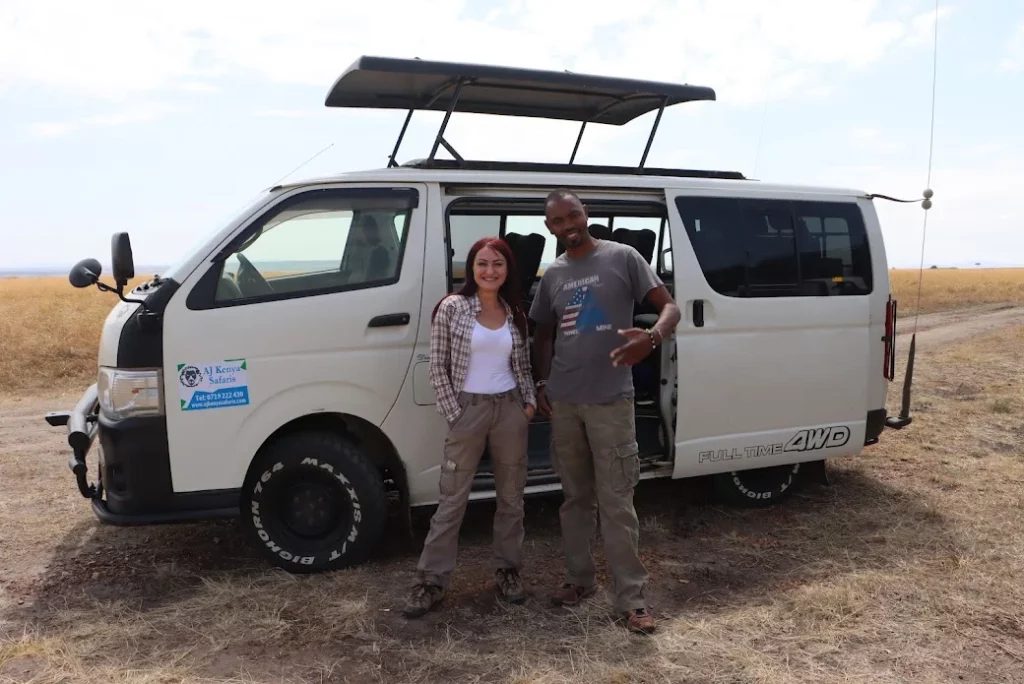
Kenya Safari Tours from Nairobi Cost – Accommodation
At the end of a busy day in the Kenyan Savannahs, you want to retire to a hotel that offers great amenities. These ranges from sumptuous meals, endless opportunities to connect with the local people, and top-of-the-line amenities such as free Wi-Fi, a swimming pool, and more.
So, here are the safari accommodation options available in our country.
Five-Star Hotels
The rooms go for anywhere between USD 500 and USD 1000 per night. But you can pay extra for additional space and luxurious amenities. This option is the closest you can get to world-class luxury. Our luxury Kenya safari packages offer accommodation in five-star hotels.
Four-Star Hotels
A room costs between USD 100 and USD 200 per night. That covers the bed and breakfast while the rest is on you. Expect nothing but decent services and facilities in these hotels.
Three-Star Hotels
The most affordable hotels in Kenya are pretty ragged, but they can go as low as USD 50 per night. You will get the basic amenities, a bed, and (hopefully) breakfast for the price.
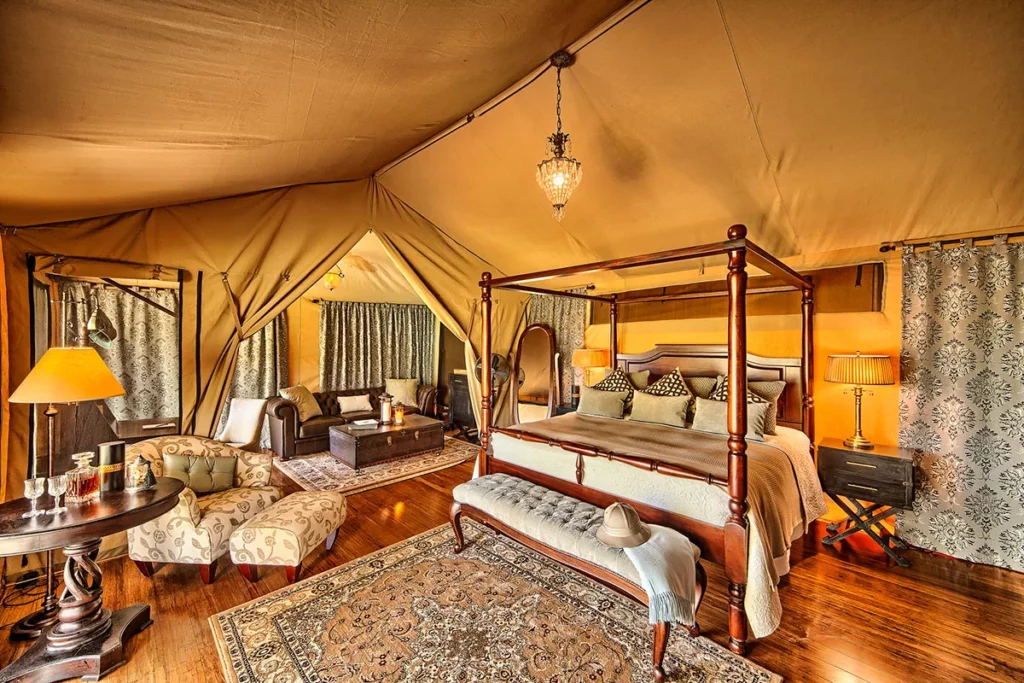
How Much Does a Kenya Safari Cost? – Cost of Meals
This part is where it gets exciting, considering that there are so many options. And everybody wants to eat at the end of the day. Shall we?
5 Star and 4 Star Hotels
A decent meal in these hotels cost around USD 20 to USD 200. These hotels offer the perfect mix of comfort, satisfaction, and value for money. Hotels in this category share what’s on the menu at a great time, and if you choose to, the cooks will gladly prepare a meal of your choice.
The staff is multilingual, and the menu includes both local and international cuisines.
Food Courts
Here, you can enjoy well-cooked meals for USD 5 – USD 20 per dish. For example, a meal at Burger Hut Nairobi will go for around USD 4.5. Kenchic Inn, a famous fast food joint, will charge you roughly USD 5 per dish. But the idea here is, fast food is way cheaper than good stuff.
Street Meals
Street food – usually a plate of rice or ugali with beans, vegetables, and sometimes a piece of meat – costs USD 5- USD 15. They are not quality meals, and the setting is also not so attractive. But Kenyans eat that all the time. We do not recommend this option for family travelers.
Cost of Drinking Out
A 500 ml bottle of beer costs between USD 1.2- USD 3, depending on the brand. But some joints sell them at USD 10 per bottle. Tusker is the flagship Kenyan Beer. Other options include the world-famous Guinness, Smirnoff, Jameson, and more.
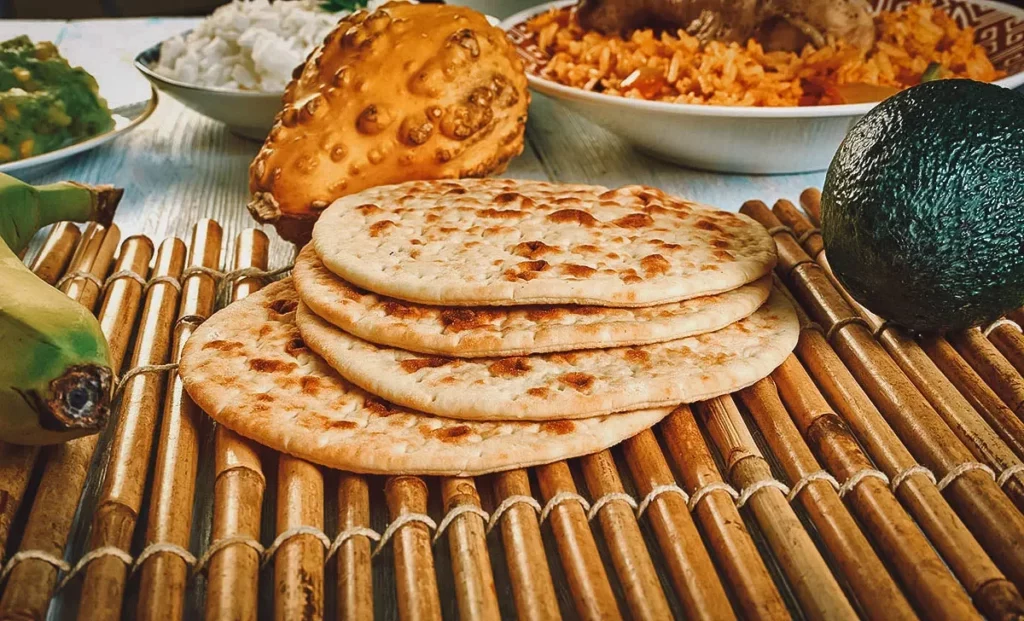
Masai Mara Kenya Safari Cost – Transport
Moving to Kenya has never been an issue. Some of the options here are super cheap and will still get you across the country.
Matatus (Public Service Vehicles)
Matatus (vans) are the most economical way of getting from one point to another in Kenya . Thanks to fluctuating fuel prices and other factors, the cost varies from time to time.
For example, a ride from Nairobi to Naivasha costs USD 5 on a normal day . But the price may go as high as USD 10 or more during peak hours. We do not recommend this option for international explorers.
Taxi & Uber
Most taxis in Kenya don’t have meters. So, it is wise to negotiate and agree on the cost before boarding. Alternatively, use premium taxis service providers such as Uber , Delight cabs, or Pewin Cabs.
Domestic Flights
Flying is the most expensive means of transport in Kenya, also the safest and the fastest. There are some attractive deals to be enjoyed on airlines, such as Fly 540, which charges around USD 70 for a one-way trip (Nairobi and Mombasa).
Jambo Jet, another local airline, charges as low as USD 30 for a one-way trip between Nairobi and Malindi . You will also get a cheap flight to Masai Mara from around USD 150 one way from operators such as Mombasa Air Safari.
Train services run from Nairobi to Mombasa, and plans are underway to take it further. The cheapest fare for Nairobi to Mombasa is USD 10 for the second class, while first-class costs USD 30.
Buses are usually in the range of USD 1 per hour. A bus ride to Mombasa from Nairobi will cost you anything between USD 7 – USD 15.
Safari Vehicles
Safari vehicles are modified and customized to make your African safari experience the most memorable one. The vehicles have been designed with the latest safety features and are equipped with enough space to accommodate all passengers.
In addition, they feature a small fridge and cooler for drinks and snacks to ensure you don’t go hungry or thirsty during your safari. They also provide comfortable seating and sun shades to help you relax in the hot African sun while enjoying the sights of Africa bush land.
You can get a safari vehicle with a professional tour guide from as low as USD 160 per day for the van and USD 250 per day for the safari land cruiser. These are the recommended vehicles for tourists.
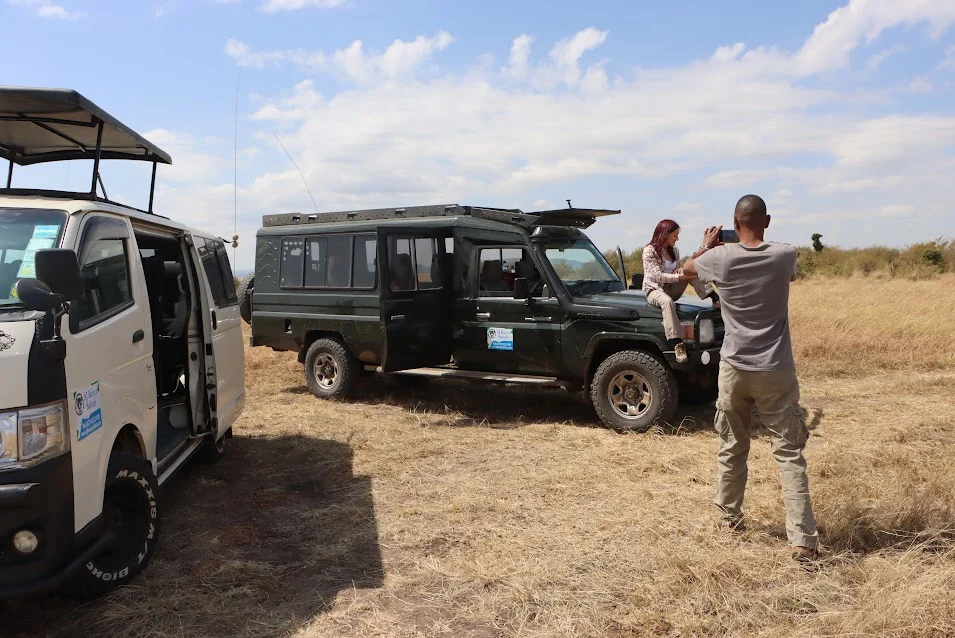
Where to Do Safari in Kenya Cost – National Reserve and Park Entrance Fees
Most parks are excellent choices for Kenya Budget Safaris . The entry fees depend on the season you visit and whether it is owned by the government or community. The cost can vary from as low as USD 20 for places such as Nairobi Safari Walk to as high as USD 110 for Ol Pejeta Conservancy.
Safari in Nairobi Kenya – 8 Things You Should Know for Budget Safari
When it comes to booking a holiday in Kenya, the safari capital of the world, the total Kenya safari cost is a must consider factor, and it is sometimes more than what meets the eye. Yes, we have seen it all. A USD 200/day safari that’s costlier than a USD 400/day safari, and USD 800/day cheaper than a USD 400 per day Kenya tour – when you consider the finer details.
Foreigners who want to book a holiday in Kenya are often overwhelmed by the sheer variety of Kenya safari packages on offer. I mean, if you scroll the web, you will see a 3 days Kenya safari package for USD 400 per person sharing, a 3 days Kenya Holiday package for USD 800 per person sharing, and so on.
My point here, the number of days you will stay in Kenya remains the same (3 days) in both offers, but the Kenya safari cost of one package is double that of the other. So, which package is cheaper?
Tight Budget? Here Are Some Saving Tips
- Find a group – Traveling alone can be quite boring and expensive. Opting for a group Kenya safari makes the trip fun. Also, it translates to shared traveling expenses. Everybody wants to save a few bucks.
- Book in advance – It might be tempting to think that planning on the go is more exciting than making prior arrangements. But on the contrary, it is more expensive. Consider finding a tour operator to help you make reservations in Advance.
- Is it Low Season or High Season? – Traveling to Kenya during the low season might seem economical – but it’s not. There is a big chance that you will miss the migrating wildlife and the excitement that comes with crowds. So, the best time is probably when the season is still young. Think of early July.
- Don’t Spend Nights in the Park – Ideally, prices in camps and hotels inside the national parks are exorbitant. You will pay at least 2-day worth of entrance fees even if you don’t intend to drive around the next day. Luckily, there are decent options close to all parks in Kenya.
- Consider Camping – Some parks provide travelers with the option to pitch tents in a designated area within the park. This option will save you tons of cash and bring you closer to the animals. Hell’s Gate National Park is an excellent example of such a place.
- Eat at the Driver’s Shop – It is obvious the hotel staff and safari drivers do not dine in those high-end hotels. So ask around, and you might get delicious meals at surprisingly low prices.
- Carry Packed Drinks/Food – Drinks and food are often overpriced, especially in those off-grid destinations. However, some safari packages might cover meals, but the surest way to save money is carrying your own food.
- Consider Traveling the Unbeaten Path – The not-so-popular parks will charge you less, yet you will see almost all of the wildlife found in the other parks. They are also smaller, so you might have an easier time spotting wild animals.
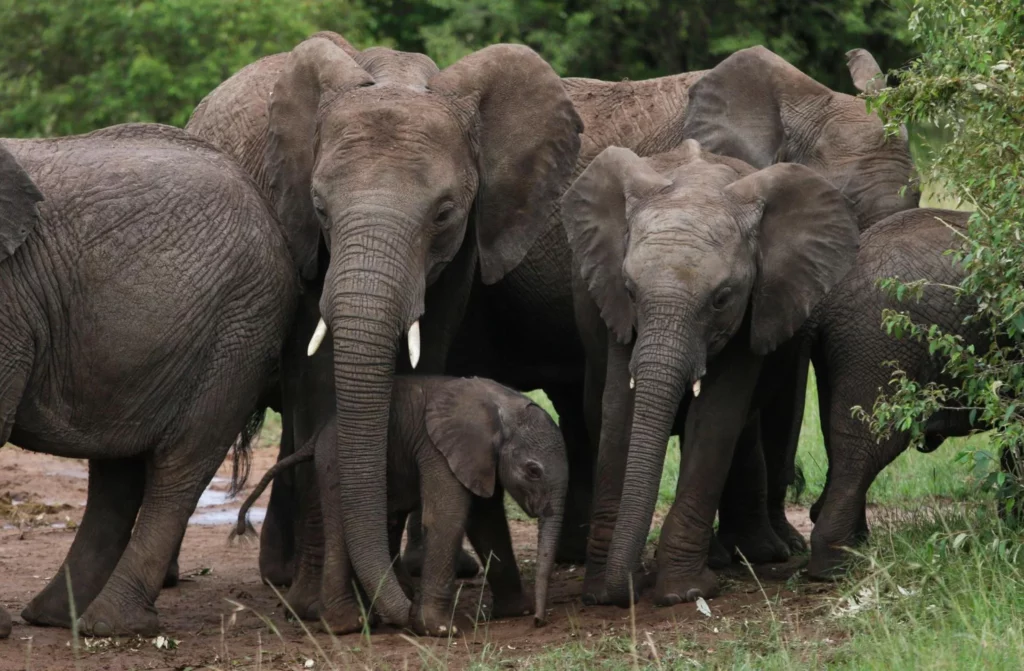
FAQs of How Much Does a Kenya Safari Cost?
To help you make an informed choice, let’s share 10 questions you need to ask your Kenya tour operator before buying the package .
1. What’s included in the Kenya safari package Cost?
Safari’s holidays in Kenya come in all shapes and sizes. You can go for budget Kenya safaris , including the bare minimum facilities, and you can also choose ultra-luxurious safari packages.
To make better sense of what you are paying for, it’s wise to ask about the components of the safari package. The standard definition of “all-inclusive” means the packages cover accommodation, food, transfers, park fees, and safari vehicles.
However, don’t assume that all that is included. Call your tour Kenya tour operator and make sure these costs are indeed included for the entire stay. For example, if food is covered, ask exactly which types of food are covered.
Some packages are labeled ‘all-inclusive,” but you are only covered for meals taken within the lodge, and you are expected to pay for alcoholic beverages and anything else you take while on the go.
Another trick used to hike the cost of a package is including airport transfers, while actually, no air safaris or transfers are involved. So, if that is an item in your package, ask where you will board the safari from and to where?
2. How much of the park can be accessed?
You need to clearly ask out the bounds of the park and the restrictions that come with it. Many budget safaris during your holiday in Kenya will give you a short car tour of the park and then drive you outside the park into some nearby hotel.
This would be unfortunate as you won’t be able to experience the quintessential safari ambiance that intensifies during dawn and dusk. However, if you are planning to buy a luxury package, you don’t need to worry about these restrictions.
Luxury travelers are often rewarded with the best camps and unlimited drive times inside the park, but it is always wise to confirm with your Kenya tour company.
3. Kenya Safari Cost – Will you be sharing the safari with strangers?
The most common problem associated with budget Kenya safari packages is that they tend to cram people of different backgrounds into the same trip. This can mean a disparate age-group or someone who doesn’t even speak your language.
Ask the tour agent to clarify how many people you will be traveling with and, if possible, prefer solo, personalized trips. Luxury safaris won’t pair you with strangers, and you can enjoy the freedom to explore the safari experience the way you like, instead of being dictated by the needs of others.
4. Who dictates the safari pace and objectives?
You will have to follow the crowd and routine of the safari experience in a budget safari. The biggest disadvantage of being in a budget group is that you won’t have much voice over the itinerary.
You can’t stay longer at a particular spot if you wish, and worse, you can return earlier if you wish. This is important because prolonged exposure to the equatorial sun can make foreigners uncomfortable. Inquire about such provisions and the full itinerary of the trip in detail.
A private safari with us lets you dictate your trip’s speed and is flexible to your needs. You can focus on any wildlife you want for as long as you want. Your needs won’t be bogged down by others.
5. How knowledgeable are the safari guides?
Budget safaris advertise their tours with over-the-top descriptions and then fail to deliver on a good local guide. This is also a problem with most international travel companies promising to bring you on tour to Africa.
A good guide will have a profound knowledge of various animals and bird species and instinctive knowledge of the behavior of animals, their feeding habits, their trials, and more.
They are also trained to spot distant birds and camouflaged animals. Training separates a lot of good guides from the bad ones, and you should ask for any certifications or government registrations if available.
6. How well equipped is the safari vehicle?
Safari Vehicles have a great deal of variety and are priced according to the facilities they provide. From mini-vans to rugged land cruisers to open hatchbacks, you can choose the vehicle that suits your style and budget.
In luxury packages, you can find air-conditioned vehicles with large recliner seats and even in-house refrigerators serving your favorite drinks. A budget safari will give you a seat and a window to look out at.
The minimum you should expect from the vehicle is to have proper cushions, proper mechanics, and proper communication types of equipment like CB radios, which are used to hone in on any major hunt or wildlife activity in the park.
It’s also necessary to carry safety equipment like first-aid boxes and tranquilizer guns in case of emergency situations.
7. How many souvenir shops will you be forced into?
The biggest problem with budget safari operators is that they survive off commissions rather than on their actual job of guiding – and this influences your Kenya safari cost. In this pursuit of cheap commissions on souvenir sales, the tour operators tend to take the tourists to pre-fixed shops, where the prices are automatically inflated.
The tour operators generally get a 10% cut on every purchase you make at their shop. Even worse, sometimes you can be tricked into buying cheap Chinese products. On the other hand, proper tourism agencies will ask you if you wish to buy souvenirs and then only take you to authentic places, where you can get better products and help the local community with their handicrafts.
8. What are the provisions for special interests?
Budget safaris are notorious for their apathy, and this can ruin your entire holiday in Kenya. If your expectations are low and you need a pretty generic ride of the savannah, then you can be satisfied with the budget safari packages.
However, if you wish to partake in additional activities like bird-watching, extra exploring, wildlife photography, small picnics, etc., then it’s best to inform your tour operator beforehand. Budget safari operators are strict on time and can disappoint you with their hastiness if you don’t inquire before.
So, make sure to inquire with your agency and know exactly what your Kenya safari cost covers. Alternatively, half the Kenya tour companies do all the essential bookings for you and opt for self-drive Kenya safaris. Luxury safaris are more personalized, and you can customize each of your activities according to your needs.
9. When to go on a Kenya safari?
Safari experiences depend on the weather, and so does the price. If you find yourself on holiday in Kenya in the rainy season, you can possibly ask for a lower price since the markets are low during that time.
March to May is the rainy season in Kenya, where you can get lower prices on most safaris and expect thinner crowds. When the safaris are booked to the brim and prices are sky-high, the equation changes during the winter.
10. Is the safari driver familiar with the English language?
On most safari trips, the driver will be your guide, and you should make sure that he can speak English to a communicable degree. Having a common language will give you a better perspective of their native culture and heritage.

We are travel. We are local. We are your wildest safari expectations fulfilled. We show you Kenya better than anyone.
Itineraries
- 3 Days in Masai Mara
- 4 Days Masai Mara
- 18 days Kenya Family safari
- 18 Days Kenya Safari
- 16 days kenya safari
- Diani Beach
- Amboseli Park
- Booking Terms and Conditions
More guides
- Mombasa beach
- Kenya Safari
- Kenya Photo safari
- Kenya wildlife safari
- Kenya Adventure
- Kenya Migration Safari
- Honeymoon Packages
- Kenya, Kiambu County, Ruiru Town Greec Towers, Office Number D7 and D8
- +254-704-532-105
- [email protected]
THREE WAYS TO PLAN AND BOOK YOUR SAFARI WITH AFRICANMECCA
TRAVEL & OPERATIONS OFFICES
- United States
- United Kingdom
Learn More On AfricanMecca Safari Tier Ratings & Experiences
Read More +
Special offers & discounted deals - kenya safaris (7 to 14 days).
ULTRA-LUXURY KENYA SAFARIS (5 TO 11 DAYS)
15 DAYS - ULTIMATE KENYA SAFARI
12 DAYS - BEST OF KENYA SAFARI
11 DAYS - NORTHERN KENYA & MASAI MARA SAFARI
11 DAYS - HIGHLIGHTS OF KENYA SAFARI
10 DAYS - KENYA LAND OF CONTRASTS SAFARI
9 DAYS - SOUTHERN KENYA SAFARI
8 DAYS - ACTIVE ADVENTURE KENYA SAFARI
7 DAYS - KENYA LAKES, VALLEYS & PLAINS SAFARI
7 DAYS - KILIMANJARO ELEPHANTS OF AMBOSELI & CATS OF MASAI MARA SAFARI
5 DAYS - BEST OF MASAI MARA SAFARI
4 DAYS - LAIKIPIA SAFARI FROM NAIROBI
4 DAYS - NORTHERN FRONTIER SAFARI FROM NAIROBI
4 DAYS - MERU SAFARI FROM NAIROBI
3 DAYS - MASAI MARA SAFARI FROM NAIROBI
3 DAYS - AMBOSELI SAFARI FROM NAIROBI
3 DAYS - CHYULU HILLS SAFARI FROM NAIROBI
3 DAYS - SAMBURU SAFARI FROM NAIROBI
3 DAYS - TSAVO WEST SAFARI FROM NAIROBI
2 TO 5 DAYS - TSAVO & AMBOSELI SAFARIS FROM MOMBASA
BALLOON SAFARI IN MASAI MARA
Contact and talk to our safari experts today to kick-start your tour planning process.
Request Kenya Custom Or Tailor-Made Safari Pricing Based On Your Specific Travel Dates At Your Preferred Safari Tier Camp Or Lodge
SAFARI PRICES FOR KENYA
Review individual itineraries and prices of our suggested Kenya safaris with the option of customizing your Africa tour based on your needs and preferences.
AFRICA TRIP IDEAS FOR KENYA
Review experiences available in Kenya from photo wildlife safari, horse and camel riding, walking, family to honeymoon beach vacation, dive, snorkel & fish etc.
PARKS & RESERVES IN KENYA
Review information on wildlife parks and reserves in Kenya i.e. Masai Mara, Amboseli, Samburu, Laikipia, Lewa, Tsavo, Chyulu, Nakuru, Meru and more.
ACCOMMODATIONS IN KENYA
Review information on safari lodges, camps, city hotels, coastal resorts in Kenya's pristine wilderness, cities, Swahili beach shores and idyllic islands.
BEST TIME TO VISIT KENYA
Review details on the best time to go to Kenya to visit its various wildlife outback, forests, rivers, islands, lakes, beaches, mountains and other wildernesses.
BEACHES & ISLANDS OF KENYA
Review Kenya's stunning Indian Ocean coast where the deep cobalt blue and turquoise waters gently wash up white sand beaches that create a tranquil setting.
KENYA COUNTRY PROFILE
Review country information and travel tips on Kenya i.e. geography, culture, history, climate, tipping guide, what to pack and wear, entry requirements and more.
CITY DAY TOURS FOR KENYA
Review city tour suggestions on full or half day options in Nairobi, Mombasa, Watamu, Lamu. Experiences can be customized around your vacation travels.
AFRICAN SAFARI PRICES
Check out safari prices and itineraries for parks and reserves in other African countries e.g. Tanzania, Uganda, Rwanda, Botswana, South Africa, Zambia etc. Namibia, Mozambique, Malawi and Zimbabwe are available on request.
AFRICANMECCA REVIEWS
On behalf of myself, my wife and my two adult daughters, I want to sincerely thank you and AfricanMecca Safaris for our fabulous recent safari to Amboseli National Park and Masai Mara National Reserve in Kenya.
Robert Schenkein - prVision Photography Studio - Colorado, United States
Dear Raza, The accommodations you recommended were superb. We loved them all -- Giraffe Manor, Wilderness Trails, Governor's Il Moran, Ngorongoro Crater Lodge and Mnemba Island Lodge.
Pat Bernard, Vice President, Global Channel Sales, Novell Corp - New Hampshire United States
Jambo Altaf and Raza! We are back on earth now after our fabulous honeymoon. This is to say THANK YOU so much for organising a week in Kenya that we will never forget.....!
Dr Krina Zondervan, Oxford University - United Kingdom
Jambo Raza!!! The safari trip was spectacular! Everything went off without a hitch. We loved the Masai Mara. The migration was awesome. You listened to what I wanted and delivered it perfectly.
Judi & Chaim Platt - Toronto, Canada
I cannot say enough about the quality of AfricanMecca. Their teams in Kenya and Tanzania were top notch. Raza, again thanks to you and your entire organization! We will be repeat customers.
Dan Kobick - Managing Director, PricewaterhouseCoopers - New York, United States
Jambo Raza, The Lake Nakuru outing was great! We saw lots of pelicans, some flamingos, both black and white rhino... We've already recommended a Kenya safari to friends and relatives. Thanks again
Scott Aaronson - Associate Professor, M.I.T - Boston, United States
This is to let you know my guests, The Bryant's, had a wonderful time on the trip Samburu, Masai Mara/Kenya, Chobe/Botswana & Victoria Falls/Zambia. Everything was perfect! Thank you..
Christine Milan - MT Carmel Travel - Connecticut, United States
East africa safari booking & tour holiday idea kenya, best safari planning ideas & trip experiences for kenya, 1. how to plan kenya safari trips (summary), 2. wildlife safari trip planning guide for kenya, 3. private & tailor-made safaris trip planning guide for kenya, 4. honeymoon safaris trip planning guide for kenya, 5. family safaris trip planning guide for kenya, 6. luxury safaris trip planning guide for kenya, 7. photo safaris trip planning guide for kenya, 8. cultural safaris trip planning guide for kenya, 9. primate safaris trip planning guide for kenya, 10. hike, trek & bush walk safaris trip planning guide for kenya, 11. birding safaris trip planning guide for kenya, 12. horseback riding safaris trip planning guide for kenya, 13. balloon safaris trip planning guide for kenya, 14. wedding safaris trip planning guide for kenya, 15. bush & beach safaris trip planning guide for kenya.
Kickstart Your Safari Planning
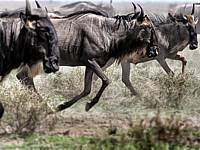
SAFARI PRICES
Find Kenya Safaris & Costs By Safari Tier Experiences
Safari Room Rate & Hotel Price Guide For Kenya
Kenya Reviews For Camps, Lodges, Beach & City Hotels
Park, Cities, Beach & Island Map Locations In Kenya
PHOTO GALLERY
Images & Pictures For Travel Destinations In Kenya
VIDEO GALLERY
Kenya Accommodation & Tour Destination Videos
ARE YOU PLANNING TO BOOK AN AFRICAN SAFARI TO KENYA?
Do You Need Knowledgeable, Experienced & Specialist Guidance For Your Travels In Kenya? Let Us Help Plan Your Trip Itinerary Correctly
EXPLORE MORE ON NATIONAL PARKS, CAMPS, LODGES, BEACHES & RESORTS IN KENYA
Safari tier ratings.
Understand Beach Tier Ratings & Experiences
KENYA PARKS & RESERVES
Kenya Beach & Island Planning Guide
KENYA LODGES & CAMPS
Beachfront Hotels & Resorts In Kenya
Top 10 Trip Reasons For Kenya Vacations & Holidays
HAVE YOU VISITED EASTERN AFRICA FOR A SAFARI IN KENYA?
Write A Travel Or Tourist Trip Review To Share Your Experiences
KENYA TRIP IDEAS
Safari Trip Ideas For Kenya
AFRICA SAFARI PRICES
Check Our Africa Travel Guide
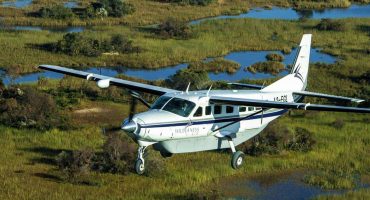
Baggage Guidance & Restrictions On Flying Safaris In Africa
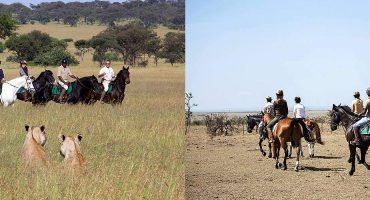
Masai Mara Horseback Riding Safari In Kenya With AfricanMecca

Times Square New York Hosts Kenya Tourism Board & Wilderness Safaris Meet Up
- Company Profile
- Why Travel With Us
- Our Safari & Tour Team
- Tier Ratings
- Awards & Press
- Customer Reviews
- SEARCH For Africa - Sustain & Conserve
- Travel Agent Support
- Jobs & Careers At AMS
- Newsletter Signup
- Contact Details
- Tanzania Travel Guide
- Kenya Travel Guide
- Uganda Travel Guide
- Rwanda Travel Guide
- Botswana Travel Guide
- South Africa Travel Guide
- Zambia Travel Guide
- Zanzibar Travel Guide
- Safari Trip Ideas
- Beach Trip Ideas
- Mountain Climb Trip Ideas
- Itinerary Trip Ideas
- Explore Park & Reserves
- Accommodations In Africa
- Read Trip Reviews
- View Photo Gallery
- View Video Gallery
- Read Our Blog
- Safari Prices & Itineraries
- Beach Prices & Itineraries
- Trek Prices & Itineraries
- City & Day Tours Prices
- Room Rate Guide
HOW TO CONTACT US
- +(256) 754 849 895
- [email protected]

Kenya Safari cost
Known as the birthplace of the African safari , Kenya is renowned as one of Africa’s top safari destinations, with incredible safari adventures like the Great Wildebeest Migration which stars millions of wildebeest, stunning scenery, and beautiful beaches, all of which contribute to the excellent safari experience that visitors have come to expect. Offering all types of safaris ranging from the Big five (elephant, buffalo, lion, leopard, and rhino), memorable birding experiences, and exploratory hiking trails, to mention but a few, Kenya offers the most exquisite, but yet most affordable safaris to travelers from all over the world.

Kenya offers all kinds of safaris ranging from luxury to midrange and budget African safaris, each with its distinctive package of services and benefits. Nevertheless, every Kenya safari package is designed to suit all kinds of travelers whether they are budget travelers or luxury travelers. However, when planning for Kenya Safari cost, one ought to know that Kenya is not a cheap safari destination.
Given the tourism experience Kenya has gained over the many years, Kenya safari prices are generally higher than in other African countries. A safari in Kenya might be expensive and not even luxurious. However, as there are so many ways of killing a rat, there are various ways of making sure that your Kenya safari is less costly but so fulfilling.
More so, a range of factors plays a role in your Kenya safari cost, including your safari budget, when you would like to travel, and where you want to go. Most visitors often inquire about the approximate cost of a Masai Mara safari and Amboseli National Park safari, as well as whether affordable Kenya safari packages are available. Here is a breakdown of our Kenya safari costs;
Budget Kenya Safari cost
Most of us want to save money wherever possible, and spending hundreds of dollars a day to look at animals may seem excessive. A quick-fix three-day safari from Nairobi to the Masai Mara , Tsavo, or Amboseli national parks can be had for just about US\$250 all in for a Kenya budget safari. Meanwhile, this price includes transportation from Nairobi, lodging, meals, and two game drives. It may, however, not include park admission. Well, sounds great, but there are a couple of major caveats that should make you approach bargain deals like this with extreme caution.
To begin with, most of these budget safaris are extremely rushed, and a three-day point-to-point safari leaving and returning to Nairobi will almost certainly only give you one day on safari.
This type of safari is almost always conducted in battered old minibusses that are uncomfortable and provide poor or obstructed views. This is especially true if the vehicle is fully loaded, and more so, half of the passengers may not have a window seat at all. These vehicles are frequently old, and breakdowns are common. Due to breakdowns, it is common to lose a significant amount of safari time – or even all of it.
Second, and this is not always a bad thing, accommodation on a budget safari will be in small dome tents set up on public campsites with no facilities other than a tap and a basic toilet block. Still, meals are prepared by the entire group and are frequently not what was promised. These safaris are always held in the main national parks and reserves, never in conservancies (from which they are banned).

National Park Entry fees
Kenya is one of the well-known Kenya safari destinations that visitors to the eastern part of Africa visit. Amboseli National Park, Lake Nakuru National Park, Nairobi National Park, Tsavo West National Park, Tsavo East National Park, Meru National Park, Aberdare National Park , and Kora National Park are among the national parks in this East African Republic.
Hells Gate, Mt Longonot, Mt Elgon, and Ol Donyo Sabuk are some of the scenic parks in Kenya that can be visited during safaris. Marsabit, Mwea, Ruma, Saiwa swamp, Sibiloi, Central Island, Kakamega, Shimba hills, Ndere island, Chyullu hills, South Turkana, and South Island national parks are among Kenya’s special interest parks.
The park entrance fee in Kenya often varies depending on whether the visitor is a nonresident, an East African citizen, or a Kenyan resident, and it also varies for children and adults as they visit different parks throughout Kenya.
Nonresidents visiting Amboseli and Lake Nakuru national parks during the low season pay a park entrance fee of 40 USD for adults and 70 USD during the high season, with children paying a fee of 20 USD in both seasons.
East African citizens and Kenyan residents are charged park entrance fees of 800 Kenya shillings in the high season and 600 Kenya shillings in the low season during safaris in Amboseli and Lake Nakuru national parks. The park entrance fee for children visiting Amboseli and Lake Nakuru national parks for safaris is 215 Kenya shillings, according to Kenya national park fees 2024.
Nonresident adults pay a park entrance fee of 40 USD in the low season and 60 USD in the high season, while children visiting Nairobi National Park pay a park entrance fee of 20 USD.
East African citizens and Kenyan residents who visit Nairobi National Park must pay a park entrance fee of 400 Kenya shillings in the low season and 500 Kenya shillings in the high season, while children must pay 215 Kenya shillings.
Nairobi National Park, located south of Nairobi, is Kenya’s only urban national park.
Another attraction in Kenya is the well-known Tsavo National Park. The park is divided into two sections: Tsavo West National Park and Tsavo East National Park.
East African citizens or Kenya residents visiting Tsavo west and Tsavo east national parks pay a park entrance fee of 500 Kenya shillings in the high season and 300 Kenya shillings in the low season, while children pay a park entrance fee of 215 Kenya shillings, according to Kenya national park fees 2022.
Nonresidents visiting Tsavo West and Tsavo East national parks must pay a park entrance fee of $60 in the high season and $35 in the low season for adults, with children paying a fee of $20.
The park entrance fees for Tsavo west and Tsavo east national park are similar to the park entrance fee charged during tours to Meru national park , Kora national park, and also Aberdare national park.

Accommodation on Kenya Safari cost
Safaris in Kenya with basic accommodations and no frills begin at around $200 per person, per day. A mid-range safari with lodging costs $350 to $400 per person, per day, while a top-tier luxury safari with lodging costs $600 to $1,000 per person, per day.
Accommodation options range from simple safari lodges to Luxurious tented camps .. International flights, visa fees, vaccinations, travel insurance, and other incidentals are not included in these figures.
Inbound transportation in Kenya
A taxi ride in Kenya is significantly more expensive than public transportation. Previous visitors to Kenya spent an average of KES3,443 per person, per day on local transportation. In Kenya, transportation between cities and towns costs an average of KES8,358. Prices vary depending on the length of the route, the mode of transportation used, and the date.
Meal costs in Kenya
While meal prices in Kenya vary, the average daily food cost in Kenya is KES2,858. Based on previous travelers’ spending habits, an average meal in Kenya should cost around KES1,143 per person when dining out. Breakfast is typically less expensive than lunch or dinner. Food prices in Kenyan sit-down restaurants are frequently higher than fast food or street food prices.
Cost of Entertainment and tips
In Kenya, entertainment and activities typically cost KES4,081 per person, per day. This includes admission fees to museums and attractions, day tours, and other sightseeing costs.
The average price for Tips and Handouts in Kenya is KES470 per day. The usual amount for a tip in Kenya is 5% – 15%.
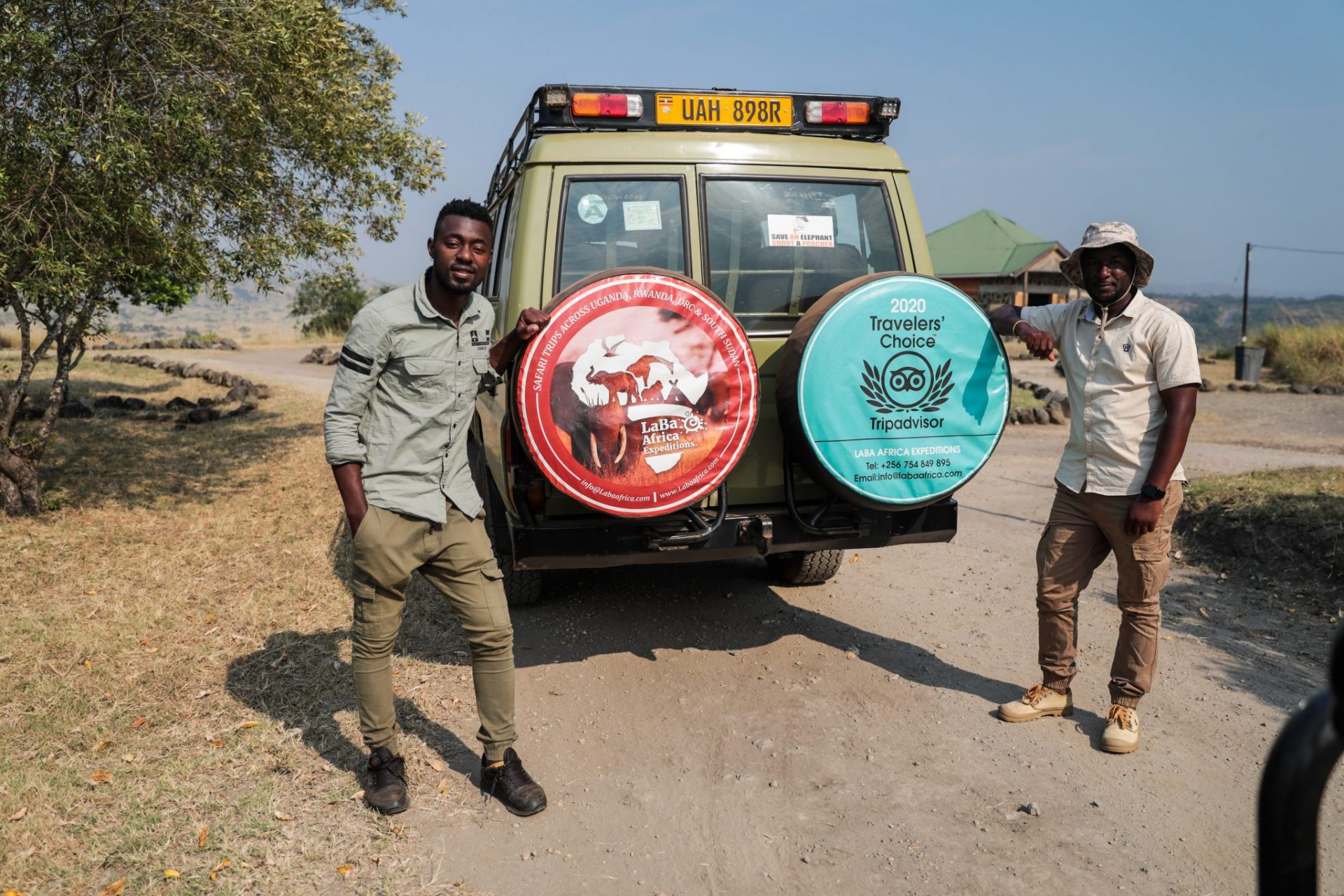
To many, an African safari is a once in a lifetime experience. Thats why we strive to me it remarkable
- Kampala Office
- Plot 2/4 Naguru Suwara Close
- P.O BOX 28320
- Nairobi Office
- View Park Towers, Utali Lane 14th Floor
- Nairobi Kenya
OUR DESTINATIONS
- South Sudan
OUR SERVICES
- Tailored Wildlife Safaris
- Gorilla Safaris
- Chimpanzee safaris
- Self Drive Safaris
©Laba Africa Expeditions 2024
Terms and Conditions
Your African Safari is a once in a lifetime experience, thats why we strive to make it perfect.
- 2477 Briercliff Road, New York 10001
- +1 212-203-7540
Join The club
Get updates on special events and receive your first drink on us!
Proceed Booking
Already a member.
Username or E-mail
Forget Password?
Don't have an account? Create one.

Typically replies within a day

Perfect 5 Day Kenya Safari Itinerary & Costs (6 unique Itineraries)
By Author Ella McKendrick
Posted on Last updated: 19 August 2024
I had high expectations of Kenya, a country that’s touted as one of the best places in the world to go on safari. Over my lifetime, I’ve watched countless wildlife documentaries set in Kenya and built up a picture in my head of a magical untouched wilderness.
I’ll be honest, I was worried that Kenya wouldn’t meet my expectations. But, would you believe me if I told you that it actually exceeded them?

I’ve had some of my best ever wildlife encounters in Kenya, from watching four cheetah cubs frolic about in the grass to witnessing a leopard feed right beside our vehicle on a freshly-caught gazelle.
Kenya houses a variety of national parks and reserves, each with something different to offer. The Masai Mara is renowned for its high density of big cats whereas Amboseli is home to some of the largest African elephant herds in the world.
With so much to see, you may be wondering if a 5 day safari is enough. Whilst you can easily fill out a 7-10 day Kenya safari itinerary , a 5 day safari is enough to see some of Kenya’s highlights. Within 5 days, you will have plenty of opportunities to witness some spectacular wildlife sightings.
In this article I’m going to walk you through my six favourite unique 5 day Kenya safari itineraries . I’ve put these itineraries together based on my own personal experiences whilst also considering distances between different locations so that you can spend as much time as possible on safari.
I’ll also give you an idea of how much each safari costs as well as recommendations on the best time to visit in order to get the most out of each itinerary. I’ll also give you some tips on how to make your safari run as smoothly as possible.

Embark on the Safari of Your Dreams
Save time and ensure an incredible safari experience by getting quotes from my recommended local safari companies
I’m here to make booking your perfect safari quick, easy and risk-free.
Join the rapidly growing tribe of over 250 travellers who’ve booked their dream safari using my insider tips and recommendations.
It takes under 60 seconds to fill out the form and in under 48 hours you will receive multiple, no-obligation proposals from my favourite local tour operators with glowing online reviews.
Get your free no-obligation safari quotes and my top safari tips and recommendations
In This Guide
5 day kenya highlights safari itinerary.
- 5 Day Western Circuit Highlights Itinerary
- 5 Day Eastern Circuit Highlights Itinerary
- 5 Day Northern Circuit Highlights Itinerary
- 5 Day Masai Mara Safari Itinerary
5 Day Safari & Beach Itinerary
Is 5 days enough in kenya, how to book a 5 day safari itinerary in kenya, private vs group kenya 5 day safaris, how much does a 5 day kenya safari itinerary cost, final thoughts.

Six different 5 Day Kenya Safari Itineraries
I’ve put together six different exciting safari itinerary options below.
These itineraries have been designed to help maximise your time on safari with the goal of seeing as much wildlife as possible. They focus on exploring two or three different parks thoroughly rather than ticking locations of a list.
The parks in Kenya are quite spread out and cannot all be visited within a 5 day safari. If you want to visit four or more parks then I’d consider a 7-10 day itinerary instead.

My two favourite places to go on safari in Kenya are the Masai Mara National Reserve and Amboseli National Park. Both destinations are fantastic for wildlife viewing and between them you can see all of the Big Five (elephants, lions, rhinos, leopards and buffalos)!
Visiting these two parks allows you to see the most wildlife. However, the distance between the two is great which means there is a day of lengthy travelling between them in the middle of this itinerary. If this drive is too arduous for you, there’s always the option to fly between the two.

Quick Facts
Average driving time: 4 hours per day
Best times of year: The long dry season between June and the end of September as well as the short dry season between December and the end of February.
Itinerary Map for Kenya Highlights Safari Itinerary

Day By Day Breakdown for Kenya Highlights Safari Itinerary
Day 1: masai mara national reserve.
Driving time (excluding game drives): 6 hours
You’ll kick-start your itinerary by journeying to Kenya’s most famous reserve. The Masai Mara National Reserve is renowned for its high density of big cats.
Additionally, it’s the setting of the annual wildebeest migration where millions of wildebeest cross the crocodile-infested Mara River in order to reach greener pastures.
This morning you will leave the energetic city of Nairobi and drive west into Kenya’s countryside. I’d recommend leaving early, around 7am or 8am so you can arrive in the Mara Mara in time for lunch.
On your 6 hour drive to the Masai Mara, you will have the opportunity to stop at the Rift Valley Viewpoint where you can admire panoramic views of the famous Great Rift Valley which stretches from Jordan to Mozambique.
You will have a second stop in the town of Narok, the last large town before the Masai Mara.
You’ll have a lovely hot lunch at your lodge in the Masai Mara before setting out on your first game drive of the trip.
About the Masai Mara National Reserve
The Masai Mara sits atop the border with the Serengeti National Park in Tanzania and is part of the wider Serengeti ecosystem. Together the two parks host the annual wildebeest migration, the largest mammal migration on earth.
Kenya hosts arguably the most anticipated part of the migration, the famous Mara River crossing, where millions of wildebeests risk their lives crossing the treacherous river that’s teeming with hungry crocodiles.
The migration takes place in Kenya between mid-July and mid-September.
The Masai Mara is also known for its high density of predators. Lions, cheetahs, leopards and hyenas can all be found in the reserve. If you’re keen to see leopards and cheetahs, the Masai Mara is the best place to see them in Kenya.

Tips for Your Afternoon Safari in the Masai Mara National Reserve
The afternoon is a great time to go on safari as it’s not as hot as in the middle of the day which means that the animals are more active. As evening approaches you’re more likely to see predators on the move.
I’d recommend staying on your game drive until the gates close at 6pm. Not only are the animals active at this time but the lighting is great for photos.
When on safari, it’s best to wear light neutral clothing. Dark colours such as navy blue and black attract tsetse flies which have a nasty bite. Wearing bright colours could be startling for the animals so neutrals are recommended.
Where to Spend the Night
Most lodges and tented camps are based near the town of Talek which is just outside the Masai Mara’s Talek Gate. This is a great location to stay as it’s just a short drive from your lodge to the gate.
There are a handful of lodges within the Masai Mara itself. These are however more expensive. If you have the budget for it however, I would recommend staying within the park as it allows you to go on safari before everyone else.
My Personal Experience in the Masai Mara National Reserve
I managed to view all of the Big Five within the Masai Mara. I encountered more lions than I can count and saw three groups of lions on separate kills. I witnessed a beautiful female leopard feed on a recently-killed gazelle just inches from our vehicle, stumbled across a rare black rhino and came across seven individual cheetahs, including four playful cubs.
The Masai Mara really really is a wildlife lover’s dream!
You can watch a video of my Masai Mara safari experience below.

Day 2: Masai Mara National Reserve
Driving time (excluding game drives): 0 hours
Today you have the opportunity to go on a full-day safari within the Masai Mara, maximising your chance of spotting the Big Five.
Wake up early so that you can depart for your safari as early as possible. You’ll ideally want to be at the gate at 6am so I recommend taking a picnic breakfast which you can eat within the reserve.
You’ll have to let your guide know about your plans to have a picnic breakfast and lunch beforehand so that the lodge has time to prepare it for you and so your guide can be ready to depart promptly in the morning. Let them know the day before, before the kitchen closes for the night.
Arriving in the reserve early gives you the maximum opportunity to try to find big cats, which are most active in the morning. This is the time of day when you are most likely to witness a hunt.
You’ll be able to enjoy your picnic breakfast in a scenic spot within the reserve at some point in the morning.
Your safari will commence and can last as long as you like. If you have the stamina I’d personally recommend having a full-day game drive and returning to your lodge shortly before the gate closes at 6pm. This means you’ll also have a picnic lunch within the park.
However, if you’d rather pace yourself, you can return to your lodge in the afternoon and enjoy a hot lunch there.
I wouldn’t recommend having two safaris broken up by lunch at your lodge as you have to pay each time you enter the park so this will double your costs for the day.

Tips for Your Full-Day Safari in the Masai Mara National Reserve
Mornings in East Africa can be quite chilly so you’ll want to layer up for your safari to avoid getting cold. In contrast, the middle of the day can get quite hot. I like to wear a vest-top, shirt and then jumper over the top. I can then take layers off as the day gets hotter.
Even when it’s cloudy, you can get pretty sunburnt on safari. Therefore I recommend wearing high factor sunscreen and applying it several times throughout the day.
You’ll also want to bring insect repellent with you. Like with the sunscreen, apply it before your safari and then you can top it up as required throughout the day.
Spend another night in your lodge or tented camp either within the Masai Mara or near the gate.

Day 3: Masai Mara to Amboseli National Park
Driving time (excluding game drives): 9 hours
Today you’ll leave the Masai Mara and journey to Amboseli National Park. The distance between the two locations is just under 500km and by road will take around 9 hours to complete.
If you decide to drive between the two then the journey will take up most of your day.
Alternatively, you can fly between the two destinations. Flights from Ol Kiombo Airstrip (the closest airstrip to Talek) run daily and typically take around 3.5 hours including a layover in Nairobi.
Flights cost around $400 per person and will involve you re-entering the Masai Mara again (additional $100-$200 per person depending on whether you visit in low or peak season) so this method of transport can get pretty pricey. Still, if you have the budget, I would recommend it so that you can enjoy more time on safari.
The below itinerary assumes you are travelling by road.
Leave your lodge in the Masai Mara no later than 8am.
The drive ahead of you will take roughly 9 hours excluding any stop-offs so you want to allow ample time for delays, whether that’s due to enjoying a leisurely picnic lunch or heavy traffic. You also want to avoid driving after dark as driving at night is far less safe than driving in the daytime; leaving at 8am reduces the likelihood of this.
You should arrive in Amboseli around 5pm.
Tips for Your Drive from Masai Mara to Amboseli
The drive between the two destinations is mostly on smooth tarred roads.
You’ll have the opportunity to stop on the journey for food and to use the restroom. Not every restroom is equipped with toilet paper so I recommend bringing some just in case.
I’d recommend bringing a neck pillow for the drive if you plan on sleeping and make sure your electronic devices have pre-downloaded audiobooks and music ready for you to listen to on your drive.
You’ll spend the night either near the gate to Amboseli National Park or within the park itself. If you are staying outside the park, ensure you’re in a lodge or tented camp near Amboseli’s Kimana Gate which is to the east of the park. This is the best gate to be based near as it’s close to where Amboseli’s elephants make their daily migration into the park.

Day 4: Amboseli
Driving time (excluding game drives): 0
Today you have the entire day to experience the magic of Amboseli National park!
Enter the park no later than 6:30am. This is important as between 6:30am and 7am Amboseli’s elephant herds journey from the forests below Mount Kilimanjaro to the swamp in the centre of the national park. Watching them make this journey is truly awe-inspiring as they pretty much surround you as they cross the road.
The elephants spend most of the day lounging in the swamp so if you want to view them up-close and in action, you’ll need to see them either early in the morning or in the evening when they leave the swamp.
Whilst the elephants are making their daily migration, they pass in front of Kilimanjaro, allowing for some stunning images of Amboseli’s two iconic giants within one frame.
After spending time marvelling at Amboseli’s elephants, you will continue your game drive within the park.
Amboseli operates by giving out a 24 hour pass which means you can enter and leave the park as many times as you like within the 24 hour period. Therefore you can either opt to have a picnic lunch within the park or return to your lodge for a hot lunch.
As Amboseli is a relatively small park, you can easily return to your lodge for a hot lunch. Additionally, Amboseli can get pretty hot in the middle of the day so wildlife viewing isn’t always fantastic around lunch time.
If you do decide to stay for a picnic lunch, your tour guide will take you to Observation Hill, a picnic site atop a hill with panoramic views of Amboseli National Park.
The late afternoon and evening is another fantastic time for a game drive in Amboseli. At around 5pm the great herds of elephants journey back to the forests below Kilimanjaro, giving you the opportunity to witness them on the move, crossing the road.
Leave Amboseli around 6pm, when the park closes, and venture back to your lodge for dinner.

About Amboseli National Park
Amboseli National Park is located in southern Kenya, just above the border with Tanzania. Mount Kilimanjaro, the highest mountain in Africa, towers over the park, providing a breathtaking backdrop.
The park is famous for being the last stronghold for Africa’s big tuskers, elephants with tusks so long that they nearly touch the floor. It’s a haven for African elephants, housing some of the biggest herds in the world.
In the dry season Amboseli is relatively barren apart from the swamps in the heart of the park. The swirling red dust makes Amboseli feel atmospheric.
The swamps provide a permanent water source for animals meaning that wildlife can be viewed in large numbers year-round.
Tips for Your Full-Day Safari in Amboseli National Park
It’s up to you whether you want to spend the full day in the park or if you want to return to your lodge at lunchtime for a hot meal. Both options will give you a good experience.
In order to make the most of your time in Amboseli, arriving in the park before 6:30am and leaving after 5:30pm is essential so that you can see the most wildlife. Not only do you see the large elephant herds on the move at these times but sunrise and sunset are also the best times to see predators in action. Lions, cheetahs and hyenas can be found in Amboseli.
Wear plenty of sunscreen for your safari and be sure to bring the bottle with you so that you can top-up accordingly.
Amboseli is one of the hotter safari locations in Kenya so you’ll want to dress for its hotter temperatures. Wear lightweight clothing made of materials such as linen.

You’ll spend another night in your lodge or tented camp near Amboseli National Park.
My Experience in Amboseli National Park
I had some of my absolute favourite safari experiences in Amboseli!
Witnessing Amboseli’s huge elephant herds cross the road just metres from your vehicle really is a jaw-dropping experience. Additionally, the sheer scale of elephants crossing is something to marvel at.
Although Amboseli isn’t particularly famous for its predators, I had some incredible big cat sightings in this park as well. Amboseli has a couple of resident lion prides. I spent a couple of hours with one of the prides, watching cubs of various ages frolic about and squabble over their mother’s milk – one of the cutest wildlife sightings I’ve had to date!
Another highlight for me was witnessing a female cheetah chase and successfully catch a Thomson gazelle. This is the first successful big cat hunt that I’ve seen and it didn’t disappoint. After gorging herself on most of the kill, a hyena came in and polished off the scraps.
Before I visited Amboseli a number of people told me that it was little more than elephants. I can tell you they’re wrong. When on safari there’s always something going on and you never know what sightings lie in store.

Day 5: Amboseli to Nairobi
Driving time (excluding game drives): 5 hours
Today you’ll leave Amboseli and journey back to Nairobi. Once in Nairobi, you’ll have the chance to explore more of the city.
Nairobi is between 4 and 5 hours away from Amboseli depending on the traffic. I’d recommend setting off no later than 8am so that you can be back in Nairobi in time for some lunch.
The drive to Nairobi involves journeying on smooth tarred roads. The majority of the highway is single carriageway so traffic can build up quite easily. Journeying earlier in the day increases your chances of skipping the traffic.
Once in Nairobi you can enjoy some lunch at one of the city’s restaurants. Nairobi has an array of fabulous restaurants. My absolute favourite is the Talisman Restaurant in Karen which serves Asian-inspired cuisine including sushi.
You then have the afternoon to explore Nairobi. Below are some of my best recommendations.
Best Things to Do in Nairobi
There’s a number of incredible things that you can do in Nairobi, from visiting one of Nairobi’s well-regarded wildlife sanctuaries to meandering through one of the city’s sprawling markets.
1. The Giraffe Centre
Located just 20 kilometres outside the heart of Nairobi is the Giraffe Centre, a sanctuary dedicated to the conservation of the rare Rothschild giraffe, whose numbers had plummeted to a mere 120 in recent years.
The sanctuary has introduced numerous breeding pairs into various parks across the country, including Lake Nakuru National Park, Mwea National Reserve, Ruma National Park, and Nasalot National Reserve.
Thanks to the efforts of the sanctuary, the number of Rothschild giraffes has surged from 120 to over 300 individuals.
Visiting the Giraffe Centre not only supports a worthy cause but also provides an enjoyable experience.
You can visit the Giraffe Centre and get the opportunity to meet and feed the resident giraffes. A visit typically takes between 1 and 2 hours.
Upon your arrival at the centre, you’ll receive a coconut shell filled with pellets that the giraffes absolutely love. You’ll then have the chance to feed these pellets to some of the sanctuary’s resident giraffes.

2. David Sheldrick Elephant Orphanage
The David Sheldrick Elephant Orphanage focuses on rescuing baby elephants from across Kenya, often victims of poaching or human-wildlife conflicts, with the ultimate goal of nurturing them and reintroducing them to the wild.
The orphanage boasts a commendable track record of successfully releasing numerous elephants back into their natural habitat.
Additionally, the trust actively contributes to anti-poaching efforts by funding units across Kenya. But that’s not all – in a bid to address the challenges of drought, the trust has also played a pivotal role in establishing permanent water sources in national parks to prevent wildlife from dying of dehydration in periods of drought.
A visit to the elephant orphanage, situated in Nairobi National Park, unveils the heartwarming spectacle of the daily feeding ritual for the baby elephants, scheduled between 11 am and 12 pm.
However, it’s important to note that advance booking is mandatory for this experience, and all necessary information can be conveniently accessed on the Sheldrick Wildlife Trust’s website .
3. Nairobi National Park
If you’re not done with safaris just yet, Nairobi has its very own national park which sits just below the city’s Central Business District.
Nairobi National Park is the only national park that borders a capital city and is one of the smallest parks in the whole of Africa, making it easy to explore in an afternoon.
Visiting the national park provides you with the unique experience of seeing wildlife in front of towering skyscrapers.
The park is home to all of the Big Five (lions, elephants, rhinos, leopards and buffalos).

Tips for Visiting Nairobi
I really loved my time in Nairobi. However, you should always be cautious when exploring large cities.
Like when visiting any major city, be mindful of your belongings and don’t display your valuables. I’d recommend wearing a bum bag / fanny pack which is harder for people to access and only go out with essentials (phone, passport and not huge amounts of cash).
I’d also avoid going out after dark as this is when both crime and car accidents are most likely to occur.
Most neighbourhoods in Nairobi are generally safe. There are however a few to avoid such as Eastleigh and Kibera.
Uber and Uber Eats are available in Nairobi which makes travelling and ordering takeaways very easy. I’d recommend using Uber over taxis as the rates are agreed upon before booking whereas taxis can change their rates.
There are a number of hotels and guesthouses available in Nairobi. I personally like booking Airbnbs. There are a number of highly rated Airbnbs available across Nairobi.
I’d recommend staying in Karen as it’s one of the nicest districts in Nairobi.
My Experience in Nairobi
I had a very positive experience in Nairobi. The city is very easy to get around due to the sheer amount of Ubers that are available and Uber Eats makes it easy to order meals or even food shopping right to your doorstep.
I personally felt safe in Nairobi. Everyone I met was extremely friendly and everywhere has high security. I didn’t however go out at night and opted to stay in Nairobi’s safer neighbourhoods.

For this itinerary you can expect the cost for a private safari for two people to start at around $380 per person per day.
This price covers park fees, hotels, all meals, vehicle and guide hire, fuel and drinking water for the duration of your safari.
The bulk of any safari cost comes from the park fees. The second highest cost is the hotel which typically includes full board.
I want to give you an idea of the cost breakdown below.
The cost to enter the Masai Mara is $100 + 18% tax per person per day from January to June and $200 + 18% tax per person per day from July to December. Amboseli’s park fees are slightly lower at $80 + 15% tax per person per day from April to June and $100 + 18% tax per person per day for the rest of the year.
Based on this itinerary for 2 people, the park fees alone will be $300 per person when visiting in the first half of the year or $1,000 per person when visiting in the second half of the year.
For a budget hotel near the Masai Mara you would be looking at a minimum of $100 per night per room. However, for a hotel that’s in a prime location near the gate you can realistically expect to pay more.
You then have your vehicle and guide hire to pay for.
Due to the high cost of the park fees, local tour companies don’t typically make much profit on the safaris – around 10% – 15% and much of this is offset against the special trade prices they receive for accommodation, so they end up working out very cost effective.
Recommended Booking Options For Your 5 Day Kenya Highlights Safari Itinerary
Private Safari
Most popular & best experience – typical prices for this itinerary start from $380 per person per day.
Visit safarisbyella.com for free quotes from trustworthy local tour companies I use to book my own trips.

Group (Shared) Safari – Usually Camping
Good for budget or solo travellers – from $300 per person per day.
My recommended Tanzania tour operators only provide private safaris, however, I’ve listed the best and most similar group options for this itinerary, on SafariBookings below.
There are no group tours that follow this exact itinerary but there are some that follow a similar itinerary that includes either Lake Naivasha or Lake Nakuru. However, there are no budget options available. The group tours listed below are mid-range.
Click the link below to request quotes for the group safari options on the SafariBookings website.
5-Day Group Safari to Masai Mara, Amboseli and Lake Nakuru
5-Day Group Safari to Masai Mara, Amboseli and Lake Naivasha
6-Day Group Safari to Masai Mara, Amboseli and Lake Naivasha
View All My Recomended Group Options Following a Similar Itinerary
Jump back to the table of contents to select another 5 day itinerary to view or keep scrolling to read the next itinerary.

5 Day Western Circuit Highlights Itinerary
Kenya’s safari destinations can be split into three different circuits: the eastern, northern and western circuits. Selecting a circuit would be preferable above the above 5 day Kenya highlights safari option if you wanted to cut-down on driving time.
The eastern circuit is made up of the Masai Mara, Lake Naivasha and Lake Nakuru. It’s arguably the most popular 5 day itinerary as it includes Kenya’s flagship park and doesn’t include too much driving.
On this itinerary you will get to spend two nights in the Masai Mara as well as a night in Lake Naivasha and a night in Lake Nakuru.
The combination of these three parks will give you the opportunity to potentially spot all of the Big Five.

Average driving time: 3.3 hours per day
Itinerary Map for 5 Day Western Circuit Highlights

Day By Day Breakdown for 5 Day Western Circuit Highlights
You’ll kick-start your itinerary by visiting Kenya’s most famous reserve – the Masai Mara. It’s one of the best places in the country to view Kenya’s big cats.
You’ll leave Nairobi in the morning, ideally between 7am and 8am and journey to the Masai Mara. The drive will take around 6 hours and can be broken-up by a couple of stops on the way, including to the Rift Valley Viewpoint.
You should arrive at your lodge in the Masai Mara in time for a hot lunch at around 2pm.
You then have 2 options for your afternoon. You can go on an afternoon game drive within the reserve. The late afternoon is one of the best times to try to catch predators in action. I’d recommend staying in the reserve until it closes at 6pm.
Alternatively, you can visit a nearby local Maasai tribe and learn about their culture.
As you have to pay an entrance fee each time you enter the Masai Mara, visiting the Maasai tribe would be the most cost-effective option if you’re on a tight budget.
You can then return to your lodge for some dinner.

About the Masai Mara
The Masai Mara is one of the largest game reserves in Kenya, stretching for 1,510 square kilometres (580 square miles).
It’s named in honour of the Maasai tribe who call the area surrounding the reserve their home. Additionally ‘Mara’ means spotted in the Maasai language, a description of the plains which are spotted with the occasional acacia tree.
The Masai Mara houses an extremely high density of big cats, especially lions. Therefore it’s one of the best places in the country to catch a glimpse of them.
The Masai Mara also houses the great wildebeest migration between mid-July and mid-September. Visitors can expect to see large numbers of them dotting the plains and if you’re lucky, you can even witness them crossing the treacherous Mara River.
Tips for Visiting the Masai Mara
The Masai Mara hosts tsetse flies which give a nasty bite. To avoid getting bitten it’s advisable to wear light coloured clothing. Blacks and navy blues attract the pesky flies. Also wear insect repellent and remember to top it up throughout the day.
The best time to go on safari is either early in the morning or late in the afternoon. The cooler temperatures make animals more active, particularly the Masai Mara’s predators.
I’d recommend spending the night in a lodge or tented camp that’s either within the Masai Mara itself or very close to one of the gates.
Talek is a great area as it’s very close to the Talek Gate and you can find a number of lodges here.
The lodges in the reserve itself are luxury lodges so if you are going on a budget or mid-range safari, Talek is a great option.
My Masai Mara Experience
You can watch a video of my experience in the Masai Mara below.

Today you have a full day to go on safari in the Masai Mara.
Start the day bright and early. You’ll want to start your safari so you can be at the gate to the reserve at 6am. By entering early, you are increasing the chances of seeing the Masai Mara’s predators on the move.
Today you’ll be going on a full-day safari. As a result, you’ll want to arrange with your guide and lodge the night before to have a picnic breakfast and lunch for your safari.
You can stay on safari as long as you like. I’d recommend staying until the gates close at 6pm but you can leave early if you’re feeling tired.
You’ll then have a nice hot dinner at your lodge.
Tips for Your Full-Day Safari in the Masai Mara
You’ll want to bring sunscreen and insect repellent with you on your safari so that you can top-up accordingly. Even in cloudy weather you should wear high factor sunscreen.
Remember to wear light-coloured clothing so that you don’t avoid the biting tsetse fly.
I’d also recommend wearing a number of layers for your safari. The early mornings can be cold so you’ll want to wrap up warm. Then as the day gets warmer you can discard layers. I tend to wear a vest top, shirt and jumper.
Spend another night near the Masai Mara National Reserve.
My Experience Visiting the Masai Mara
The Masai Mara definitely lives up to its reputation as being one of the best safari destinations in the world.
On my Masai Mara safari I was able to view all of the Big Five (lions, elephants, leopards, rhinos and buffalos).
A highlight for me was witnessing a leopard enjoy a freshly-caught impala just inches away from our vehicle. I also witnessed a huge male lion feast on a buffalo right beside the road. Another magical moment was encountering a mother cheetah and her four energetic little cubs.

Day 3: Lake Naivasha
Lake Naivasha is a large freshwater lake that is known for its high density of hippos. It’s a great place to go on a boat safari.
Aim to set-off from your lodge near the Masai Mara at around 8am.
After around 5 hours on the road you should arrive at Lake Naivasha in time for some lunch. You can enjoy lunch either at your lodge or at a picnic site.
For the afternoon you can take to the lake in a boat. This is a great opportunity to see hippos up close as well as an array of birdlife.
You can opt for a walking safari on Crescent Island which lies within the lake. Here you can see a number of herbivores including zebras, gazelles and giraffes.
About Lake Naivasha
Lake Naivasha is the highest lake within the rift valley, sitting at 1884m above sea level. The lake is 13km in length but is only 5 metres deep.
Lake Naivasha is a bird lover’s dream, housing 400 different species including flamingos, eagles and much more.
There are a number of lodges near the southern shores of Lake Naivasha where you can spend the night.

Day 4: Lake Nakuru
Driving time (excluding game drives): 2 hours
Not far to the north of Lake Naivasha lies another lake: Lake Nakuru. This soda lake is famous for its high concentration of flamingos and for being a sanctuary for both black and white rhinos.
Depart from Lake Naivasha at around 8m in order to arrive at Lake Nakuru by mid-morning.
You can then go on a walking safari in Lake Nakuru National Park before enjoying a picnic lunch.
For the afternoon, go on a game drive in Lake Nakuru National Park. This is a great opportunity to try to spot the park’s famous residents, namely the protected black and white rhinos.
You’ll then have dinner at your lodge.
About Lake Nakuru National Park
Lake Nakuru is a saltwater lake within the Rift Valley. The high salt content attracts over a million flamingos to the lake each year as it’s the perfect place for them to feed on blue-green algae, a meal that makes their feathers pink in colour.
Lake Nakuru is surrounded by a national park. Unlike many parks and reserves in Kenya, Lake Nakuru National Park is enclosed by 3 metre-high fencing which was erected to help protect the species that reside in the park.
You can find four of the Big Five in Lake Nakuru: lions, leopards, rhinos and buffalos.
Lake Nakuru National Park is one of the best places in Kenya to see both the black rhino and white rhino. Within the park is a sanctuary which introduced its first 2 rhinos to the park in 1984. Today the park has over 150 rhinos.
Within the park you can also find the rare Rothschild giraffe, another species that was re-introduced after experiencing a devastating country-wide decline.
There are a number of lodges where you can spend the night either within Lake Nakuru National Park itself or within nearby Nakuru town.

Day 5: Lake Nakuru to Nairobi
Driving time (excluding game drives): 3.5 hours
Today you’ll journey back to Nairobi. You can then spend the afternoon exploring this lively city. There’s a plethora of things to do here, some of my favourites include visiting The Giraffe Centre and Nairobi National Park.
Leave Lake Nakuru at around 9am or 10am so that you can arrive in Nairobi in time for some lunch.
There are a number of delicious restaurants within the city. My favourite restaurant can be found in the Karen region and is called Talisman Restaurant . It’s one of the highest rated reviews in the city and serves Asian-inspired cuisine.
This afternoon you can spend your time in Nairobi as you wish. Perhaps that’s spending a couple of hours with the giraffes at The Giraffe Centre or going on one last safari in Nairobi National Park.
I loved my time exploring Nairobi! There’s so much to see here and everyone I encountered in the city was extremely friendly.
However, as with any visit to a bustling city it’s wise to be vigilant about your belongings and avoid conspicuous displays of valuables. I suggest using a bum bag or fanny pack, which is more secure and only venturing out with essentials such as your phone, passport, and a small amount of cash.
Additionally, it’s advisable to refrain from going out after dark, as this is when both criminal activities and traffic accidents are more likely to occur.
There are a number of hotels and Airbnbs where you can spend the night in Nairobi. I personally prefer Airbnbs as they are slightly cheaper and I love the personal touches you get with them.
When choosing a hotel or guesthouse, opt for one in a safe neighbourhood such as Karen.

This itinerary will be a similar cost to the first itinerary as the park fees are similar. You are still visiting Masai Mara which has the highest park fees. Lake Naivasha and Lake Nakuru are cheaper to visit but as you will be visiting parks on all days apart from the final day (for itinerary 1 there was a day of driving), the costs end up being similar.
For this itinerary you can expect the cost for a private safari for two people to start at around $350 per person per day.
You can reduce this cost by not going on a game drive in the Masai Mara on the first day and opting to visit a Maasai village instead. This will save you paying for park fees for that afternoon which cost $100 + 18% tax per person between January and June and $200 + 18% tax per person between July and December.
The bulk of the safari cost is made up by the park fees.
Recommended Booking Options For Your 5 Day Western Circuit Highlights Itinerary
Most popular & best experience – typical prices for this itinerary start from $350 per person per day.
Good for budget or solo travellers – from $187 per person per day.
5-Day Group Camping Eastern Circuit Safari Itinerary
5-Day Group Budget Eastern Circuit Safari Itinerary (Option 1)
5-Day Group Budget Eastern Circuit Safari Itinerary (Option 2)

5 Day Eastern Circuit Highlights
The Western Circuit takes you to the best national parks in the south west of Kenya.
Amboseli National Park, renowned for its huge population of elephants, will be your first stop.
You’ll then visit Tsavo West National Park, part of Tsavo, the largest national park in Kenya. This park is known for its mountainous landscape and is a great place to spot black rhinos.
The itinerary ends back in Nairobi.

Average driving time: 3 hours per day
Best times of year: The long dry season between June and the end of September.
Itinerary Map for 5 Day Eastern Circuit Highlights

Day By Day Breakdown for 5 Day Eastern Circuit Highlights
Day 1: amboseli national park.
You’ll kick-start your 5 day itinerary by visiting my favourite national park in Kenya, Amboseli.
Amboseli is home to some of the largest herds of elephants in the world. Additionally, it’s one of the best places to get a view of Mount Kilimanjaro.
You can view many other animals in Amboseli too, including lions, cheetahs, giraffes, zebras and much more.
Leave Nairobi at around 8am. The earlier you leave, the less likely you are to get caught-up in traffic.
The journey will take roughly 5 hours although this time can fluctuate depending on traffic. Much of the drive involves journeying down a single-lane highway so your journey time is heavily dependent on how busy the road is.
You should arrive in Amboseli around lunchtime. I’d recommend having a hot lunch at your lodge.
For the afternoon you will go on your first game drive. Be sure to stay in the national park right until it closes at 6pm. This is because at around 5pm the large elephant herds are on the move and cross the road in the park to journey towards the forests below Mount Kilimanjaro. It’s one of the best times to view the elephants.
After your game drive, return for some dinner at your lodge.
Originally a game reserve, Amboseli was established as a national park in 1974 and was later declared a UNESCO World Heritage site in 1991.
Amboseli is one of the more popular national parks in Kenya. Visitors are drawn by the unique landscape, which is towered over by Mount Kilimanjaro, as well as the park’s resident elephant herds.
The park is surrounded by the Masai tribe who are to thank for the park’s high density of elephants. Their presence in the area has deterred poachers as the Masai have a fearsome reputation and thus allowed elephants to thrive.

Tips for Visiting Amboseli National Park
The best times to see Amboseli’s elephants are early in the morning and late in the afternoon. This is when they journey to and from the swamp within the heart of the park. In the middle of the day, they relax in the swamp and sightings aren’t as good.
Amboseli National Park can get pretty hot. Daytime temperatures are typically between 20°C and 30°C. You’ll therefore want to wear light clothing that keeps you cool.
Wear plenty of high factor sunscreen and insect repellent for your safari.
If catching a glimpse of Kilimanjaro is important to you then you’ll want to visit Amboseli within the long dry season, between June and late-September, when there are less clouds. Viewing the mountain is never guaranteed but you will certainly increase your chances by visiting at this time of year.
There are a small number of lodges within Amboseli National Park. You can either spend the night here or in one of the many lodges which are just outside Amboseli’s Kimana Gate.
Kimana Gate is the closest gate to where the elephants typically cross to and from the swamps so this is the best gate to be located near.
I’ve had some of my best safari experiences in Amboseli National Park!
Witnessing the huge herds of elephants cross the road to and from the swamp is truly magical. It’s crazy how close to the vehicles they can get and seeing so many of them at once really is a sight to behold.
Elephants are not the only residents that you can hope to encounter. I was delighted to stumble across a pride of lions with very young cubs. Watching the cubs play filled me with joy.
I also witnessed three cheetah hunts in Amboseli, two of which were successful.

Day 2: Amboseli National Park
Today you have a full day to explore Amboseli National Park.
Rise early in order to start your game drive at 6am, when the park gates open. Entering early gives you the highest chances of witnessing the elephants cross over to the swamp.
You’ll then meander through the park, keeping an eye out for Amboseli’s varied inhabitants.
At lunchtime you will stop at Observation Hill, the only area within the park where you can leave the vehicle. You can enjoy your picnic lunch at the top of the hill where you will have wonderful uninterrupted views of Amboseli National Park.
Amboseli issues 24 hour passes for the park so you’ll end your safari at the same time that you entered the previous day which will be around 3pm.
You can then spend the rest of the afternoon relaxing at your lodge.
Tips for Your Full-Day Game Drive in Amboseli
In order to get the most out of your safari, you’ll need to bring a picnic lunch with you. You’ll just need to let your guide know the night before so that he can inform the lodge.
Bring plenty of sunscreen and insect repellent with you so you can keep applying both throughout the day.
You’ll want to bring a cap or sunhat with you as it can get pretty hot and sunny.
You’ll spend another night in or near Amboseli National Park.

Day 3: Tsavo West National Park
Driving time (excluding game drives): 4 hours
Today you’ll move to another of Kenya’s beautiful national parks.
Tsavo West is one of the largest national parks in Kenya. When combined with Tsavo East, the two make up the biggest park in the country. In Tsavo West you can find all of the Big Five (elephants, lions, leopards, rhinos and buffalos).
It’s around a 4 hour drive to Tsavo West so I recommend setting off early. Leaving Amboseli at 8am allows you to arrive at Tsavo West at lunchtime.
You can enjoy either a picnic lunch in a scenic lunch spot or have a hot lunch at your lodge in Tsavo West.
After lunch you will go on an afternoon game drive within the national park.
Tsavo West is an extremely diverse park when it comes to terrain. It has mountains, forests, grasslands, caves and volcanic springs.
The park is also home to a wide range of wildlife. You can view all of the Big Five here as well as giraffes, cheetahs, hyenas and more. The park also houses a number of critically endangered species such as Grevy’s zebra, wild dogs and black rhinos.
Tsavo is famous for the notorious man-eaters of Tsavo, two lions who killed dozens of railway workers in 1898.
One of the highlights of Tsavo West National Park is Mzima Springs, an oasis of four pools in the western part of the park. The water comes in from underground streams from the Chyulu Hills. A large number of hippos call this oasis home.
Tips for Visiting Tsavo West National Park
Like with all safaris, remember to wear light neutral colours to avoid attracting tsetse flies. Blacks and navy blues should be avoided.
Bring plenty of sunscreen and insect repellent on game drives with you so that you can reapply where necessary.
There are a number of lodges surrounding Tsavo West where you can spend the night.

Day 4: Tsavo West National Park
Today you will spend the full day on safari in Tsavo West National Park.
This morning you will leave on a full-day safari within the national park. I recommend entering the park at 6am when the park opens.
You’ll then spend the morning searching for Tsavo West’s many animals.
I’d recommend having a picnic-lunch part-way through your safari instead of returning to your lodge for lunch due to the vast size of Tsavo West. This enables you to journey deeper into the park.
Tsavo West has 24 hour passes so you will leave the national park in the early afternoon, giving you some time to rest at your lodge.
Tips for Your Full-Day Game Drive in Tsavo West
As you’ll be having a picnic lunch for your day in Tsavo you’ll need to let your guide know the day before so he can place the order with your lodge.
Bring sunscreen, insect repellent and a cap or hat for your game drive.
You’ll spend another night near Tsavo West National Park

Day 5: Tsavo West to Nairobi
Driving time (excluding game drives): 6.5 hours
Today you’ll leave Tsavo West and journey back to Nairobi in time for some lunch in the city. You can then spend the afternoon either exploring Nairobi or relaxing.
This morning you’ll depart from Tsavo West and journey back to Nairobi. I’d recommend leaving at 7am or 7:30am so that you can be back in Nairobi in time for some lunch.
There are a number of delicious eateries in Nairobi for you to enjoy. My personal favourite is Talisman Restaurant in Karen. It serves a range of Asian-inspired dishes and the setting is lovely.
You can spend the afternoon as you wish. This may be exploring or simply relaxing. If you opt to explore, a visit to the Giraffe Centre or even an afternoon safari in Nairobi National Park are great options.
Nairobi is a bustling capital and like with any major cities, you have to be careful about your belongings. I’d recommend only going out with minimal valuables and cash. These are best kept in a fanny pack or bum bag. Also don’t put any valuables on display.
I’d avoid going out at night as the roads can get quite hectic and this is also when crime is most likely to occur.
You can use Uber to easily get around the city and Uber Eats is a great option if you want to order a delivery service.
I personally really enjoyed my time in Nairobi!
There are a number of hotels and Airbnbs available in Nairobi. I always personally prefer Airbnbs as they are often cheaper and I love the personal touches you get. There are a number of highly-rated Airbnbs available in Nairobi. I’d recommend booking one in one of Nairobi’s nicer areas such as Karen.

This itinerary is slightly cheaper than the previous two itineraries as you won’t be visiting the Masai Mara, the most expensive safari destination in Kenya.
For this itinerary for two people you can expect to spend around $270 per person per day. This cost will be less if you are travelling in a larger group.
This price assumes booking with a local safari company. The costs will be higher if you opt for mid-range and budget accommodation levels.
It costs $100 + 18% tax per person per 24 hour period to visit Amboseli National Park. Park fees are similar for Tsavo West National Park.
Recommended Booking Options For Your 5 Day Eastern Circuit Highlights Itinerary
Most popular & best experience – typical prices for this itinerary start from $270 per person per day.
Good for budget or solo travellers – from $250 per person per day.
5-Day Group Budget Western Circuit Itinerary

5 Day Northern Circuit Highlights
Northern Kenya is very different from the rest of the country. Here you can find many rare species of animals such as Grevy zebra, Somali ostrich, Reticulated giraffe, gerenuk and the Beisa oryx.
The Northern Circuit isn’t anywhere near as popular as the Eastern and Western Circuits but in my opinion it’s extremely underrated. The fact that it’s not as popular is a big plus point as it means the parks and reserves that you visit won’t be as busy.
Kenya’s Northern Circuit visits Ol Pejeta Conservancy, the largest black rhino sanctuary on earth. This conservancy is also home to the world’s two last remaining northern white rhinos.
Next on this 5 day itinerary is Samburu National Reserve, home to the Special Five listed above. The reserve also houses all big cats (lions, leopards and cheetahs) as well as over 350 species of bird.
You’ll then visit Lake Nakuru, one of the best places to see both the black and white rhino.
Finally you’ll visit Lake Naivasha, a great place to see hippos up-close.

Average driving time: 3.5 hours per day
Itinerary Map for 5 Day Northern Circuit Highlights

Day By Day Breakdown for 5 Day Northern Circuit Highlights
Day 1: ol pejeta conservancy.
Driving time (excluding game drives): 4.5 hours
You’ll kick-start your itinerary by visiting Ol Pejeta Conservancy, home to the world’s two last remaining northern white rhinos.
Today you’ll leave Nairobi and journey to Ol Pejeta Conservancy which is around 4.5 hours north of Nairobi, in the foothills of Mount Kenya.
I’d recommend leaving Nairobi at around 8am so that you can arrive in Ol Pejeta in time for a hot lunch at your lodge.
After lunch you will go on a game drive in Ol Pejeta Conservancy. This is one of the best places in the world to see black rhinos and white rhinos. You can also expect to see elephants and giraffes here. Request to drive through the endangered species enclosure as this is where you can find the last remaining northern white rhinos.
Alternatively, you can go on a walking or horse riding safari.
You’ll return to your lodge after your game drive for some dinner.

About Ol Pejeta Conservancy
Ol Pejeta is a 36,400-hectare non-profit conservancy that’s renowned as the best places to see rhinos in Kenya.
The conservancy has a 283-hectare endangered species enclosure that’s fenced to protect the animals within it from poachers. It’s here where you can find the world’s last remaining northern white rhinos as well as the rare Grevy’s zebra and Jackson’s wildebeest.
Ol Pejeta also has a chimpanzee sanctuary that you can visit. This is the only place where you can view chimpanzees in Kenya.
The conservancy has fitted its resident lions with radio collars so that rangers are able to track their whereabouts and ensure that they don’t leave the protection of the conservancy. You can join a ranger to track the lions either in the morning between 6:30am and 8:30am or in the evening between 3:30pm and 5:30pm.
Ol Pejeta is unique in that cattle farming has been built into its conservation plan, strategically being grazed throughout the conservancy in order to benefit the land and provide employment.
Tips for Visiting Ol Pejeta Conservancy
Ol Pejeta offers a range of activities for visitors. When you’re staying here for a mere 24 hours, it can be hard to decide what to do. My top recommendation would be to visit the endangered species enclosure to catch a glimpse of the last remaining northern white rhinos. This is the only place in the world where you can see them.
There are several lodges either within the conservancy itself or just outside it.

Day 2: Ol Pejeta Conservancy & Samburu National Reserve
Driving time (excluding game drives): 3 hours
You’ll spend the morning in Ol Pejeta and then journey to Samburu National Reserve in the afternoon.
You’ll spend the morning either on a morning game drive, horse riding safari, visiting the chimpanzee sanctuary or tracking lions with one of Ol Pejeta’s rangers. This is entirely down to your personal preference.
You’ll then enjoy some lunch in Ol Pejeta before moving to your next destination.
Samburu National Reserve is around a 3 hour drive north from Ol Pejeta.
You’ll arrive in Samburu National Reserve in the late afternoon. You will then spend the evening relaxing at your lodge.
About Samburu National Reserve
Nestled on the banks of the Ewaso Ng’iro river, Samburu is famous for housing Kenya’s ‘Special Five’: Grevy zebra, Somali ostrich, Reticulated giraffe, gerenuk and the Beisa oryx, some of which are endangered.
Additionally, Samburu is one of the few places in Kenya where you have the opportunity to spot the extremely rare African wild dog. It’s also touted as one of the best places in the country to spot leopards.
One of the animals that is most abundant in Samburu is the African elephant.
The reserve is named after the Samburu tribe, nomadic pastoralists who live in the region.
Samburu is one of the two regions where Joy Adamson, the author of ‘Born Free’ raised Elsa the lioness.
There are a handful of lodges within or near to Samburu National Reserve where you can spend the night. There aren’t however many budget options available.

Day 3: Samburu National Reserve
Today you’ll embark on a full-day game drive within Samburu National Park.
Wake up early to depart for your safari at 6am, when the reserve opens.
Your entry permit to Samburu is valid for 24 hours and permits multiple entry so you may wish to return to your lodge at lunch-time for a hot lunch before going out on an afternoon game drive.
Alternatively, you may wish to bring a picnic lunch with you which you can eat at a scenic picnic site within the park. I’d personally recommend this option so you have as much time as possible on safari.
Continue your safari into the evening. The reserve closes at 6pm so I recommend finishing your game drive just before the gate closes.
Tips for Visiting Samburu National Reserve
Being towards the north of Kenya, Samburu can get pretty hot. Therefore you’ll want to wear lightweight clothing. Despite this, the mornings can get a bit chilly so I’d recommend layering up for your day. I like to wear a vest top covered by a linen shirt covered by a fleece or jumper.
Wear plenty of high factor sunscreen for your safari as well as insect repellent. I recommend taking both with you for your game drive so that you can re-apply as necessary throughout the day.
You’ll spend another night in Samburu National Reserve.

This morning you will leave Samburu and journey to Lake Nakuru which is famous for its high concentration of flamingos as well as being a safe haven for white rhinos.
This morning you’ll depart from Samburu. I’d recommend leaving between 7am and 8am so that you can arrive at Lake Nakuru in time for lunch. You can either have a hot lunch at your lodge or picnic lunch at a pretty picnic spot.
After lunch you will go on a game drive in Lake Nakuru National Park. You can expect to see white rhinos, giraffes, zebras and buffalos within this park. Lions and leopards are also present but aren’t as common.
After your game drive you will have dinner at your lodge.
About Lake Nakuru
Lake Nakuru National Park houses the first ever rhino sanctuary in Kenya. Both white and black rhinos can be found here and over 100 individuals can be encountered within the park.
Lake Nakuru has only four of the Big Five, elephants not being present. It’s a haven for bird lovers, providing refuge for over 400 species, including both lesser and greater flamingos who are drawn to Lake Nakuru due to the high salt content.
Lake Nakuru National Park is located within the Great Rift Valley and the lake sits at 1,754 metres above sea level . There have been issues in recent years with the lake’s water levels increasing at alarming rates. In 2013 this caused the lake’s resident flamingos to migrate to Lake Bogoria and over 600 houses in the nearby town of Nakuru have since flooded. Erratic weather as a result of climate change is to blame .
Nakuru means ‘dusty place’ in the local Maasai language.
There are a number of lodges both on the outskirts of Lake Nakuru National Park and within the neighbouring town of Nakuru. Additionally, there are a couple of lodges within the park itself.

Day 5: Lake Naivasha and Nairobi
Driving time (excluding game drives): 2 hours to Lake Naivasha followed by 2 hours to Nairobi
This morning you will journey to Lake Naivasha which is a mere 2 hours south from Lake Nakuru. You’ll then journey back to Nairobi in the afternoon.
This morning you’ll depart from Lake Nakuru National Park and journey to nearby Lake Naivasha. The drive takes around 2 hours.
I recommend setting off around 8am so that you’ll arrive in Lake Naivasha by mid-morning.
Once at Lake Naivasha you can take to the lake in a boat and enjoy a boat safari. You’ll get to admire hippos up-close and spot a variety of species of birds.
Within the lake is an island known as Crescend Island. You’ll have the opportunity to moor here and go on a walking safari on the island. Crescent Island is home to a number of herbivores including giraffes, zebras, gazelles, impalas and more.
Have lunch on the banks of Lake Naivasha before heading back to Nairobi. It’s around a 2 hour drive to Nairobi. You should arrive by mid-afternoon.
Lake Naivasha is a large freshwater lake in the Great Rift Valley. The lake is home to a large number of hippos and is popular with birdlife. Like Lake Nakuru, lake Naivasha has expanded in recent years, the surface area increasing from 139 square kilometres to 198 square kilometres within 10 years.
The lake depth is typically around 6 metres in depth. However the deepest part of the lake is beside Crescent Island and drops to 30 metres in depth.
Spend the night in Nairobi. There are a number of hotels and Aibnbs available in the capital city.

This itinerary for 2 people costs around $300 per person per day. Whilst the northern parks aren’t as expensive as the southern parks, the accommodation options are more pricey in the north, especially around Samburu.
Prices assume working with a small local safari company and will vary depending on the level of accommodation chosen and number of people sharing the safari truck.
Recommended Booking Options For Your 5 Day Northern Circuit Highlights Itinerary
Most popular & best experience – typical prices for this itinerary start from $300 per person per day.
I could not find any group safaris following this or any similar itineraries. See my guide(s) below for better group budget options.

Ultimate 5 Day Masai Mara Safari Itinerary
If you’d rather spend your time in one safari location for your 5 day Kenya itinerary then you really can’t go wrong with the Masai Mara. The reserve is so large that you can easily spend a couple of weeks here.
The Masai Mara is the best place to see Kenya’s big cats. Additionally it has a healthy population of elephants, giraffes, zebras and much more. If you’re lucky, you can even spot a black rhino here.
This itinerary has the least amount of driving as you will be basing yourself for 4 nights in the same location.
By cutting down on driving time, you can spend more time on game drives which increases your chances of wildlife sightings. This itinerary is therefore great for wildlife enthusiasts or photographers.

Average driving time: 2.4 hours per day
Best times of year: Between June and the end of February.
Itinerary Map for Ultimate 5 Day Masai Mara Safari Itinerary

Day By Day Breakdown for Ultimate 5 Day Masai Mara Safari Itinerary
Day 1: masai mara national reserve or maasai village.
Today you will journey from Nairobi city to the Masai Mara National Reserve. This will take all morning.
For the afternoon you can either go on your first game drive within the Masai Mara or visit a Maasai boma.
This morning you’ll depart from Nairobi and journey west to the Masai Mara. I’d recommend leaving around 8am so you can arrive at your lodge around lunchtime, in time for a hot lunch.
On the 6 hour drive you’ll have the opportunity to stop at the Rift Valley viewpoint as well as in Narok town, the last major town before the Masai Mara.
You’ll have lunch around 2pm at your lodge.
This afternoon you can either go on an afternoon game drive or visit a nearby Maasai village.
If you opt for the game drive, I’d recommend staying out until the park closes at 6pm. The late afternoon is a great time to spot predators on the move as it’s cooler at this time of day.
Alternatively, you can visit a nearby Maasai boma and learn about the Maasai tribe and their culture. Typically on a visit to the tribe you will witness traditional song and dance, get a tour of the boma and visit a Maasai house.
About the Maasai Tribe
The Maasai tribe can be found across Kenya and northern Kenya. They are famous for their colourful robes known as shukas as well as their traditional jumping dance. The men jump to show their strength and the men who jump the highest are most favourable amongst the women.
The Maasai have a reputation for being fearsome warriors. The men carry spears and used to have to kill lions as a form of initiation into manhood. These days the killing of lions is forbidden and instead the Maasai have a huge part to play in the conservation of the Masai Mara.
The Maasai now live in harmony with nature. Losing livestock to predators is still a concern for the tribe. However, conserving the wildlife is in the tribe’s best interest as the wildlife brings in a huge source of income for the tribe as they are employed by local safari lodges.

Tips for Visiting the Maasai Tribe
The Maasai dress conservatively so although it isn’t strictly necessary I’d always encourage you to do the same. This simply means wearing long trousers rather than shorts.
It’s always polite to ask the Maasai if they are happy having their photographs taken. They are typically more than willing but it’s always nice to ask them first.
The Maasai are extremely proud of their culture so I’d recommend showing an interest by asking them questions.
Whilst it isn’t mandatory, tipping is generally encouraged throughout Eastern Africa. I’d therefore recommend that you tip your Maasai guide at the end of your visit.
Every Maasai boma has a market where you can purchase souvenirs. Don’t feel any pressure to purchase anything here if you don’t want to. If you are interested however, the Maasai expect you to negotiate.
The Talek region is a great place to base yourself for your visit to the Masai Mara. It’s a relatively central location and is close to two different gates to the Mara.
Within the Talek region there is a vast range of lodges and tented camps for you to stay at.
Alternatively, there are a handful of lodges within the reserve itself. These are typically more expensive but if you have the budget, I’d recommend it as it saves you time travelling to and from the gates in the morning and evening.
My Experience Visiting the Maasai Tribe
I’ve visited a number of Maasai villages over the years. My favourite boma that I’ve visited is a boma close to the Talek River in the Masai Mara. You can view its exact location here .
The tribe was extremely friendly and welcoming.
Whilst the tribe follow a lot of traditions, they are becoming more modernised. You’ll notice that some tribe members have mobile phones for example. This doesn’t mean that the tribe is just putting on a show for tourists but is more of a sign of how their culture is gradually changing so that they can adapt to the modern world.
I personally advocate for visiting at least one Maasai boma during your visit. Tourism is what keeps their culture alive as it gives them valuable income.
You can watch a video which includes my Masai tribe experience on YouTube .

Day 2-4: Masai Mara Full-Day Game Drives
For days 2, 3 and 4 of your itinerary you’ll be able to go on as many game drives as you wish within the Masai Mara National Reserve.
I’d recommend entering the reserve just once each day as you have to pay every time you enter the reserve. Each game drive can be as long as you like whether that’s full-day drives, morning drives or afternoon drives.
In order to get the most out of your visit to the Masai Mara National Reserve you may wish to go on full-day game drives for these three days.
I’d recommend arriving at the entrance gates at 6am as this is when they open. Being in the reserve at sunrise increases your chances of seeing the Masa Mara’s predators on the move as this is when they’re most active.
Leaving for such early safaris means that you’ll need to take a picnic breakfast with you. You’ll just need to let your guide know this the night before so they can inform the lodge.
Additionally, if you’re planning on being in the reserve all day you’ll need a picnic lunch.
Arrive back from your game drive in the evening and enjoy a well-earned hot dinner at your lodge.
The Masai Mara National Reserve is one of the most famous safari destinations in the world. It’s particularly famous for its high concentration of big cats. Lions, cheetahs and leopards can all be found in high numbers within the reserve.
The Masai Mara also hosts the great wildebeest migration between mid-July and mid-September each year. When visiting the Masai Mara during this time you can expect to see millions of wildebeest and zebras grazing throughout the reserve. You can also witness them crossing the crocodile-infested Mara River.
The Big Five (lions, elephants, leopards, rhinos and buffalos) all call the Masai Mara home. Rhinos are the hardest to spot as they prefer to spend their time in dense swathes of forest.
More than 570 species of bird can be viewed in the Masai Mara.

The Masai Mara is one of the more expensive destinations to visit in Kenya. The reserve charges you $100 + 18% tax per person per entry between January and June and $200 + 15% tax per person per entry between July and December.
To keep costs under control I’d recommend entering the reserve just once per day. This likely means that you’ll need to bring a picnic lunch and breakfast with you that will have been prepared by your lodge.
Each permit is valid for 12 hours meaning that you can go on full-day safaris from 6am to 6pm.
The Masai Mara has biting tsetse flies so wear light-coloured clothing to avoid attracting them. Tsetse flies love dark colours such as black and navy blue. Also wear insect repellant.
Bring plenty of sunscreen and insect repellent with you on your game drives so you can reapply where necessary.
Spend the nights in a lodge or tented camp either within the reserve itself or very close to the gate. Talek is a great location as it has a range of lodges and is only a short drive from the gate.
I spent 6 days in the Masai Mara on safari and in this time managed to view all of the Big Five. I was glad that I allowed a number of days within the reserve as some animals are elusive and so it takes patience to view them, like the leopard and black rhino.
Elephants, lions, giraffes and buffalos are abundant so there’s a good chance you can see these animals each day, like I did.
Some of my top sightings included stumbling across a mother cheetah and her four young cubs on a number of occasions, watching a huge male lion beside a buffalo kill and finding a leopard eating a young gazelle just inches away from the road.
The Masai Mara provided me with some of my top wildlife sightings and I can’t wait to return again soon.
You can watch a video of my Masai Mara experience on YouTube .

Day 5: Back to Nairobi
Today you will leave the Masai Mara and journey back to Nairobi.
Today you have the opportunity to take it easy. You can have a leisurely breakfast and leave your lodge in your own time.
Alternatively you can plan to leave your lodge at 8am in order to arrive in Nairobi in time for lunch.
If you opt to leave early and have an afternoon in Nairobi then you’ll have some time to explore the city.
One of my favourite things to do is to visit The Giraffe Centre, where you have the chance to hand-feed some of the sanctuary’s resident giraffes. A visit only takes an hour or two.
About Nairobi
Nairobi is a sprawling colourful city. There are a number of fabulous restaurants within the city such as Talisman Restaurant in Karen and Carnivore Restaurant in southern Nairobi.
There’s also an abundance of things to do here such as visiting The Giraffe Centre, Elephant Orphanage, Nairobi National Park and much more.
Nairobi is a wonderful city and I thoroughly enjoyed my time there.
Still, when you visit a large city you need to be cautious about your belongings. Don’t walk around with any valuables on display and don’t take excessive items out with you – just bring what you need. I’d recommend bringing a bum bag or fanny pack to store your valuables like your phone and passport when out and about.
Avoid going out after dark. This applies for both walking around and driving as not only is crime more likely to occur at night but so are car accidents.
There are a couple of neighbourhoods in Nairobi to avoid such as Kibera and Eastleigh.
In terms of getting around, Uber is a great choice. Ubers are reasonably priced and very frequent.
Uber Eats is available if you want to order a takeaway or even have shopping delivered to your doorstep.
There are an array of hotels and Airbnbs in Nairobi where you can spend the night.

This itinerary is the most expensive out of all of the options. For two people you can expect to pay $360 per person per day.
The costs are largely as a result of the Masai Mara park fees which are $100 + 18% tax per person per entry between January and June and $200 + 18% tax per person per entry between July and December.
Recommended Booking Options For Your 5 Day Masai Mara Safari Itinerary
Most popular & best experience – typical prices for this itinerary start from $360 per person per day.

This 5 day itinerary includes some time spent on safari as well as some time on one of the best beaches in Kenya. It’s perfect for those who like to have some time to unwind in paradise at the end of their safari.
The itinerary starts by visiting Amboseli National Park, arguably the best national park in Kenya. Here you can view huge herds of elephants and, if you’re lucky, fantastic views of Kilimanjaro.
You’ll then journey to Tsavo West National Park, home to the Big Five (elephants, lions, rhinos, leopards and rhinos).
Finally, you’ll visit Diani Beach which is often referred to as the best beach in Kenya. The waters are crystal clear and perfect for snorkelling.

Average driving time: – hours per day
Itinerary Map for 5 Day Safari & Beach Itinerary

Day By Day Breakdown for 5 Day Safari & Beach Itinerary
This itinerary starts by leaving Nairobi and visiting Amboseli National Park which is a 5 hour drive south east from the city.
You’ll depart from Nairobi at around 8am and drive to Amboseli National Park. The drive will take around 5 hours but can fluctuate depending on how busy the roads are. The main highway between the two locations is single-carriageway which means that traffic jams are common.
You’ll arrive at Amboseli National Park in time for some lunch at your lodge.
After lunch, you’ll go on an afternoon game drive within the park. The late afternoon is a great time to go on safari in Amboseli as at around 5pm the park’s elephants make their way from the heart of the park to the forests below Kilimanjaro. You’ll get to witness them cross the road which is a magical sight.
Your game drive will end when the gates to the park close at 6pm.
You can then have dinner at your lodge.
Amboseli National Park is home to some of the largest herds of African elephants in the world. There are few places on earth which have as high a density of elephants. Not only that, but Amboseli’s elephants have unusually large tusks, some nearly touching the ground.
Amboseli is also popular because of the views of Kilimanjaro that you can get. The largest mountain in Africa towers over the park.
In the centre of Amboseli is a large swamp which provides a permanent water source for the wildlife. This year-round supply of water is what keeps animal numbers high throughout the year.

The best time to go on safari in Amboseli is early in the morning and late in the afternoon. This is because the elephants are on the move at these times and can be viewed up-close. They typically start crossing the main road through Amboseli to reach the swamps between 6:30am and 7am and then return at around 5pm.
It can get pretty hot when on safari in Amboseli so I’d recommend wearing lightweight breathable clothing. The mornings in contrast can be quite cold so you’ll need to wear a couple of layers.
Wear high-factor sunscreen and insect repellent for your game drives and bring them with you on your safari so you can top-up throughout the day.
There are a couple of lodges within the park which is an ideal location to base yourself.
Just outside Amboseli’s eastern Kimana Gate is also a good location. There are a number of lodges and tented camps here, ranging from budget to luxury. This is a great place to stay as it’s close to the area where the elephants cross into Amboseli.
My Experience Visiting Amboseli National Park
I had an incredible couple of days on safari in Amboseli. Seeing so many elephants marching across the savannah is a sight that will stay with me forever. It’s also incredible how close they get to the vehicles.
I can’t tell you how many elephants I saw. There were numerous herds made up of elephants of different ages. I even saw a tiny baby that was only a couple of weeks old. In contrast, I also saw some huge bull elephants!
Amboseli is also home to a number of predators. Lions, cheetahs and hyenas can be found here. I saw three individual cheetahs and witnessed each one of them hunt. I also saw a pride of lions with very young cubs which was an extremely heart-warming sight.

Day 2: Amboseli National Park & Tsavo West National Park
Today you’ll have a morning safari in Amboseli before journeying to Tsavo West National Park after lunch.
Embark on an early morning game drive in Amboseli National Park. Aim to enter the park gates between 6am and 6:30am. You’ll then be in time to witness the elephants make their way to the swaps in the centre of the park.
You will then continue your safari, looking for Amboseli’s other residents. Giraffes, zebras, baboons and gazelles are some of the many animals you can expect to encounter.
Enjoy a picnic lunch at Observation Hill where you can sit with sweeping views over the park.
You’ll then leave Amboseli National Park and make the 4 hour journey east to Tsavo West National Park.
You’ll arrive at your lodge in Tsavo West by late afternoon, in time for a nice hot dinner.
About Tsavo West National Park
Tsavo West National Park along with Tsavo East National Park make-up Tsavo National Park, the biggest national park in Kenya, spanning 22,812 square kilometres. The two parks are divided up by the highway between Nairobi and Mombasa as well as a railway line.
You can find the Big Five in Tsavo West (lions, elephants, rhinos, leopards and buffalos) as well as cheetahs, hyenas, giraffes, zebras and more.
Tsavo is home to the world’s only ‘red elephants’. Don’t be fooled, they may look red in appearance but beneath the dust and mud they look just like regular elephants. It’s Tsavo’s distinctive red sand which gives them their russet colour.
Tsavo West has a varied topography. You can find grasslands, forests, hillocks, fresh water springs and much more.
Spend the night in a lodge or tented camp either within Tsavo West National Park or just outside it.

Today you have the full day to explore Tsavo West National Park.
Depart early for your full-day game drive. I’d recommend entering the park at 6am when the gate opens.
Take a picnic breakfast and lunch with you so that you can have maximum time on safari. You’ll just need to let your guide know this the night before so that they can make arrangements with your lodge.
You’ll meander through the park for the duration of the day, looking-out for Tsavo’s residents.
Finish your game drive at 6pm when the park gates close.
You’ll then return to your lodge for some dinner.
It can get pretty hot when on safari in Tsavo West so wear lightweight breathable clothing as well as a cap or sunhat.
Apply plenty of high-factor sunscreen and insect repellent before your safari and bring the tubes with you so that you can reapply throughout the day.
Unlike many parks which can be visited year-round, I’d strictly visit Tsavo West in the dry season as the roads are prone to flooding. The best time to visit is between June and the end of September.
Spend another night in a lodge either within Tsavo West or on the outskirts of the park.

Day 4: Diani Beach
Today you will journey to Diani Beach for an afternoon of relaxation.
Depart from your lodge in Tsavo West between 7am and 8am. This enables you to arrive in Diani around lunchtime.
The drive takes roughly 6 hours but can vary depending on the traffic. This is one of the reasons that I recommend setting off early – so you can beat the queues.
Once in Diani, you can have a relaxing meal in one of the many beach-front restaurants. Nomad Beach Bar & Restaurant is one of the highest-rated restaurants on this stretch of coast.
You can then spend the afternoon unwinding. There are a number of coral reefs for you to snorkel on. The best beach is called Nomad Beach and is in front of Nomad Beach Bar.
Alternatively you may simply wish to relax on the beach and have a relaxing swim in the ocean.
About Diani Beach
Famed for its white-sand beaches and crystal clear waters, Diani Beach was voted as the best beach destination in Africa for 5 years in a row since 2015.
The beach stretches for a whopping 17 kilometres, from the Kongo River in the north to Galu Beach in the south.
There’s a variety of things to do in Diani, including stand-up paddleboarding, kite surfing, snorkelling, scuba diving and even skydiving.
There are a number of hotels and guesthouses in Diani, including many on the beachfront itself.

Driving time (excluding game drives): 10 hours or 1 hour flight
Today you will leave Diani and journey back to Nairobi. It’s a lengthy drive back so I’d instead recommend flying back to Nairobi which is much shorter.
If you’re driving to Nairobi then you’ll need to leave Diani early in the morning, around 7am. The driving time is greatly affected by how busy the roads are as the majority of the journey is on a single-lane highway that’s extremely popular with large cargo trucks departing from Mombasa sea-port.
Leaving earlier gives you an opportunity to miss some of the traffic. It also increases your chances of arriving in Nairobi before dark. I’d always recommend avoiding driving at night where possible.
The more efficient option would be to take a flight back to Nairobi. There’s an airport just outside of Diani called Ukunda Airport. Direct flights run between Ukunda Airport and both Jomo Kenyatta International Airport and Wilson Airport, Nairobi’s two airports.
Flights take just over an hour and cost between $45 and $70 per person.
There are several flights per day so you could take a morning flight and then explore Nairobi or you may wish to take an afternoon flight and thus have a morning in Diani.
Spend the night in Nairobi. There are a number of hotels and Airbnbs available.

The cost for this itinerary for two people will start at around $300 per person per day, assuming that you drive between Diani and Nairobi. The cost will be more if you go with the option of flying back to Nairobi.
Recommended Booking Options For Your 5 Day Safari & Beach Itinerary
Yes, 5 days is enough to visit some amazing safari destinations in Kenya and have the chance of seeing some incredible wildlife sightings.
Whilst 5 days is technically enough time, a 7 – 10 day Kenya itinerary would be the optimum amount of time if you want to really immerse yourself in the wildlife and culture of the country.
If you wanted to incorporate Kenya and neighbouring Tanzania into one safari, whilst that’s technically possible in 5 days, you would ideally need 7 – 10 days to visit both countries.
I personally like to book my African safaris through local tour operators. I find this gives the best combination of good value for money whilst still providing an exceptional experience.
Whilst it is possible to book a safari by yourself, there are a lot of components involved and variables to consider. Given the savings between DIY safaris and safaris organised by local tour operators are extremely minimal, I don’t think it’s worth the hassle.
The third option would be to book through an international travel agency. This is by far the most expensive option and often the international companies outsource the safaris to local tour operators anyway, so essentially you’re having the same experience as if you’d just gone straight to a local operator but are paying a lot more for it.
Weighing up all options, booking through a local safari company is the best option, in my opinion. However, not all safari operators are created equal. I’ve had experiences with a variety of different tour operators and have learnt a lot about what to look for.
You can get quotes from the local tour companies I use to book my own trips and who I highly recommend on safarisbyella.com
Private safaris are by far the most popular option. The flexibility to completely customise your itinerary makes this option preferable for most travellers.
With private safaris you have control over everything: which lodges you stay at, which parks and reserves you visit, what times you set off for drives including game drives, how long you stay at sightings and which sightings to prioritise.
With group safaris all of these things are fixed.
With private safaris you also tend to get better quality vehicles and more knowledgeable guides. As a result, you are more likely to have a better safari experience.
You can request quotes for private safaris from the local tour operators I use on safarisbyella.com
Group safaris involve joining a pre-scheduled trip which has a certain number of slots available. You will be joining other travellers which is quite nice if you are travelling to meet people or as a solo traveller.
Group safaris are cheaper than private safaris and typically cost between $180 and $250 per person per day for budget camping safaris. The cost saving is particularly noticeable if you are a solo traveller.
Do note that group safaris are aimed more towards budget travellers so accommodation options will be budget and not always have the best facilities.
If you’d like to consider a group safari, here are my recommended 5-day group safari options.
5-Day Group Kenya Safari Recommendations
5-Day Group Budget Eastern Circuit Safari Itinerary Option 1
5-Day Group Budget Eastern Circuit Safari Itinerary Option 2
5-Day Mid-Range Group Safari to Masai Mara, Amboseli and Lake Naivasha Option 1
5-Day Mid-Range Group Safari to Masai Mara, Amboseli and Lake Naivasha Option 2
5-Day Mid-Range Group Safari to Masai Mara, Amboseli and Lake Nakuru Option 2
For a budget private safaris with two adults in low season (January to June), the costs start from $260 per person per day (full board but excluding external flights, visas, tips, alcohol) so that would equate to $1,300 per person for a 5 day safari. In high season this will go up to $300 per person per day.
For a mid-range private safari for two adults in low season prices start at around $350 per person per day which equates to $1,250 for the 5 days. In high season this will go up to$450 per person per day.

Kenya is a fantastic destination for a first-time safari. It has a range of national parks and reserves, each unique and teeming with life.
With so much to see and do at each destination included in these itineraries, you really can’t go wrong with any of the 5 day itineraries above!
If you’re still undecided about which African destination to go on safari, you may be interested in my 5 day Tanzania itineraries .
Read More Kenya Guides
Itineraries.
Recomended itineraries and how to book them.
Perfect 7-10-Day Kenya Safari Itinerary
Perfect 5-Day Kenya Safari Itinerary
Perfect 3 Day Kenya Safari Itinerary & Costs
Ultimate 2-Week Kenya & Tanzania Safari Itinerary
Costs & Planning
How to get the most bang for your buck and the best time of year to visit depending on what you want to do and see.
Kenya Safari Costs – Everything you Need to Know
Best Time to Visit Kenya (coming soon)
National Parks & Reserves
Complete guides to the best and most famous safari reserves, including the wildlife you’ll see, entrance costs and best time to visit.
Coming soon.
Other Popular Safari Destinations
How to book your safari.
Save time and ensure an incredible safari experience by getting quotes from my recommended local safari companies.
if you enjoyed, please share!

Notify me of follow-up comments by email.
Notify me of new posts by email.
This site uses Akismet to reduce spam. Learn how your comment data is processed .

- Find Your Tour
- Heavy Discount
- Enquire / Contact Us
- Send an Inquiry
- Map of Africa
- Contact Details
- African Safari Cost
- Travel Insurance
- Custom Safaris
- All Budget Safaris
- Africa Camping Safaris
- African Safaris for Seniors
- Exclusive Small Group Camping Safaris
- Gorilla Trekking Safaris & Tours
- Lodge Safaris
- Short Stay Tours
- All Overland Tours
- Camping Overland Tours
- Exclusive Overland Safaris
- Lodge Africa Overland Tours
- All Family Safaris
- Family Camping Safaris
- Family Lodge Safaris
- Family Safaris in East Africa
- Family Safaris in Southern Africa
- All Adventure Travel
- Great White Shark Diving
- Walking Safaris & Hiking Tours
- Chobe National Park
- Etosha National Park
- Kilimanjaro
- Kruger National Park
- Ngorongoro Crater
- Okavango Delta
- Sabi Sands Game Reserve
- Serengeti National Park
- South Luangwa National Park
- The Garden Route
- Victoria Falls
- Zanzibar Island
- Masai Mara Conservancies
- Namib Desert
- Pilanesberg National Park
- South Africa
- Kingdom of eSwatini
- Dar es Salaam
- Johannesburg
- Livingstone
- Antananarivo
- Port Elizabeth (Gqeberha)
- Adventure Travel & Activities
- Africa Beaches & Islands
- African Animals & Conservation
- African Culture
- Best Things to Do
- Big 5 Safari
- Bucket List Ideas
- Family Safari
- Overland Africa & Budget Safaris
- Places in Africa
- Safari Costs & Budgeting
- Travel Tips & Planning
- Where to See
- Botswana (Okavango Delta +)
- Cape Town + Garden Route
- East Africa
- Kenya (Masai Mara +)
- Kruger + Sabi Sands
- Morocco + Ethiopia
- Namibia (Etosha +)
- Rwanda + Uganda
- South Africa, Lesotho + Eswatini
- Southern Africa
- Tanzania (Zanzibar, Serengeti +)
- Zambia, Zimbabwe + Malawi
- Safari Costs
- Client Reviews

How Much Does a Kenya Safari Cost?
With all the amazing options available for a Kenya safari, travellers are spoilt for choice. You can go to the Masai Mara, visit Amboseli or the dry landscapes of Samburu and Buffalo Springs, and relax on the beach in the Lamu Archipelago, Watamu, or Diani Beach. But how much does a Kenya safari cost?

Kenya Safari Cost Variables
- Time of year: Low season vs high season
- Number of travellers: Groups vs intimacy
- Type of accommodation: Budget vs Luxury
- Transportation: Fast or slow
- Optional Extras
- Hidden Safari Costs

Time of Year & Your Kenya Safari Budget
The first thing to consider when planning your Kenya safari is the season. High season refers to the high-tourist season. High safari season in Kenya correlates with the dry season where game viewing is at its best and of course the Wildebeest Great Migration in the Masai Mara. Roughly speaking the Kenya safari high season runs from June to October. The high safari season means greater demand, which translates to reduced availability, and higher prices.
If you are on a tight budget, then it is best to avoid the peak season months. The trade-off here is that you will not get to witness a Mara River crossing and you may have to work a little harder for your game sightings. The upside of travelling off-peak is the better safari deals available and the reduced crowds.

How Group Size Affects Kenya Safari Costs
When booking your Kenya Safari, numbers can make a big difference. For a simple safari example, a lone traveller will shoulder the full transport cost of a safari vehicle over the number of days it is hired. However, 7 people sharing a safari van at $150 a day can reduce this expense to just over $21 each. This can be extrapolated over the full length of the trip. From airport transfers and drivers to overlanding vehicles and safari guides. Any expense that can be shared can be reduced by adding more people to your safari. The trick here is to find a balance between having a more intimate experience and sharing expenses between your group.

Kenya Safari Costs: Accommodation Budget
Safari accommodation is another choice that can have a big impact on how far you can stretch your Kenyan safari budget. There is a wide variety of accommodations with various amenities available throughout Kenya and prices vary as much as the styles. Within a single reserve, you can go budget with just the essentials or scale up to a luxury safari experience.
The basement budget rates will be staying in Kenya Wildlife Service campsites. A public campsite in any of Kenya’s National Parks will cost between US$ 30 and US$ 50 for adults per person per night. From there you can scale up your comfort levels as much as you like to suit your budget and your needs. Just remember that exclusivity comes at a premium and you will pay more staying in one of the Masai Mara conservancies that limit visitor numbers than you will pay in the national park itself. That exclusivity comes at a premium and you will pay more to stay in one of the Masai Mara conservancies that limit visitor numbers than you will pay in the national park itself.

Budget Transport & Your Kenya Safari
Depending on which mode of transport you prefer, either flying or going by road, it will affect the cost. Flying to any tourist destination in Kenya is more expensive than travelling by road. But, by doing a fly-in Kenya safari you can make better use of your time by spending more time in the chosen game park experiencing the African wilderness. It’s all about deciding what is best for you and your budget.
Air transfers departing from Nairobi to your chosen destination are what are referred to as fly-in safaris. At the time of writing a budget air transfer from Nairobi to the Masai Mara, for example, would cost upward of $ 200 for a return ticket. Here too, seasonal demand will make a big difference in the price. On the other hand, you can hire a minivan for US$ 120 per day minimum of 7 days (7 passengers) or a car for US$ 50 per day minimum of 7 days for a self-drive safari. Fuel for this Masai Mara self-drive will come between US$ 30 and US$ 50 depending on the vehicle. A taxi transfer to the Masai Mara from Nairobi will cost around US$ 230 for a maximum of 3 passengers. On top of this, there are vehicle entry fees for the parks as well as the charge per person. It all adds up.
Once you arrive at your destination there are usually two options for transport. The more ubiquitous budget-friendly safari vehicle or the trusty Toyota Landcruiser. Private safari lodges often use Landcruisers which are widely believed to be more comfortable but are also more expensive. Both vehicles carry 7 passengers, who will all have window seats, as well as a pop-up roof. Don’t forget there will also be guide charges for the vehicle operator.

Kenya Visa Costs at the time of writing

Your Kenya Safari Budget & Optional Extras
Kenya safaris, whether bespoke private safari or group tour, will cover just about everything from airport pick-ups and transfers, safari vehicles and game drives to park fees, food on safari and accommodation. When you book you will discuss with your safari tour operator what activities you want to include or exclude. These are optional extras, and they are often bucket list items.
Popular Kenya safari extras include visiting Maasai villages, night-time game drives, horseback riding, guided safari walks, boat rides and hot air balloon adventures. While these activities can make for a richer safari experience, they will also add to the safari price.

Hidden Safari Costs & Your Kenya Safari
It is good practice to expect extra costs. These are safari costs that inevitably turn up that we often neglect to budget for. International flights, visas and safari expenses aside, here is a short list of some safari extras that you can budget for.
- Souvenirs and curios. It’s always nice to take something home with you or get gifts for someone back home. There will be plenty of opportunities to shop around for something special as a keepsake from your Kenyan safari.
- Alcoholic drinks are very seldom included. If you are partial to scotch or beer, the best budget for some recreational drinking.
- Laundry. Packing space is limited due to weight restrictions on flights. Laundry services are available, but these will have to come out of your pocket.
- Tips. Tipping is an important part of the safari economy, and it is expected. Guides, staff at lodges, cleaners and waiters, and waitresses will all go out of their way to make sure your stay is amazing. A baseline tip is 10% but exceptional service should be rewarded.

6 Best Budget Kenya Safari Tips
- Travel off-peak for accommodation and transport savings
- Share costs. By adding numbers to your safari group, you can reduce the costs of transport and often qualify for group discounts.
- Plan “rest days” to counter hectic travel. Moving between destinations is often tiring and expensive. It can be cheaper to break your busy travel schedule with a few days on the beach somewhere relaxing so that you can recharge.
- If you visit Masai Mara, you can avoid the higher park fees of the main reserve by visiting some of the unfenced Masai Mara conservancies .
- Consider visiting lesser-known Game Reserves which often deliver excellent game viewing at a fraction of the cost without the crowds at the premium destinations. Mount Meru National Park, Lake Nakuru National Park, and even Tsavo are all exciting alternatives.
- Mix and match your transport. While flying might be a little more expensive, it will allow you to maximize the time you spend at your Kenya safari destination. Travel by road between relatively close destinations say Amboseli and Tsavo and use air travel to access more remote destinations like Samburu or Mount Kenya.

Discover top tips for saving money on your Masai Mara safari in our blog post - How to Experience a Masai Mara Safari on a Budget Next Year
3 Budget Myths for Your Kenya Safari
When booking your Kenya safari there are a few budget travel myths that need to be corrected. These travel myths relate to safari agents, package deals, and the do-it-yourself mantra.
Myth: Safari travel agents are expensive
The truth of the matter is that safari travel agents have a wealth of experience to draw on. Their connections within safari travel circles mean that they will have access to special deals, room availability, transfers, and the latest news and reviews from safari destinations. They are there to help you find the best deal for your budget. Being able to assemble your safari itinerary from start to finish gives them the bargaining power to find the best safari deals.
Myth: Package deals are cheaper
While package deals do offer you one “all-in” safari price, and can make your trip convenient and affordable, it also locks you into certain activities and destinations that have a ridged price structure. A tailor-made safari is designed not only around you and your safari ideals but also around your safari budget. A bespoke Kenyan safari means that you can decide where to pull your budget safari strings and where to splurge for those exceptional experiences at the top of your safari bucket list.
Myth: A “DIY safari” will be cheaper
Many independent travellers baulk at the idea of using a travel agent or subscribing to a safari package. There is a notion that the DIY safari experience, in addition to being cheaper, will give them more freedom from a rigid itinerary, the ability to change direction at a whim, and therefore a richer safari experience. However, going on a Kenya safari involves travelling large distances, often to remote and out-of-the-way places. A safari expert’s specialized knowledge of flight schedules, transfer companies, and safari destination guides gives them the edge in putting together the most budget-friendly options. A “Do-it-yourself" safari will not necessarily be cheaper or, with regard to more remote destinations, even possible.

How Much Does a Kenya Safari Cost?
With so much to offer, answering this question is not as easy as it sounds. At a bargain budget no-frills safari you can expect to pay around US$ 299 per person per night at a quiet off-peak time of year. To do a Kenya safari in style with peak season attractions and exceptional guides you can expect anything in the range between US$ 600 and US$ 2,000 per person per night.
Start by figuring out where you want to go and what you MUST see, then decide on your budget. With these two criteria in mind, speak to one of our experienced Kenya travel consultants and let them work their safari magic to get you the Kenyan safari you have always wanted.
Contact African Budget Safaris for up-to-date Kenya safari prices and costs.
Andrew Hofmeyr Naturalist, Artist & Writer

Related Destinations
Explore these destinations mentioned in this post.

Private Group?
A private, tailor-made safari is within your reach. Experience all of your bucket-list safari related items on a budget now.
Similar & Related Blog Posts
Below you'll find further reading and articles related or similar to this post.

13 Best Things to do in Nairobi, before & after your Kenya Safari
If you're travelling to Kenya on safari, there's a good chance you are flying into and out of its bustling capital, Nairobi. Here we list 13 of…

How to Experience a Masai Mara Safari on a Budget in 2024: Grab our 8 Top Money-Saving Tips
A Masai Mara safari in Kenya is one of the most popular wildlife adventures in the world… and for good reason! It’s world-renowned as…

5 Kenya National Parks You Need to Visit on Your African Safari
Kenya’s national parks are among some of the most famous and renowned safari destinations in the world. But, with so many iconic wildlife parks to…

5 Remote places for crowd-free Tanzania & Kenya Safaris
Escape the crowds in these 5 remote places for secluded Tanzania & Kenya Safaris. These remote wildlife parks are ideal places to get away…

Ol Pejeta Conservancy in Kenya: one of the most special places in Africa!
Ol Pejeta Conservancy is high profile wildlife sanctuary of significant importance to conservation. It is a relatively uncrowded wilderness area, home…

The Best Places to See the Birds of Kenya (Birding Safari Guide)
Kenya is one of Africa’s safari hot spots. Classic safari landscapes teeming with iconic safari wildlife, majestic mountains, and accessible tropical…

The Best Time to Visit Kenya? How to Time Your Kenya Safari
Kenya has so many great safari attractions, but what is the best time of year for an African safari? The answer to this question comes down to what you…

When is the Best Time to Visit Masai Mara on Safari in Kenya?
Kenya's Masai Mara is one of the most iconic safari destinations in Africa. Home to the Maasai people, the Mara River crossing during the wildebeest…

Come hang out with giraffes at Giraffe Manor in Nairobi, Kenya
Giraffes have purple-blue tongues. If you stay over at the exclusive Giraffe Manor in Kenya, you’ll be able to see this for yourself, up close. This…

One of the best safari companies for epic Kenya Safaris with African Budget Safaris
Gamewatchers Safaris is one of the best safari companies for affordable Kenya Safaris. And, that's not all they do! …

Serengeti vs Masai Mara: which top wildlife park is best for your safari in Africa?
Serengeti vs Masai Mara: which park to visit for the best safari in Africa? In this guide, we compare the similarities and differences between…

Budget Safari Guide: How Much Does a South African Safari Cost?
South Africa is a prime wildlife safari destination that attracts millions of visitors each year. Many of them, fall in love with the country…

Budget Zambia: How Much Does a Zambia Safari Cost?
Zambia is one of southern Africa’s less talked about safari destinations. The safari parks in Zambia do not have the same reputation as Serengeti,…

How Much Does a Serengeti Safari Cost? (guide to Serengeti safari prices)
Being one of Tanzania’s premier safari destinations, the Serengeti offers the wide-open spaces of the African savannah, a chance to see the great…

How much does a Tanzania Safari cost? (and top budget-saving tips)
From $200 per day for an overland safari in Tanzania which visits Serengeti National Park and the Ngorongoro Crater. That’s the cost of a no-frills…
These trips cover similar ground…

Budget Kenya Safari - African Bush & Beach Tour
This 11 day Budget Kenya Safari is an affordable African bush and beach tour to Amboseli, Tsavo & Mombasa Beach. Visit two of Kenya's top game reserves,…
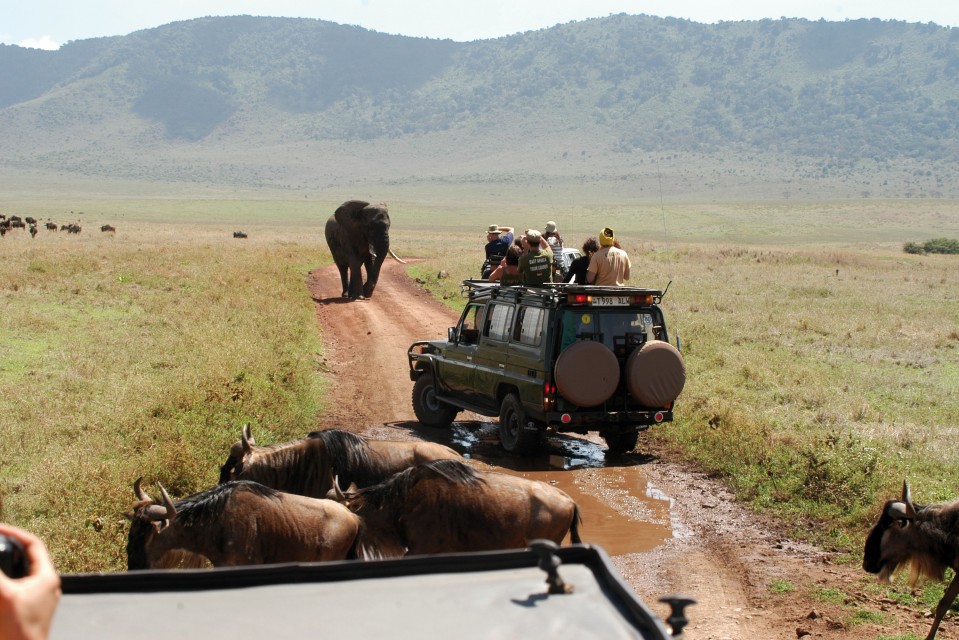
37 Day East Africa Safari (Overland Tour & Gorilla Trekking)
An epic East Africa Safari Overland Tour & Gorilla Safari from Victoria Falls to Nairobi via Zambia, Malawi, Tanzania, Zanzibar, Kenya & Uganda Gorilla…

10 Day Kenya Safari - Masai Mara & Samburu Senior Trip
A guided Kenya Safari for Seniors, this lodge senior tour explores Masai Mara, Samburu National Reserve & Ol Pejeta Conservancy. An exciting and affordable…

Budget Kenya Safari - Masai Mara & Beyond
A memorable Budget Kenya Safari to Masai Mara, Amboseli National Park, and Great Rift Valley Lakes (Lake Naivasha and Lake Nakuru). An affordable African…

Fly & Drive Amboseli & Ol Pejeta Kenya Safari
Explore Amboseli National Park and Ol Pejeta on this budget Kenya Safari to tented camps in the private Selenkay and Ol Pejeta Conservancy with expert…

10 Day Kenya Safari & Beach Holiday - Masai Mara & Mombasa
This 10-Day Kenya Safari & Beach Holiday visits Masai Mara National Reserve, Lake Nakuru Park and Mombasa beaches on a small group camping budget safari.
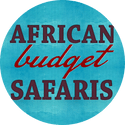
Connect with us
Useful resources.
- Get Travel Insurance
- Book Flights
- Get Car Hire
- Signup for our newsletter
Popular Destinations
Latest blogs.
- How to plan an African safari on a very tight budget: the 8-step guide to safari planning
- Top 10 Safest Countries in Africa to Visit (2024 Global Peace Index Rankings)
- Best Countries to Visit in Africa? Here are 15 Amazing African Countries
- South Africa Tipping Etiquette: 8 Top Tips for Tipping in South Africa
- How Much Does an African Safari Cost? Your Budget Africa Safari Guide

Call us toll free from US/Canada on 1-888-414-6513 , or from the UK on 0-808-189-1052 . All other countries can contact us on +27 21 791 0878 .
© 2024 African Budget Safaris | Privacy | Terms | Cookie Policy | Consent Preferences
Kenya Safari | Luxury, Lodges and Tours
Kenya safaris consistently rank in the top 3 destinations for safari-goers in Africa and it’s easy to see why. Home to prime game viewing, the incredible Masai Mara savannah, luxury lodges, stunning beaches and the famous Mount Kenya, this east Africa wonder packs a powerful punch.
Nearly 1.5 times the size of California at 224,000 sq miles, this incredible land neighbours five countries including Sudan, Tanzania, Uganda and with Somalia and Ethiopia to Kenya’s east and north.
The best time to visit Kenya is from July to September, during the country’s dry season, which also coincides with the Great Migration of wildebeest and zebra. The rainy seasons are also good times to travel, as there are fewer visitors and you can admire the striking emerald vegetation.
Table of Contents
Why Kenya for a safari
Kenya is renowned as a premium destination for big 5 wildlife viewing, luxury lodges, Masai Mara safari tours , Amboseli National Reserve and incredible Kenya beaches have international visitors flocking from the U.S, U.K, Europe and beyond.
Famous not just for its incredible wildlife at Tsavo National Park, Kenya is also surrounded by calderas and mountain ranges with the Great Rift Valley dividing the country.
To the east of this sweeping valley, you can climb the snow-cloaked equatorial peaks of Mount Kenya and fish for trout in crystal-clear streams.
Hell’s Gate National Park harbours obsidian caves and hisses with natural geysers and hot springs. To experience the romance of Kenya’s colourful colonial history captured in the film Out of Africa, head to Nairobi.
This bustling capital is the gateway to one of the world’s most evocative and exciting travel destinations. Discover more places to visit in this fascinating country with our list of the top tourist attractions in Kenya.
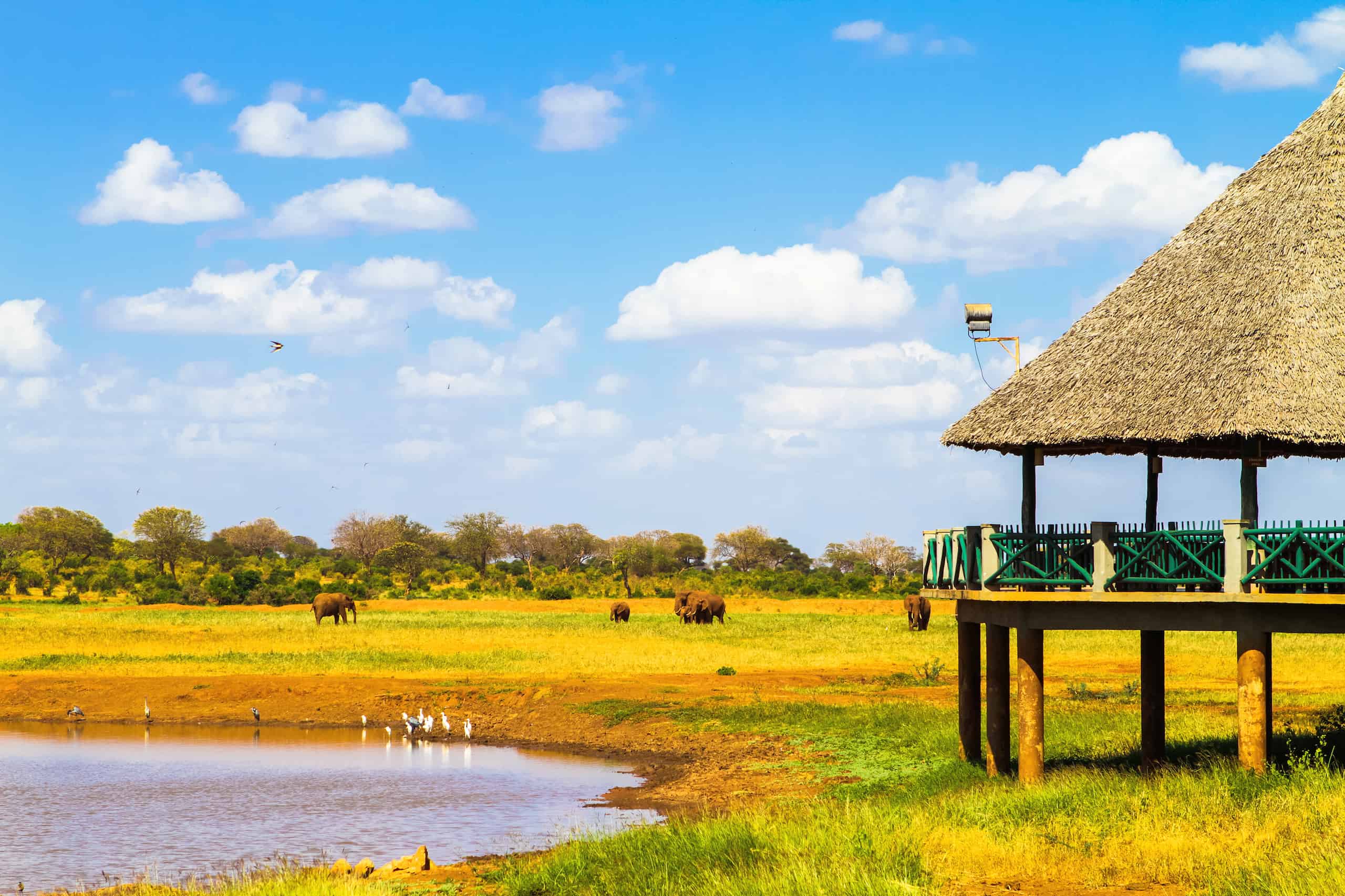
Top attractions visitors can expect from a Kenya safari include:
Kenya is a country of incredible bio-diversity, and one of the world’s most exciting wildlife destinations. Famous for its wildlife, visitors will find Wildebeest, Diceros, Impalas, Dik-diks, Impalas, giraffes, hyenas, African wild dogs and many more.
All Big 5 game animals can be found roaming including the African bush elephant, the lion, black rhino and white rhino, leopard and the African buffalo. Endlessly intelligent and iconic, African elephants continue to capture the hearts of travellers to Kenya.
In addition to watching the largest land mammals roam the savannah, you can opt to visit the David Sheldrick Elephant Orphanage where they care for young elephants and rhinos before releasing them back to the wild.
Kenya is also a birdwatcher`s paradise, teeming with birdlife, with diverse habitats in spectacular scenery. Over 1100 bird species have been recorded in the country, and it is possible to see well over a half of these without undue effort on a safari tour.
Best Parks & Reserves
Kenya has numerous parks, reserves and sanctuaries, all of which have their own charm, accommodation and wildlife attractions.
With 24 national parks, 15 national reserves, 6 marine parks, and private conservancies on top of that, the choice can be overwhelming when it comes to visiting Kenya’s national parks.
Of particular note amongst all of the incredible parks, Maasai Mara is widely regarded as being one of the best safaris in Kenya as well as Amboseli National Reserve and Tsavo National Park.
- Masai Mara National Reserve — Kenya’s most famous park, known for having some of the highest concentrations of the big five in Africa, but it also witnesses the phenomenal Great Migration. Sharing a border with Serengeti National Park in Tanzania, Masai Mara safaris receive a massive seasonal wildebeest migration.
- Amboseli National Park — Due to its proximity to Nairobi and the abundant wildlife, Amboseli is the second most famous national park in Kenya after Masaai Mara. The landscape ranging from semi-arid dry lake beds to wet swamps attracted a wide variety of animals. The highlight of the park are the elephant herds population, featured in many documentaries. The park connects tourists with the local Maasai people, whose villages you can visit via guided tours.
- Tsavo East National Park — Occupying almost 8,700 square miles, Tsavo East is one of the largest national parks in Kenya in a semi-arid climate zone with big numbers of Tsavo Lions without any manes.
- Tsavo West National Park – Covering an area of 3,500 square miles, Tsavo West National Park is more mountainous and wetter than its Tsavo East park counterpart with swamps, Lake Jipe and the Mzima Springs.
- Aberdare National Park — Cool and cloudy Rift Valley park with lots of large game, and over 250 species of bird recorded.
- Hell’s Gate National Park – A small National Park close to Nairobi, which allows you to get out of the car and offers some nice opportunities for rock climbing and some game
- Lake Nakuru National Park — A stunning 400 species of bird have been recorded here including the largest flocks of Flamingos anywhere on earth
- Lake Elementaita — One of the smaller lakes in the Great Rift Valley recently declared a UNESCO world heritage site. scenic and rich in bird life.
- Nairobi National Park — Located in Nairobi and a great option to see large game for those on a tight schedule.
- Meru National Park – a wide range of wild beasts like elephant, hippopotamus, lion, leopard, cheetah, black rhinoceros and some rare antelopes.
- Sibiloi National Park – listed as a UNESCO World Heritage Site as a part of Lake Turkana National Parks.
- Mount Elgon National Park – Home to over 300 species of birds, including the endangered Lammergeyer. The higher slopes are protected by national parks in Uganda and Kenya, creating an extensive trans-boundary conservation area which has been declared a UNESCO Man & Biosphere Reserve.
- Lake Naivasha National Park The crater rim here provides great scenic views across the beautiful Rift Valley all the way to Lake Naivasha with big cats and major wildlife at Mount Longonot including buffaloes, elands, lion, leopard, bushbucks, common zebra, giraffes and Grant’s gazelles.
Other parks popular with visitors include the unique Saiwa Swamp NP and mesmerising Mwaluganje Elephant Sanctuary .
Safari tours
A safari tour package in Kenya is typically organized by a tour operator, safari tour company or via a self drive Africa safari trip.
Spread across the country including safaris and beach holidays to neighbouring Zanzibar, or indeed the stunning Seychelles , Kenya’s parks and reserves can take several hours/flight to one another.
It is therefore important to take many elements into account when visitors plan their Kenya tour including:
- Which animals you would like to see
- Budget for the trip
- Travel party (solo, with friends or a larger family group)
- Activities revolving around the best things to do in Kenya including the national parks, Kenya hot air balloon safaris and walking safaris
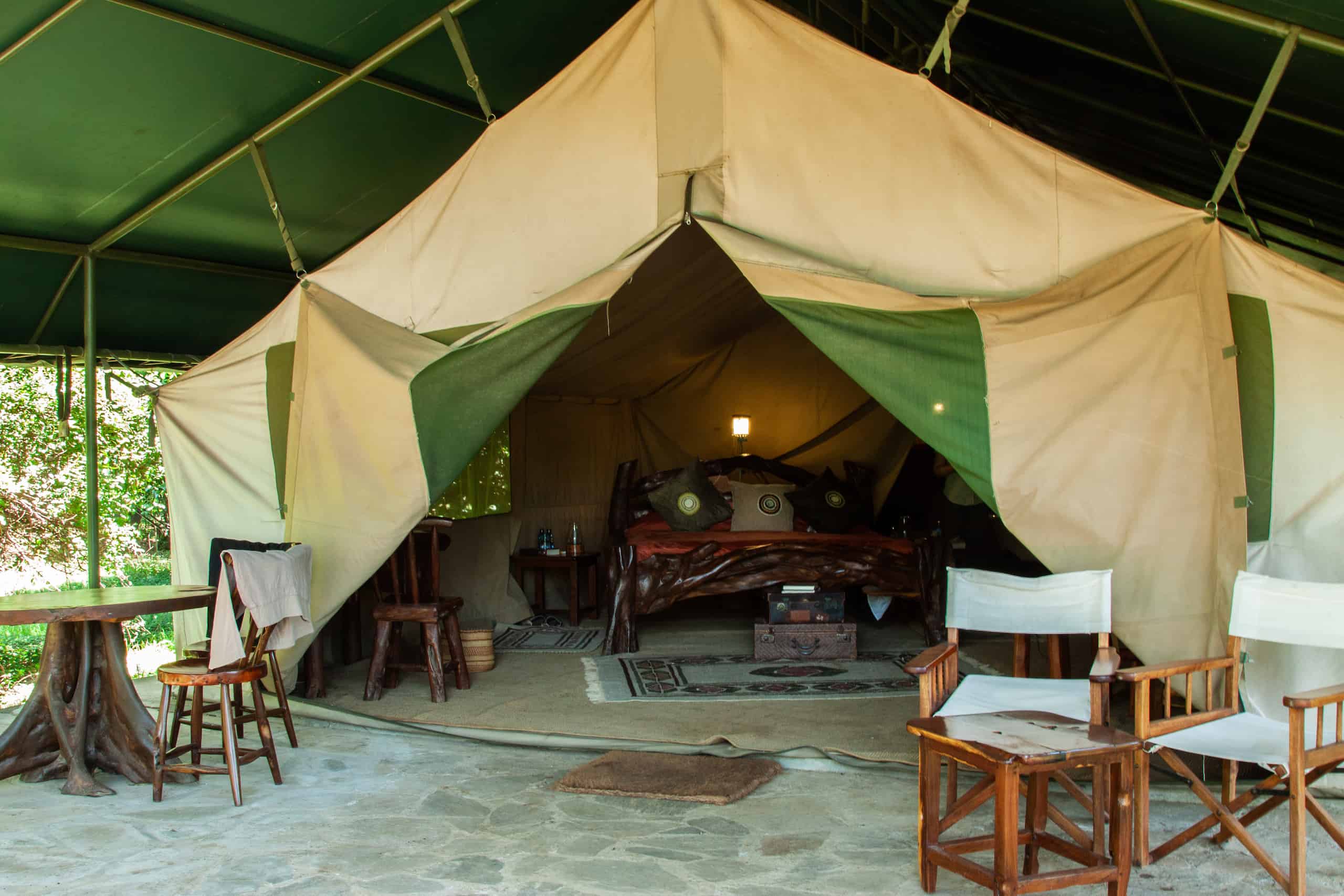
Guided tour
A guided safari package brings the benefit of:
- Transfer via plane/4×4 to the safari camps and lodges
- Luxury lodge packages
- Meals/drinks all catered for
- Safari guides and transport
- Facilities prepared including showers, wifi, cocktails and all requests
- Combined trips to neighbouring Tanzania and beach trips
- Tailored trips including chimp trekking tours
Self drive safari
For self-drive African safaris, visitors can hire their own 4×4, whilst accommodation can be secured in park campsites or in the vehicle itself if a campervan option is selected.
Part of the fun of a self drive safari is spotting the abundant wildlife on your own and taking the time to spend viewing your favourite animals.
A normal 2 wheel drive car may be sufficient, and of course cheaper, for some parks however other parks have deeper sand and a 4*4 will be required.
Best time to go to Kenya
Kenya is a beautiful country to visit, regardless of the season and popular with visitors from the U.S, Europe and South Africa.
Certain periods are more favorable for a safari in the best conditions. To know the best time to travel to Kenya , visitors should take into consideration the following key criteria:
- Regions visited
- Weather conditions
Overall, July to September is the best time to visit Kenya during the country’s dry season, which also coincides with the Great Migration of wildebeest and zebra.
Kenya safari cost
Kenya is a premier safari destination in Africa, thus incurring the more expensive costs associated with this.
There are multiple factors that can impact the Kenya safari prices including accommodation selected, trip duration, safari costs, tours, flights, transfers, meal options and additional activities visitors may request.
Travellers on a budget can reduce costs by booking their own flights, accommodation and activities as well as hiring a 4*4 to travel between the parks and reserves.
Organizing your safari
There are a number of different options available for organizing your safari in Kenya including:
Organizing your own safari is possible but only recommended for more experienced travelers and visitors on a strict budget. This option requires time and know-how to plan for all flights, transport, meals, accommodation and safari tours.
Without the knowledge of specific safari destinations and logistics in navigating an African country, this may be a challenging option for many travelers.
Tour operators
The biggest tour operators will offer safaris in Kenya where visitors can book a package that will cover their flight, transport, accommodation, activities and food, an ideal option for those with no previous safari experience in preparing for such a trip.
Safari travel agencies
Visitors will often find dedicated safari travel agencies to be the best option in booking their dream safari. These agencies have many years experience in booking safaris as well as multiple partnerships with local tourism networks and lodges/game reserves.
Travel agencies typically offer:
- Tailor-made tours
- Local tour guides
- Trips to must-see wildlife areas and parks
- All transportation
- High quality accommodation at reduced prices
The cost of the service of these specialized agencies can be a bit higher compared to other options, a cost worth bearing given the quality and ease of services provided.
Accommodation
Visitors typically will have the choice between lodges, chalets and campsites as well as African tent camps, suites and bedrooms.
Luxurious facilities are common including swimming pools, restaurants, bars, spas and terraces. Game viewings and plane transfers are organized by the accommodation providers.
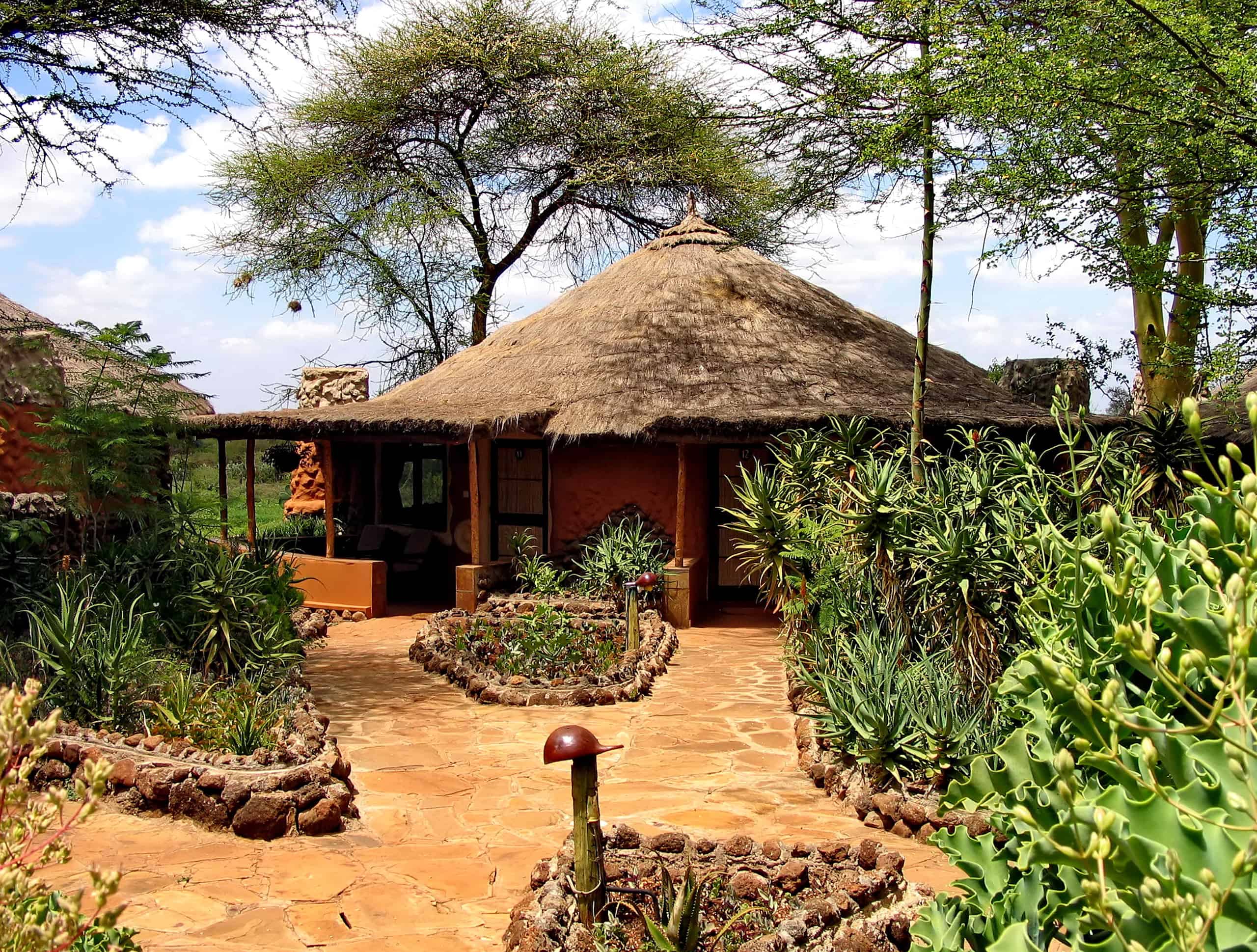
Trip preparation
International flights arrive via Jomo Kenyatta International Airport (NBO) for visitors wondering how to get to Kenya . Most tourists will have to obtain a Kenya visa including citizens of the U.S, U.K, EU, India and Canada.
Kenyan entry visas are exclusively issued electronically, with passengers required to obtain their e-visas before departure. Visitors can apply for single entry and transit visas on the e-visas website .
Visitors can expect to wait approximately 1 to 3 days for the visa to be approved and processed, and receive their Kenya eVisa in their inbox. Once approved, travellers are permitted a 90-day stay in Kenya.
Your passport should be valid for a minimum period of 6 months from the date of entry into Kenya. Make sure you have two blank pages in your passport on arrival.
The CDC and WHO recommend the following vaccinations for Kenya: Covid-19, Hepatitis A, hepatitis B, typhoid, rabies, meningitis, polio, measles, mumps and rubella (MMR), Tdap (tetanus, diphtheria and pertussis), chickenpox, shingles, pneumonia and influenza.
Yellow fever may be required if traveling from a yellow fever endemic country.
Malaria is prevalent in Kenya, particularly outside Nairobi. One of the highest risk areas is Mombasa which is where many travellers will find themselves at some time.
Malaria is transmitted by the bite of an infected mosquito and so the first line of defence is to protect yourself against mosquito bites. Malaria Prophylaxis may be prescribed to you during your consultation depending on your itinerary.
Check with a travel medicine specialist to see if antimalarials should be considered to help prevent malaria contraction. Visitors can find further information on Kenya vaccine details here .
At all ports of entry, visitors to Kenya who are above the age of 12 will be required to present documentation of either a COVID-19 vaccine or a negative COVID-19 PCR test performed no more than 72 hours prior to departure.
For further info on Kenya vaccine requirements , read our detailed and entry requirements.
What to pack
The essential items to pack for your Kenya safari include:
- Neutral coloured clothes
- Long-sleeved shirts protecting against the sun and mosquitoes
- Sunscreen, sunglasses, a hat and insect repellent
- Jackets and sweaters for early morning game drives
- Comfortable walking shoes
The currency of Kenya is the Kenya Shilling (KES). USD $1/GBP £0.75 = Approximately 114 KES.
Carrying a small amount of Kenyan currency , the Kenya Shilling (KES) is recommended to pay for groceries and smaller items where credit cards aren’t accepted.
Driving in Kenya
Driving is conducted on the left hand side of the road in Kenya and driving is generally considered to be safe.
Visitors driving through parks may require a 4×4, whilst carrying a map & GPS is recommended.
Visitors should consider travel insurance when planning their trip to help protect and cover the costs of hospitalization or repatriation if required.
Some credit cards may already include travel insurance. Online travel insurance comparators are also useful in finding suitable offers.
How much does a safari in Kenya cost?
Visitors can expect to pay between $800 to $1,100 per person per day.
When to go on a safari in Kenya?
Between July and September is the best time to go on a safari in Kenya, during the dry season.

Safaris in Kenya worth visiting
Are you an animal lover and want to see your favourite beasts wandering in their natural habitat? Or maybe you just love the planet we live on and want to see more of it? Whatever your reason for wanting to go on a safari, you’ll not be disappointed when you do.

Kenya is home to a range of different kinds of safari and many of them have a focus on conservation, so you know your holiday destination is doing good too! As well as variety, Kenya also has a deep history of safaris and is considered the home of the ‘original’ safari.
So, while you’re filling out your Kenya eVisa application and booking flights and accommodation, why not take a look below and find out more about Kenyan safaris. We’ve covered how many safaris there are in Kenya, what the best safaris are in Kenya and how to choose a safari in Kenya.
Check it all out below to find out more.
How many safaris are there in Kenya?
So, how many safaris are there in the home of the ‘original’ safari?
Kenya is home to 54 national parks and game reserves each with its own safari trips and tours, offering different experiences to different customers. You are absolutely spoiled for choice when it comes to safaris in Kenya.

From big cats and wild dogs to rhinos, the Great Migrations, and a mix of wildlife and beaches, you can take your pick of the kind of animals you would like to see in Kenya. To find out more about how to pick a safari in Kenya, keep reading now.
How to pick a safari in Kenya?
Now you know how many choices you have for safaris in Kenya, you’re probably wondering how you’re supposed to pick one! Well, we’ve got you covered.
First of all, we’ve got some general advice for choosing safaris below:
- What you want to see – the first thing you’ve got to know when picking a safari is the kind of wildlife you want to see. This varies across Kenya and we have more information on that below!
- Transport – this is a big one for some people. While many tourists choose to go on a safari in the well-known doorless 4×4, there are other options like walking tours and boat safaris.
- Independence – the level of independence you want on your safari is important to your experience. You can join a large group where you may share your time with strangers, book into a private safari, or even go on a self-drive tour.
If you’re trying to decide where to go in Kenya based on what kind of wildlife you can see, check out our summaries of each part of Kenya to find out more.
- Central Kenya: with lots of conservation areas and geographical diversity from lakes to mountains, this part of Kenya is a great place to see all kinds of birds and other wildlife.
- Western Kenya: this part of Kenya is home to big game which you can see year-round and is the only place you’ll see the Wildebeest Migration.
- Northern Kenya: the north is drier than other parts of Kenya and has more hills. It is also the best place to consistently see rhinos.
- Southern Kenya: to get a peek at the great Mount Kilimanjaro, you should head south. With wetter terrain, the wildlife here is diverse and you may be able to pair your safari up with some beach trips too!
Which are the best safaris in Kenya?
Now we know how to pick a safari, let’s take a look at some of the best safari parks in Kenya. We’ve listed a few below and have briefly summarised what you’ll see when you visit. Check it out now.
Masai Mara National Reserve
A world-renowned park and an incredibly popular tourist destination, the Masai Mara National Reserve is home to tonnes of wildlife and is known for its great plains.
What you’ll see: this incredible park is home to everything from Masai lions, cheetahs, and African leopards to wildebeests, zebra and gazelle. You’ll also see elephants and a whole load of other wildlife.

Lake Nakuru National Park
This stunningly picturesque park is located on the floor of the Great Rift Valley and is home to a huge diversity of wildlife.
What you’ll see: this beautiful landscape is home to flamingoes, hundreds of other water and terrestrial birds, rhinos and waterbuck, as well as waterfalls and unique plant life.

Tsavo National Park
Split into two national parks, the Tsavo is the largest national park in Kenya. Nicknamed the ‘ theatre of the wild ,’ this national park lives up to the hype with hundreds of species for you to see.
What you’ll see: the park is renowned for sightings of red elephants, along with rhinos, buffalo, lions, pods of hippo, crocodiles, and 500 different species of bird.

Conclusion: safari parks in Kenya
Home to 54 national parks and game reserves, there is so much to choose from when looking at safaris in Kenya you won’t know where to start. We have briefly summarised some of the key aspects of safaris in Kenya and hopefully, we’ve made your decision a little easier.
Make sure you have everything you need
What to pack for your next trip.
Make your next trip as simple and as enjoyable as possible by packing smart. It’s amazing how much stress top travel items can save you, so choose carefully. Things like lightweight travel backpacks, for example, are ideal for short trips and allow you to move around with ease, and a passport holder will make sure you keep your documents safe at all times. Check our travel checklist guide for 2021 to make sure you haven’t missed anything, and travel to your next destination in style and with maximum comfort.
Related posts:
Leave a reply cancel reply.
Your email address will not be published. Required fields are marked *
Save my name, email, and website in this browser for the next time I comment.
Notify me of follow-up comments by email.
Notify me of new posts by email.

How to Book a Safari in Kenya
Want to book a safari in Kenya? Should you self-organise or go with a local company? We compare prices, locations and quality of experience.
Booking a safari in Kenya was one of the most involved travel plannings we’ve ever done. There are all sorts of levels of involvement, of course, but the more informed you are, the better your trip will be.
We recommend going with a local tour operator. It is possible to arrange a safari to several parks on your own, but it is a lot of work. Furthermore, it might not end up much cheaper, as tour operators can get rooms at a more affordable rate. Also, cheaper tours usually come at the expense of vehicle quality as a lot of the cost goes into transportation.

In this post, we will recommend the Natural World Kenya Safaris as a good, local option. They did not sponsor us in any way to write this post. We had the trip of a lifetime with them and feel that they offer a great service for a great price.
Costs of Self-Booking vs. a Local Travel Operator
Estimates for a self-planned budget tour, including shared game drives (minimum three to four persons in the jeep), come in between $178 to $250 per person, per day . The budget option with the Natural World Kenya Safaris , the local company we travelled with, comes in between $170 (Amboseli and Tsavo) to $207 (Masai Mara) per person, per day, for four people sharing.

I think this company is able to keep their costs down while maintaining a high standard because they own their 4×4 vehicles. Their experienced guides also double up as excellent drivers. Furthermore, they are likely able to negotiate better prices with the lodges as they are a large local operator often contracted by foreign tour agencies.
Flexible Costs vs. All Inclusive
When considering the self-organised safari experience, you need to make room for unexpected costs. Going with a reputable tour company, we did not experience any unexpected expenses. The price they charged was all-inclusive, right down to the water in the jeep (but excluding drinks and bottled water at the lodges). In both instances, tips are not factored in. Still, the courtesy amount is the same regardless of whether you self-organise or go with an agency.

Our first trip to Kenya was self-organised and our second trip was with the Natural World. We cannot recommend self-organising as a way to save money, because in our case, we felt the money saved, which was not significant, came at the expense of the game viewing and wildlife experience.
Choose Your Locations
Kenya is a vast country. There are countless famous parks and incredible locations everywhere you go. You need to be realistic when choosing your locations. Even if you are flying, travel and transit time will still be significant. You want to spend your time on safari game-watching, not in a car or airport.

Safari Locations in Kenya
We feel the first thing you should do before you book a safari in Kenya is to choose your locations. The most popular destinations for safaris and game viewing are the Masai Mara, Amboseli, Tsavo East and Tsavo West, Nairobi National Park, and Hell’s Gate National Park together with Lake Naivasha.

Of these locations, the Masai Mara is separate from the rest by distance. For example, to get to Amboseli from the Masai Mara by car, you will need to do an overnight stop in Nairobi. Whereas it’s possible to drive straight from a hotel in Amboseli to Tsavo East or Tsavo West.
In general, we suggest grouping the locations like this:
- Masai Mara , on its own – check out our post on the Masai Mara Safari
- Masai Mara, Lake Naivasha and Hell’s Gate
- Tsavo East, Tsavo West and Amboseli
You can visit the Nairobi National Park when you arrive in Kenya, as most international flights land at the city’s Jomo Kenyatta airport.

Travelling Times and Options Between Locations
Be extra careful of tours offering you all the parks in a short time when you look to book a safari in Kenya. Some of them have impossible itineraries on which most of the time will be spent travelling instead of game viewing. Distances in Kenya are large, and the road quality varies a lot. For example, getting from Amboseli to Tsavo West (which looks near on the map) can take you between 4 to 6 hours. That’s pretty much one day of your holiday spent travelling. If there is travelling involved, ask the tour operator how long it will take. The road situation is continually changing in Kenya, so advice on the internet might not be up to date.

Pick Your Budget
When you book a safari in Kenya, you can choose from three budgets. Economy, comfort or luxury. The range is usually from $250 to $1000 per person, per day for a safari in Kenya (sharing couple). Cost per person goes down significantly when sharing between four to six people. When considering the price, note that a chunk of it goes into park fees, which start from around $50 per person. Entry into the Masai Mara is $80, for example.

Staying in conservancies can add about $100 per person, per day. This is because conservancy fees can be high, and lodges can pay around $70 a day, per bed, is what I’ve read. This is on top of required monthly payments to the community, regardless of whether there are visitors or not.
From our research, the Mara conservancies have the most expensive lodges. However, it is worthwhile to mix and match options, combining budget hotels with ultra-exclusive lodges that give you access to private conservancy land.

Do I Need an Expensive Lodge for a Good Experience?
Absolutely not! Having a front-row seat at a conservancy doesn’t ensure you will see that cheetah hunt or leopard eating from her tree larder! All of that is down to pure luck, so don’t feel like you will miss out if you can’t afford some of the lodges.
Choosing a Tour Operator
Gone are the days of having to pay exorbitant prices to a foreign tour agency for your safari. These days, you can, and should, book your safari in Kenya directly with a local company. Many safari agents, especially those that bill themselves as “luxury providers” are tour resellers and add an unnecessary markup to the price. They make the booking in the UK, USA or Europe, and then pass on the work to a local company after adding a substantial markup.

Book Your Safari in Kenya with a Local Operator
Suppose you are hesitant to book a safari in Kenya with an unfamiliar company. In that case, you can check the website of the Kenya Association of Tour Operators to see if they are listed on it. There are indeed scammers out there so one can never be too cautious. However, if a company is not listed as a member, it does not mean that they are not trustworthy. We know a couple of small providers that are not listed but provide legitimate services.

How to Choose a Safari Tour Company
Before you go with a safari company:
- Make sure you have an idea of the locations you want to visit and a rough itinerary.
- Approach a few that fit your budget and needs and ask them for a quote.
- Make sure you know what you are getting – as mentioned before, some price quotes are lower because the company sacrifices the quality of the guide and vehicle.
Here, reading as many reviews as you can by clients who have gone on safari with the company will help you make an informed decision.

Personal Recommendation
For our trip, we went with the Natural World Kenya Safaris, a local company owned and run by Kenyans. They did not sponsor our post, and this recommendation is genuinely from the very bottom of our hearts. The service they provided was excellent, from start to end.
Pre-Booking Services
When you book your safari, you need an experienced person to advise you on what’s possible. As mentioned before, the distances in Kenya are huge, and first-timers are likely to create impossible or very tiring itineraries. We had great help from the Natural World here, who helped us with organising how we wanted to spend our days. They also took into consideration that we would be revisiting Kenya. They advised us accordingly so we could have a more relaxed safari.


Guide and Driver
We were surprised by how knowledgeable and skilled our guide, Joseph Mbotte , was. He made me realise that being a safari guide and driver is not a walk in the park and requires specialised knowledge in many areas. There are so many things that can go wrong if you don’t have the right guide and driver. Our guide, and any excellent guide worth his salt, needs to have the following traits:
- Have a comprehensive knowledge of flora and fauna found in different parks, including their names and behaviours
- Knowledge of where the animals tend to congregate
- Ability to locate areas in the park based on roads that may be overgrown
- The skill for driving on challenging off-road terrain and insane Kenyan roads
- Have a genuine passion for wildlife
- Having an eye for photography and an interest in it
Most of their guides are professionally trained and are members of the Kenya Professional Safari Guides Association .

Safari Vehicle
Natural World Kenya Safaris provided us with a very comfortable 4×4 Land Cruiser. The Land Cruiser had been converted into an open-top and had ample height for tall people to stand up in. We felt this is a crucial detail as you’ll be standing up for most of the drive in the vehicle. The vehicle was super spacious and had ample area for all our camera gear.

The game viewing and photographing experience is markedly superior in a converted Land Cruiser as it gives you a lot of space to get the shot you need. Also, you can get to where you need to go a lot faster and safer in a 4×4 on rough roads. You really don’t want to miss out on a moment because you couldn’t get there in time.

We hope that these tips help you in planning your first/next safari trip. All the best and hope to see you somewhere in Kenya sometime soon.
Explore more stories from Kenya

Samburu Special Five

Eagle View Camp in the Masai Mara

Hike to Lake Magadi

Walking Safari in Kenya’s Masai Mara

Tipping in Kenya

Hiking in Loita Hills and Camping in Maasai Villages

The Masai Mara, from Dawn to Dusk

Our Shimba Hills Lodge Experience

The Masai Mara Cheetahs

Jackal Hunt on the African Savannah

Scavengers in Africa – The Savannah’s Clean-up Crew

The Royal Mara Safari Lodge Experience

Masai Mara Weather

The Masai Mara Ecosystem

The Ultimate Guide to the Masai Mara Safari

Finding the Endangered Arabuko Sokoke Scops Owl

Lion Cubs spotted on our Mara Naboisho Safari Night Drive

Kenya’s Wildebeest Migration

Standing Guard, by Nature’s Twilight

Experience Kenya – Photo Gallery

- Kenya safaris
Kenya safari guide – where & when to go, and what to see
Kenya safaris rock! Kenya is one of East Africa’s premier safari destinations, with massive open savannah regions hosting a huge breadth and depth of African wildlife. Over 10% of the country is protected in some form or other, and national parks in Kenya rate as some of the best in the world. A safari in Kenya almost guarantees you a sighting of the big five African animals of lion , buffalo , elephant , rhino , and leopard . Alongside these big-hitters are hundreds of other species of African animals, and some of the world’s most diverse bird-life.
Straddling the equator, Kenya is dominated by the Rift Valley – a huge range of valleys strung along a 5,000 km crack in the earth’s crust that runs through East Africa. Within the Rift Valley are Africa’s highest peaks – in Kenya these are the volcanoes of Mount Kenya and Mount Elgon. East of the Rift Valley are the coastal plains, whilst the north of Kenya is made up of arid wastelands. The prime Kenya safari destinations are the Central Highlands and areas within the Rift Valley. The south of the country hosts the great migration of plains animals and their predators each year between June and November. In short, Kenya safaris are up there with the very best in terms of wildlife and scenery.
Self-drive safaris are an option in many national parks in Kenya, though to enjoy full access to the most remote (and tourist-free) areas you’ll need a 4WD car or jeep. If you fancy taking a tour or arranging your own guide and/or driver have a look at our list of safari tour companies in Kenya before arrival in the country.
Alongside safaris and wildlife spotting, a visit to Kenya allows you to easily extend your safari with a visit to a resort on the Indian Ocean coast, or with activities such as trekking, hiking, sailing or diving .
Useful resources
- Book a Kenya Safari
- Kenyan Ministry of Tourism
- Kenya Wildlife Service
Kenya safari highlights
Experience maasai culture.
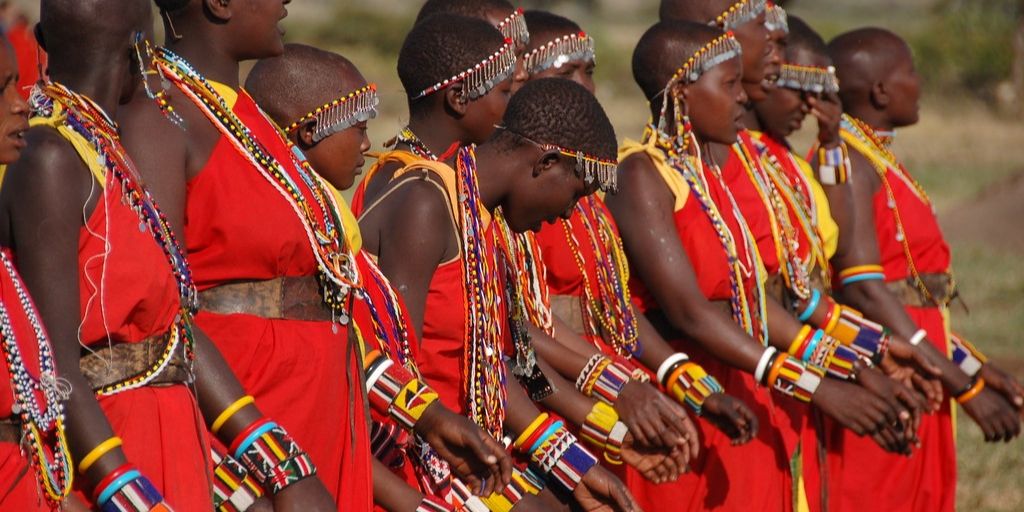
The Maasai are one of the few African tribes who have retained most of their traditions, lifestyle, and lore – along with their distinctive red robes. Many safari lodges and operators work with local Maasai on community projects. Experiencing some time in a Maasai village whilst in Kenya is a unique cultural experience that will help put your visit in context.
Big five spotting

Big five spotting in Kenya is high on most visitor’s safari checklist, and with Kenya’s superb network of national park gems seeing Africa’s biggest beasts up close and personal is a realistic goal. Destinations rich in lion, leopard, elephant, rhino, and buffalo are clustered in the south of the country, particularly Amboseli, Masai Mara and East and West Tsavo (for the Tsavo lions !) national parks.
Watch the ‘Great Wildebeest Migration’

Indian ocean beach perfection

Best time to safari in Kenya
The peak tourist season in Kenya is January and February when the weather is consistently warm and dry, with wildlife easy to spot in large concentrations. If you take a Kenya safari in peak season expect to be in company with crowds of tourists, and paying top dollar for your safari. If you’re specifically after catching sight of the annual great migration, June to October is the time to head to the Masai Mara National Park in southern Kenya.
The long rains hit Kenya through March, April and May, and the short rains from October to December. During the short rains, it generally rains only for short periods at a time, meaning your wildlife viewing will not be too disrupted. This is the time you can get some great deals on safari tours, or safari lodges if you’re travelling independently.
Flights To Kenya
Search, track and book flights to Kenya, from anywhere in the world.
Kenya Accommodation
Find safari accommodation in Kenya – from budget campsites to luxury lodges.
Kenya Car Hire
Considering a self-drive safari? Research and book car hire in Kenya.
Activities in Kenya
Search and book things to do in Kenya – tours, excursions and activities.
National parks in Kenya
With a stunning array of wildlife and more than 10% of the country given over to national parks and reserves, Kenya is undoubtedly one of the world’s best safari destinations. Whilst the world-famous Kenyan national parks such as Masai Mara and Amboseli National Parks can be uncomfortably heaving with tourists in January and February, Kenya has plenty of smaller, out of the way national parks that see only a trickle of visitors year-round. As such it’s well worth taking the time to consider whereabouts in Kenya to go on safari if you’re visiting during peak season.
Top Kenya national park picks
Masai mara national reserve.
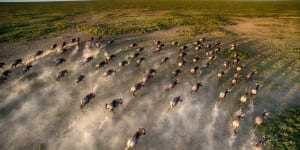
Situated in southwest Kenya, the Masai Mara is part of the northern section of the Serengeti National Park, and is generally recognised as one of the greatest wildlife reserves in Africa. The reserve is famous for the abundance of predators – particularly big cats – and the great wildebeest migration to feed these predators, as well as the Maasai people themselves.
- Lake Nakuru National Park
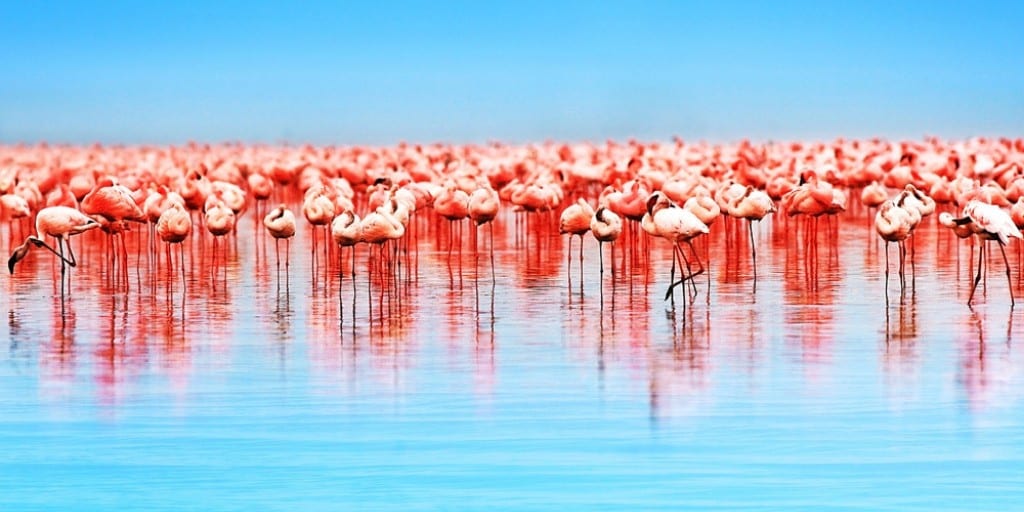
The stunning Lake Nakuru National Park is on the floor of the Great Rift Valley, surrounded by bushy grasslands and woods. There are 56 species of mammal in the park, but the star show are the thousands of flamingos, arriving in their millions some years.
- Amboseli National Park

Crowned by Africa’s highest peak, Mount Kilimanjaro, Amboseli is one of Kenya’s most popular parks . The name ‘Amboseli’ comes from the Maasai language and means ‘salty dust’… perfect for the large herds of elephants that roam the park.
- Meru National Park
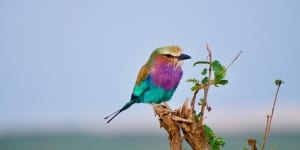
Meru National Park is a Kenyan park is located 350 km from Nairobi, featuring multiple landscapes including grasslands, swamp, jungle and rivers. It’s a birders paradise with over 427 recorded bird species, in addition to the big five .
All national parks in Kenya
Use the map below to locate all national parks in Kenya. Click the icons for more info.
Get Directions
- Aberdare National Park
- Arabuk Sokoke National Park
- Hell’s Gate National Park
- Kakamega National Park
- Lake Bogaria National Park
- Malindi Watumu National Park
- Masai Mara National Park
- Mount Elgon National Park
- Mount Kenya National Park
- Nairobi National Park
- Saiwa Swamp National Park
- Shimba Hills National Park
- Tsavo National Park
Kenya safari resources
Kenya safari companies.

There are plenty of companies offering safari tours around Kenya. The focus is on the high end, but there are some companies that specialize in mid and budget safaris. Check out our reviews of safari tour companies in Kenya .
Kenya safari lodges
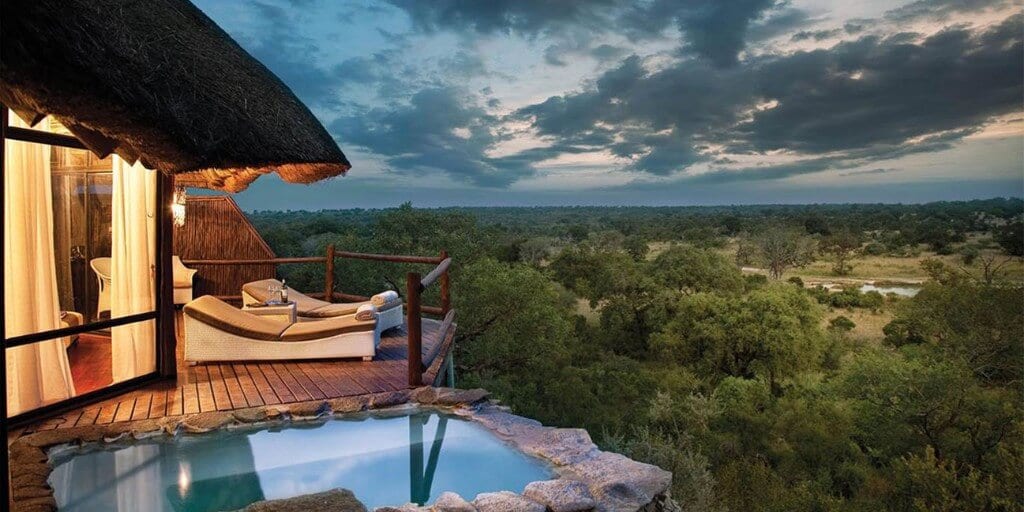
As a tourism-focussed country, Kenya has plenty of choice when it comes to safari accommodation. Lodge standards vary from rustic to modern, from the simple room to extreme luxury with en-suite private plunge pool. Search and book accommodation in Kenya .
For a trip to Kenya, travellers are required to apply for a visa. The easiest, most commonly used visa for going on a safari in Kenya, is the Kenya e-visa . It is valid for 90 days, and can even be extended once to 180 days once you arrive in Kenya. The visa can easily be applied for online and will save you the hassle of having to apply at an embassy or consulate.
Read safari guides to all countries
Botswana safaris , Namibia safaris , Rwanda safaris , South Africa safaris , Tanzania safaris , Uganda safaris , Zimbabwe safaris
Do you have any experience of planning or going on safari in Kenya?
We’d love to hear any feedback or tips you may have – please get in touch , or add to the comments below.
Top countries for safaris
- Botswana safaris
- Namibia safaris
- South Africa safaris
- Tanzania safaris
- Uganda safaris
Safari basics
- Safari animals
- How to find the right safari company
- When to go on safari
- What to take on safari
- Safari clothing – what to wear
- Safari rules & etiquette
- Wildlife spotting tips
Most read articles
- All about the ‘big five’ animals
- Collective nouns for animals
- Safari movies to watch before you go
- The world’s fastest land animals
- Apex predators
- 10 Fascinating African tribes
- The biggest animals in the world
- 17 Epic hybrid animals
- The world’s ugliest animals
- Why are flamingos pink?
Africa’s best game reserves
- Chobe National Park, Botswana
- Etosha National Park, Namibia
- Kruger National Park, South Africa
- Masai Mara National Reserve, Kenya
- Moremi Game Reserve, Botswana
- Okavango Delta, Botswana
- Serengeti National Park, Tanzania
Session expired
Please log in again. The login page will open in a new tab. After logging in you can close it and return to this page.

Our Top 10 Safaris in Kenya - Packages, Cost & Travel Guide
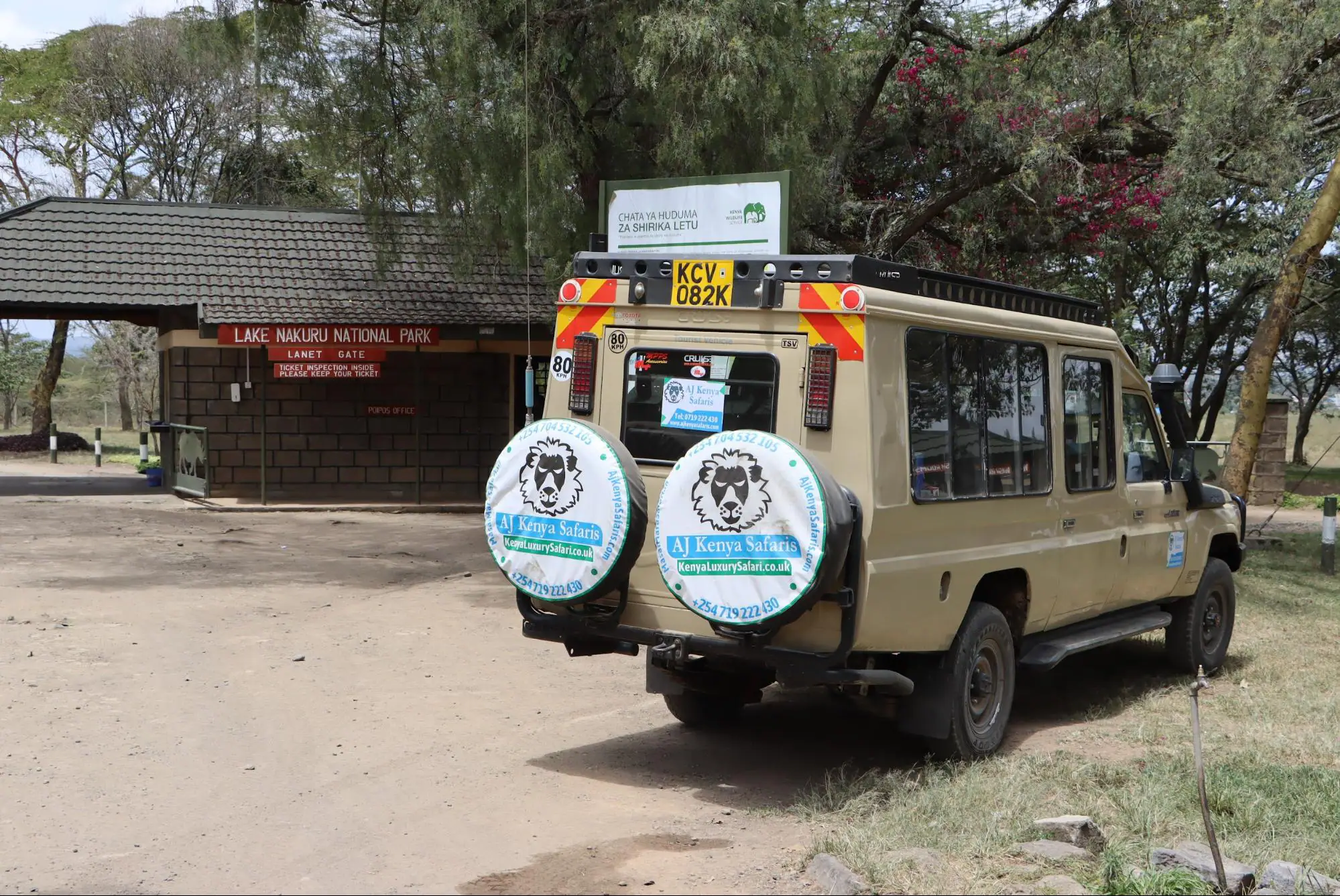
Are you ready to embark on an adventure of a lifetime? Kenya, the land of diverse landscapes, abundant wildlife, and rich cultural experiences, offers some of the most spectacular safaris in the world. But how do you plan the best African safaris in Kenya? Which is the best time for a safari in Kenya ? And how much does an all-inclusive Kenya safari cost?
In this article, our local experts will guide you on how to plan the best safari in Kenya . We will also share the top 10 unforgettable safaris in Kenya and the best destinations to visit. So, buckle up, and let’s journey together through this awe-inspiring wildernesses and pristine beaches of this incredible East African destination!
Kenya Safari Video by Our Guest - Hyenas Attempt to Attack a Lion in Masai Mara
Contacts us to start planning your 2024/2025 safaris in kenya.
Call or WhatsApp us at +254719222430 or email [email protected] or [email protected] to start planning your trip to Kenya today.
Our Best Kenya Safari Tours 2024/2025
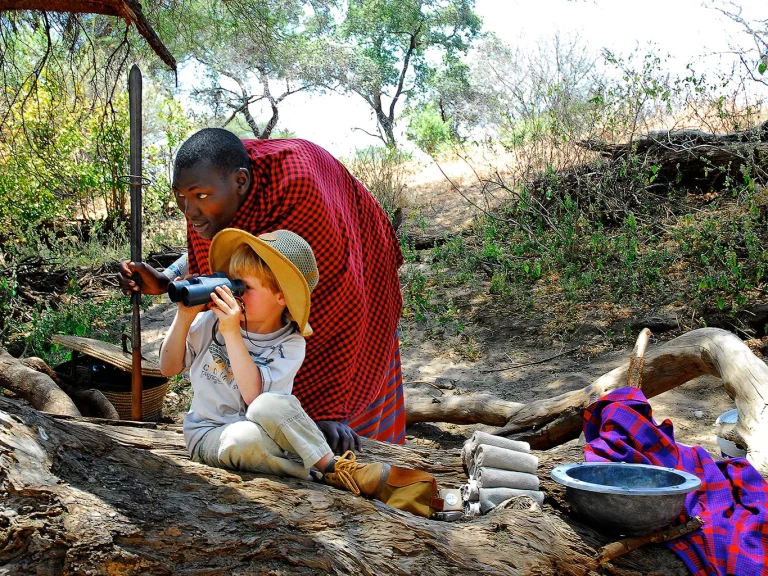
10 Day Kenya Classic Safari
From £6113 VIEW MORE
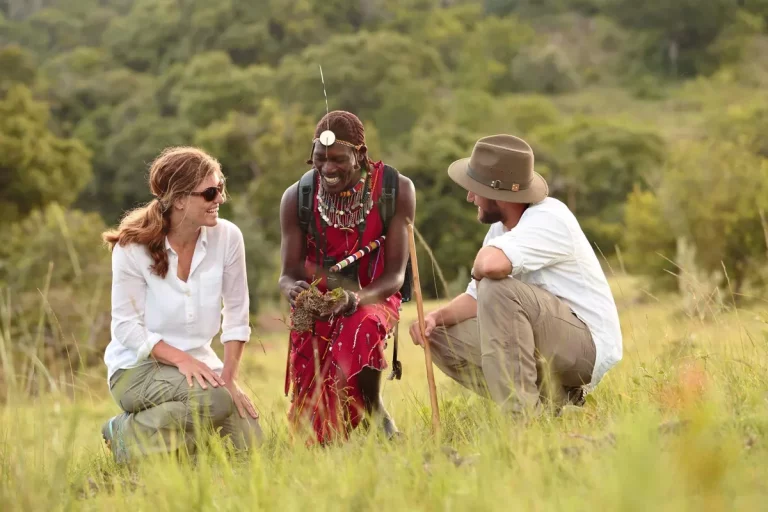
Experience True Safari Luxury with this 3-Day Masai Mara Classic Safari
From £645 VIEW MORE

7 Days, Giraffe Manor and Masai Mara Luxury Safari
From £ 4408 VIEW MORE
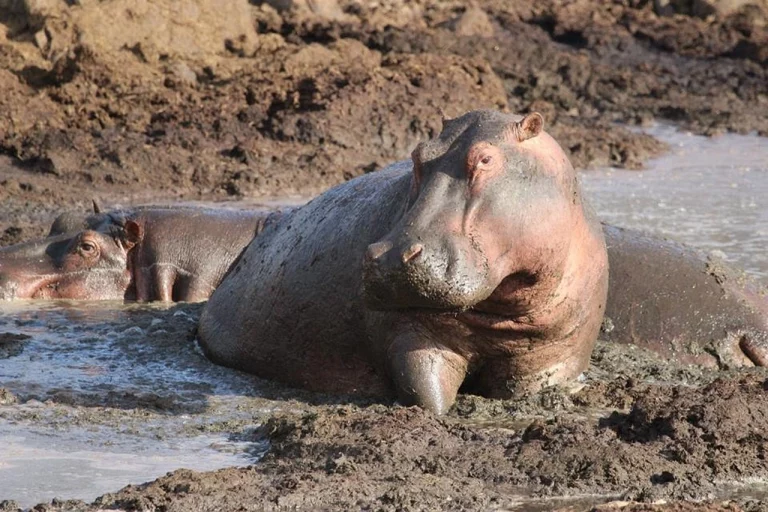
Unforgettable, 4-Day Trip to Masai Mara - Big 5 and More
From £ 889 VIEW MORE
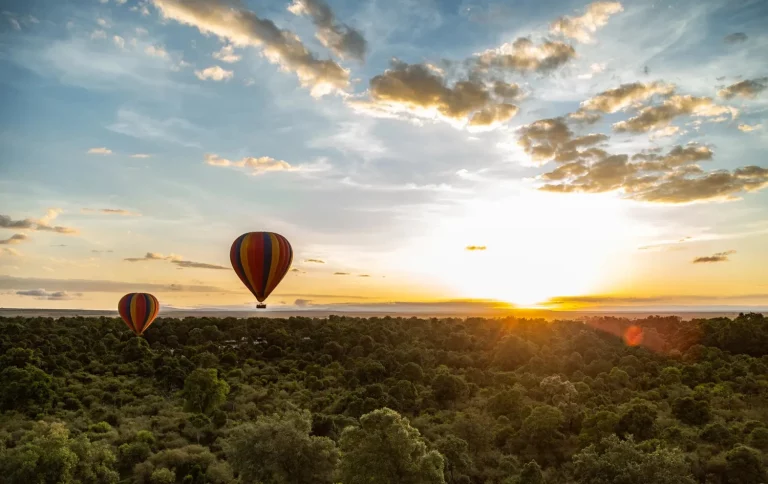
11 Days Kenya Adventure Safari
From £ 6520 VIEW MORE
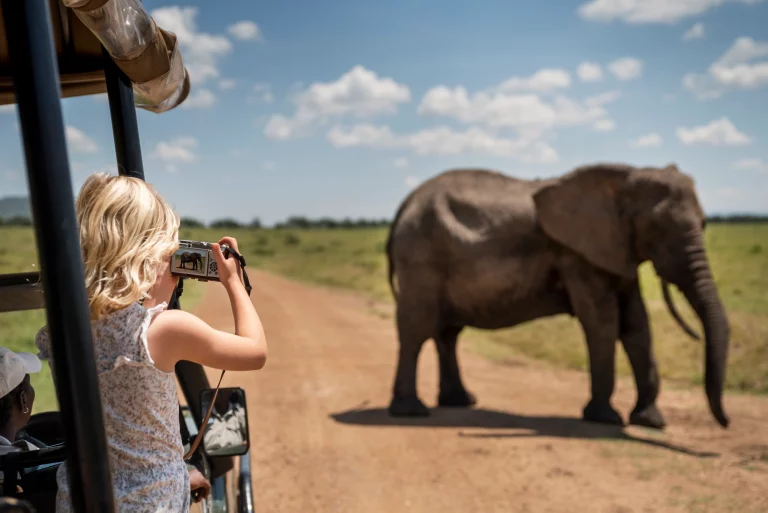
Our Best Selling, 5-Day Masai Mara Safari
From £ 1084 VIEW MORE
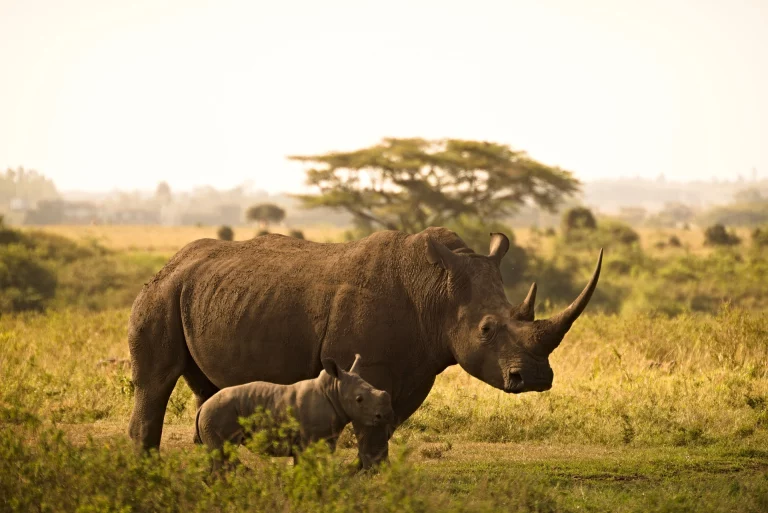
4 Days Big 5 Safari in Lake Nakuru and Masai Mara
From £ 1042 VIEW MORE
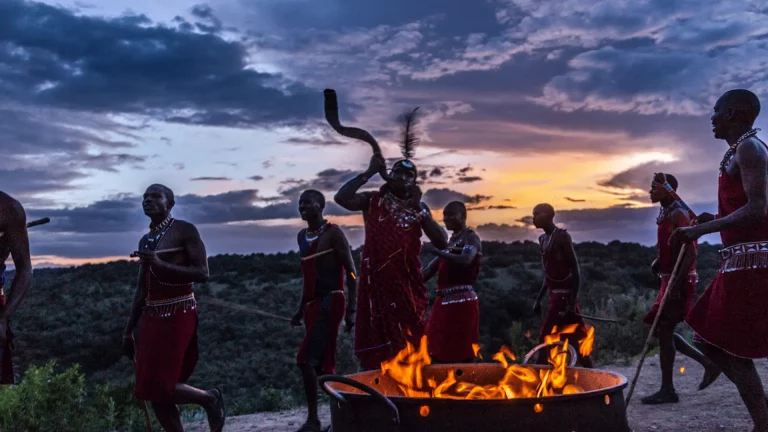
Kenya Itinerary 10 Days
From £ 3650 VIEW MORE
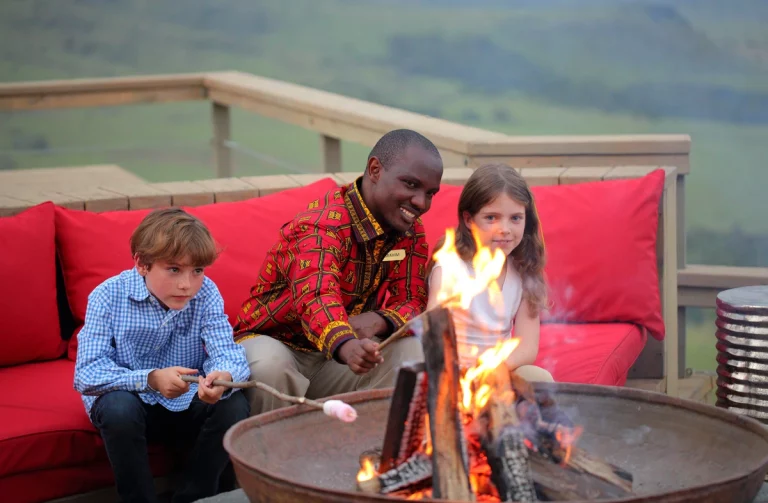
Blissful, 4-Day Keekorok Lodge Masai Mara Safari
From £ 1024 VIEW MORE

From £ 1178 VIEW MORE
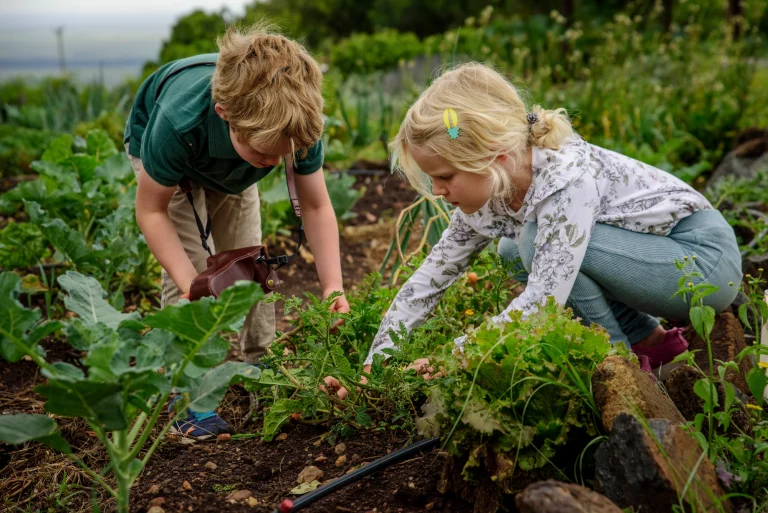
A Relaxed, All-Inclusive 6 Days Safari in Kenya
From £1748 VIEW MORE

7-Days Safari to Kenya’s Most Breathtaking Destinations
From £ 1846 VIEW MORE
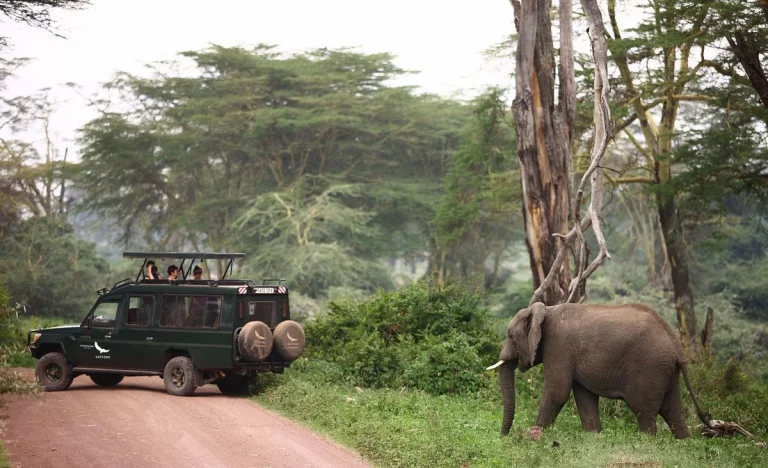
Kenya Wildlife Safari:7-Day of Unsurpassed Bliss
From £1839 VIEW MORE
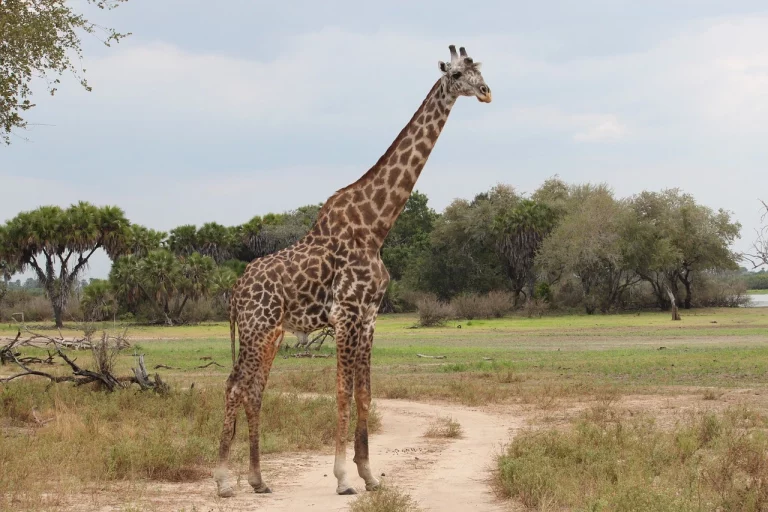
Grand Heli Tour: 8-Day of Helicopter and Wildlife Adventure
From £9795 VIEW MORE
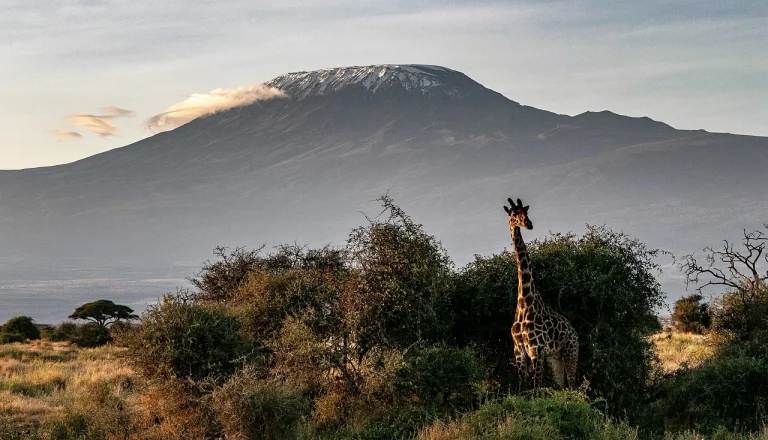
12-Day Kenya Safari and Beach Holiday - A Dream Vacation
From £3142 VIEW MORE
Key Highlights of a Safari in Kenya:
Next, we look at exciting things to do during Kenya safari tours .
Next, we look at exciting things to do during Kenya safari tours.
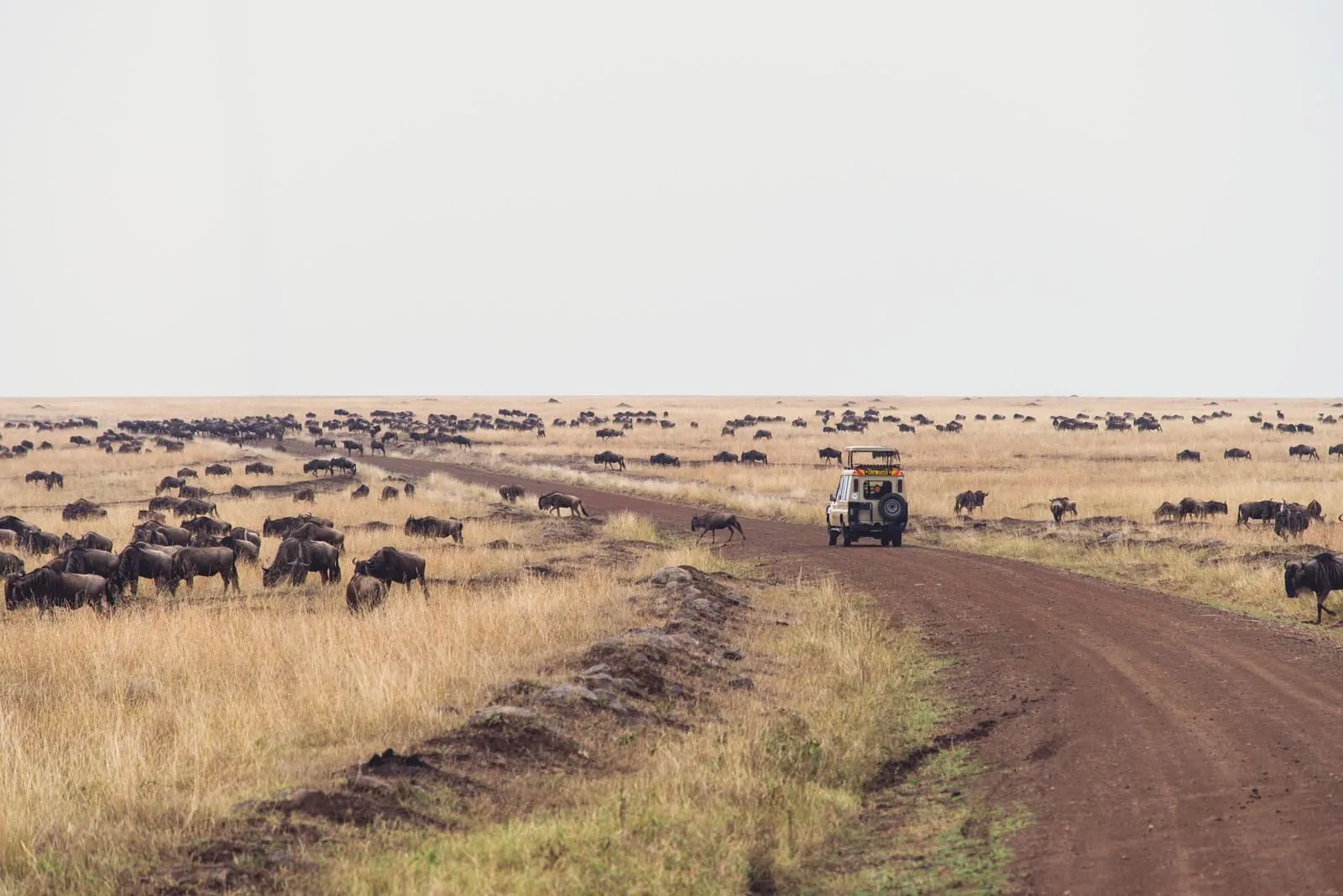
The Masai Mara National Reserve, an amazing large game reserve in Narok County, Kenya, is renowned for its abundant wildlife and the Great Migration. This iconic reserve offers a variety of thrilling Kenya safari tour options, from witnessing the Great Migration to encountering the big cats on game drives. With a range of accommodation choices, you can tailor your Masai Mara experience to suit your preferences and budget.
The Great Migration Experience
Imagine the breathtaking sight of millions of wildebeest, zebras, and gazelles traversing the plains of the Masai Mara in search of greener pastures. This awe-inspiring event, known as the Great Migration, takes place from about July to October and is an experience not to be missed during your Kenya safari .
With our local guides by your side, you will witness this natural spectacle up close, as the herds cross the croc-infested Mara River. The Masai Mara migration is truly a once-in-a-lifetime experience.
Big Cats and Game Drives
The Masai Mara is home to famous big cats such as lions, leopards, and cheetahs. With a variety of Kenya safari packages to choose from, you can embark on exhilarating game drives in search of these elusive predators. The best time to see big cats in the Masai Mara is during the Great Migration from July to October.
Accommodation Choices
After an action-packed day exploring the Masai Mara , retreat to one of the reserve’s many accommodation options. From basic safaris with no-frills lodging starting at $220 per person, per day, to the family friendly Asilia Rekero Camp overlooking the Talek River, there’s something for everyone.
For a different experience, consider visiting Tsavo East National Park , and immerse yourself in an East African safari adventure unique to Kenya.
Amboseli Safari: Majestic Views of Mount Kilimanjaro
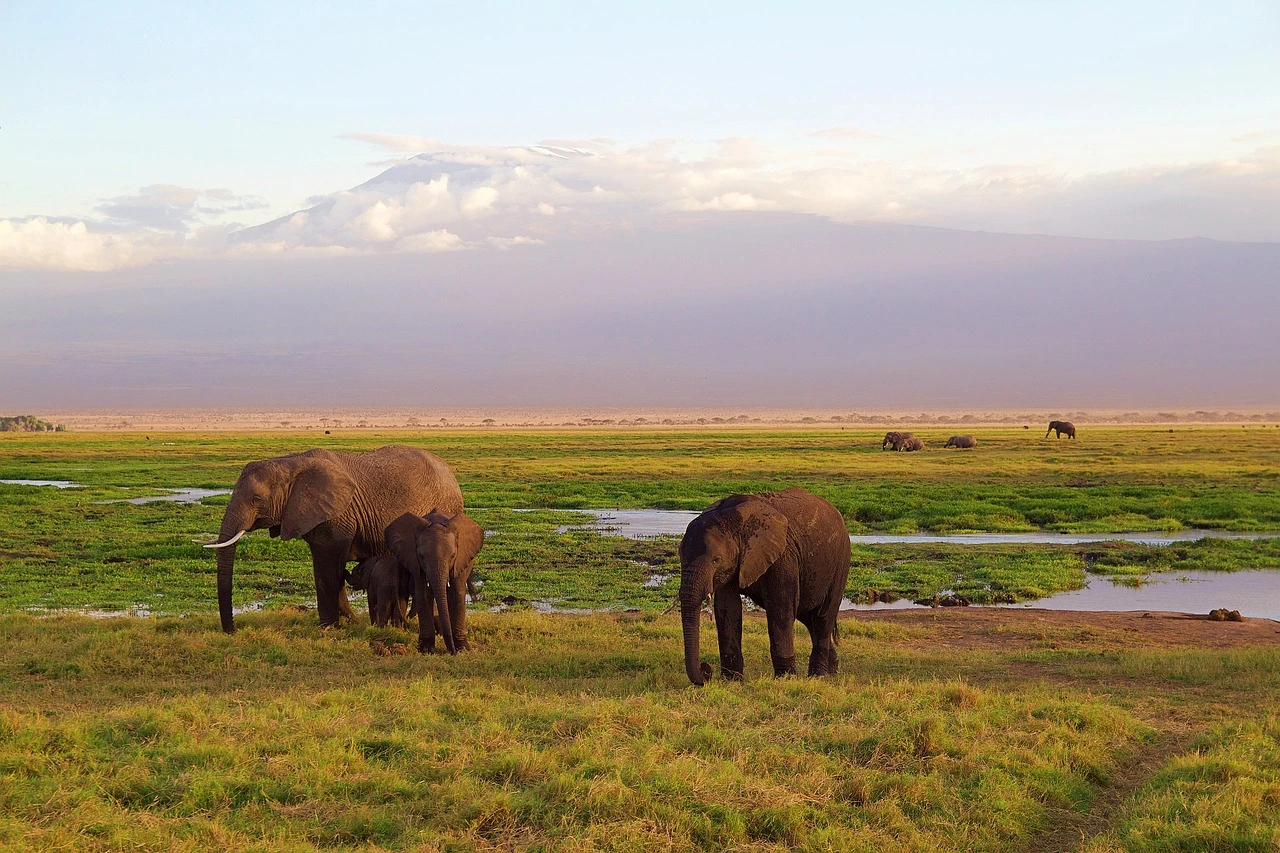
Next on our list is Amboseli National Park , where you can marvel at the majestic views of Mount Kilimanjaro, Africa’s highest peak. This park is famous for its large elephant population and rich cultural experiences in the local Maasai village.
A Kenya safari in Tsavo promises a journey through breathtaking landscapes, close encounters with gentle giants, and a deep dive into Maasai culture.
Elephant Encounters In Amboseli National Park
Imagine being just a few meters away from a magnificent African elephant as it grazes peacefully in its natural habitat. In Amboseli, you can have this unforgettable experience on guided game drives, where you’ll also spot other wildlife species such as lions, leopards, and buffalo.
Cultural Insights
Discover the rich Maasai culture by visiting traditional villages such as Ololaimutiek, Oloirien, and Kimana. Learn about their colorful garments, jewelry, warrior culture, and traditional ceremonies. Witness the Maasai’s unique way of life and gain a deeper understanding of their customs and traditions.
This immersive cultural experience is an essential part of your Maasai Mara National Reserve or Amboseli safari adventure.
Accommodation and Amenities
After a day of exploration, relax and unwind at one of Amboseli’s luxurious lodges or eco-friendly camps. From the stunning Tortilis Camp to the tranquil Amboseli Serena Safari Lodge , there are accommodations to suit all tastes and budgets. Enjoy the comforts and amenities these lodges offer, such as spacious rooms, private patios, refreshing swimming pools, and delightful dining experiences, as you bask in the beauty of Amboseli.
Adventure in Tsavo: East and West National Parks
Embark on an adventure in Tsavo East and Tsavo West National Parks, two of the largest and finest wildlife parks in Kenya. Known for their diverse landscapes, abundant wildlife, and variety of safari styles, these parks offer a unique and thrilling experience.
Our 3 days Tsavo safari is tailor-made to traverse you across the wild plains of Tsavo East and uncover the wonders of Tsavo West, showcasing the diverse offerings of these remarkable parks.
Kenya Tours to Tsavo East’s Wild Plains
Venture into the wild plains of Tsavo East, where you’ll encounter large herds of elephants, lions, and other wildlife species roaming freely in their natural habitat. This untouched wilderness is perfect for those seeking an authentic safari experience, away from the crowds.
The Wonders of Tsavo West
Discover the incredible wonders of Tsavo West, including the crystal-clear Mzima Springs, the mysterious Shetani Lava Flow, and the Ngulia Rhino Sanctuary.
Witness the rich biodiversity of this park on thrilling game drives, guided bush walks, and even underwater viewing at Mzima Springs.
With so much to explore, Tsavo West National Park is a must-visit destination on your Kenyan safari journey.
Safari Styles
Choose from a range of safari styles in Tsavo, from luxury lodges like the Severin Safari Camp to budget-friendly options such as the Murera Springs Eco Lodge. Whether you prefer the comforts of a luxurious tent or the thrill of a rustic camp, Tsavo offers a variety of accommodation options to suit your preferences and budget.
So, pack your bags and embark on an unforgettable safari adventure in Tsavo!
Lake Nakuru National Park: A Birdwatcher's Paradise

Attention bird lovers! Lake Nakuru National Park , famed for its spectacular flamingo gatherings, diverse wildlife, and dedicated conservation efforts, awaits your discovery. From spotting the vibrant pink flamingos to learning about the park’s efforts t protect endangered species, Lake Nakuru offers a unique and unforgettable experience for nature lovers and birdwatchers alike.
Flamingo Spectacle and More
Witness the incredible spectacle of thousands of flamingos lining the shores of Lake Nakuru, creating a breathtaking scene of vibrant pink against the clear blue waters. In addition to the flamingos, the park is also home to over 400 species of birds, including the White-backed Duck, Knob-billed Duck, and Egyptian Goose.
Grab your binoculars and camera, and let the birdwatching adventure begin!
Conservation Efforts
Lake Nakuru National Park is committed to protecting its diverse wildlife and maintaining the delicate balance of its ecosystem. Home to both white and black rhinos, the park serves as a sanctuary for these endangered species. Moreover, the park is part of the Lake Nakuru Conservation and Development Project (LNCDP), aiming to maintain ecosystem health in the catchment basin of Lake Nakuru.
Through these conservation efforts, the park strives to protect its natural diversity and economic value for generations to come.
Safari Options
Make the most of your visit to Lake Nakuru National Park by choosing from a variety of safari options, from guided game drives to birdwatching tours. Whether you’re an avid birdwatcher or simply looking for an unforgettable wildlife experience, Lake Nakuru offers a range of exciting activities to suit your interests. Additionally, consider exploring the nearby Lake Naivasha and Masai Mara Lake Nakuru for a more diverse experience.
So, gear up and embark on a thrilling adventure in this birdwatcher’s paradise.
The Hidden Gem of Meru National Park
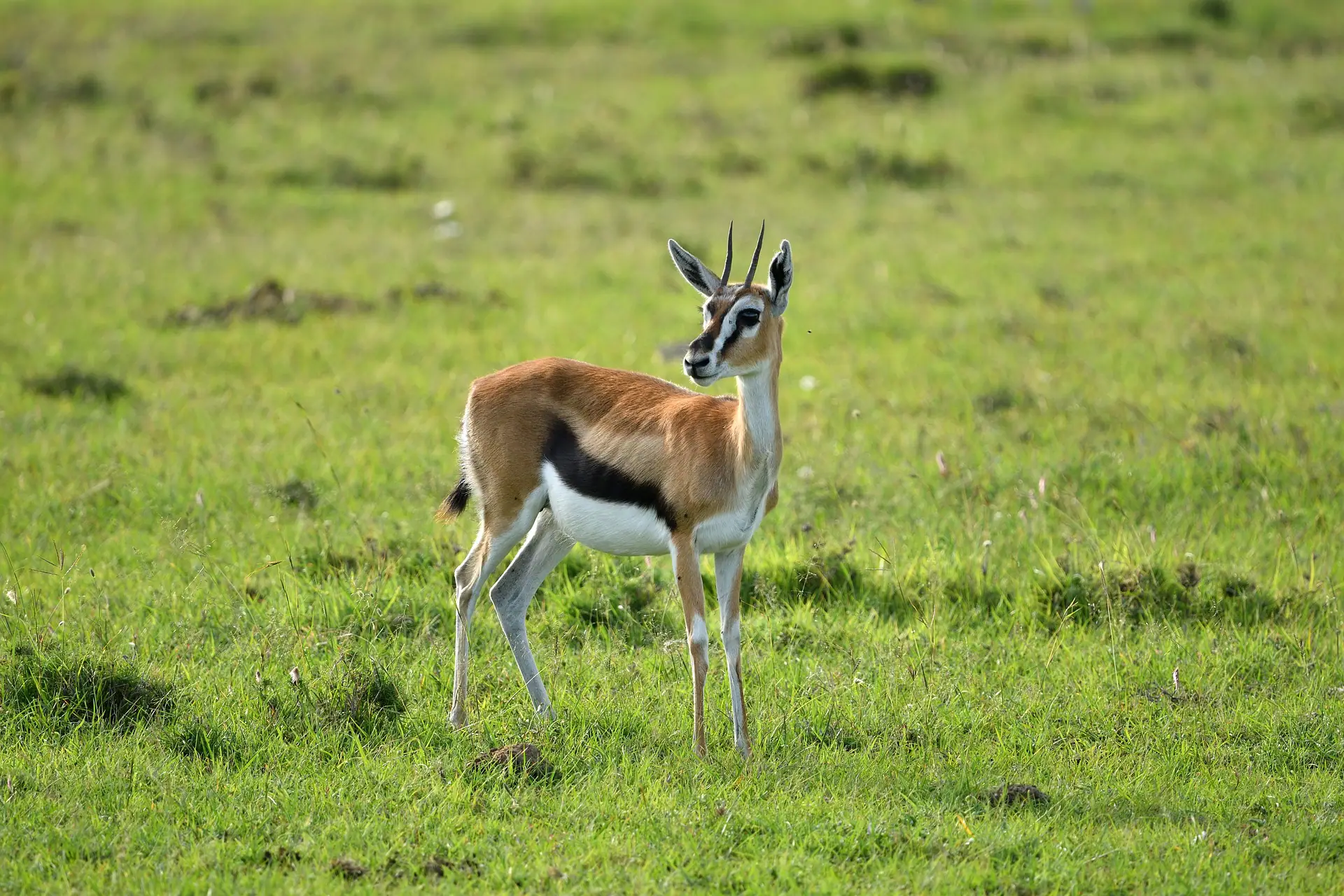
Uncover the hidden gem of Meru National Park, an untouched wilderness teeming with wildlife and rich in history. Home to a diverse range of wildlife species, including the Big Five, this park offers an authentic and intimate safari experience.
Trace the path of Elsa the lioness through her former home and delve into the pristine wilderness of Meru.
Untouched Wilderness
Step into the pristine wilderness of Meru National Park, where you’ll encounter a diverse range of wildlife, including:
- Various species of antelope
With over 500 species of wildlife, this park showcases the beauty and diversity of nature in an awe-inspiring and untouched setting.
Get ready to explore the rugged beauty of Meru, as you create memories that will last a lifetime.
Following Elsa’s Footsteps
Discover the inspiring story of Elsa the lioness, made famous by the book and film “Born Free,” as you explore her former home in Meru National Park. Raised by George and Joy Adamson, Elsa was taught to be wild and free before being successfully released back into the wild.
Her legacy continues to inspire generations of wildlife lovers and conservationists alike.
Staying in Meru
Enhance your safari experience by staying in one of Meru’s unique lodges or tented camps. From the luxurious Elsa’s Kopje Lodge to the tranquil Rhino River Camp, there’s something for everyone. Enjoy the comforts of these lodges, including delicious dining, refreshing swimming pools, and stunning views of the park, as you immerse yourself in the untouched beauty of Meru National Park.
Nairobi National Park: A Safari Within the City
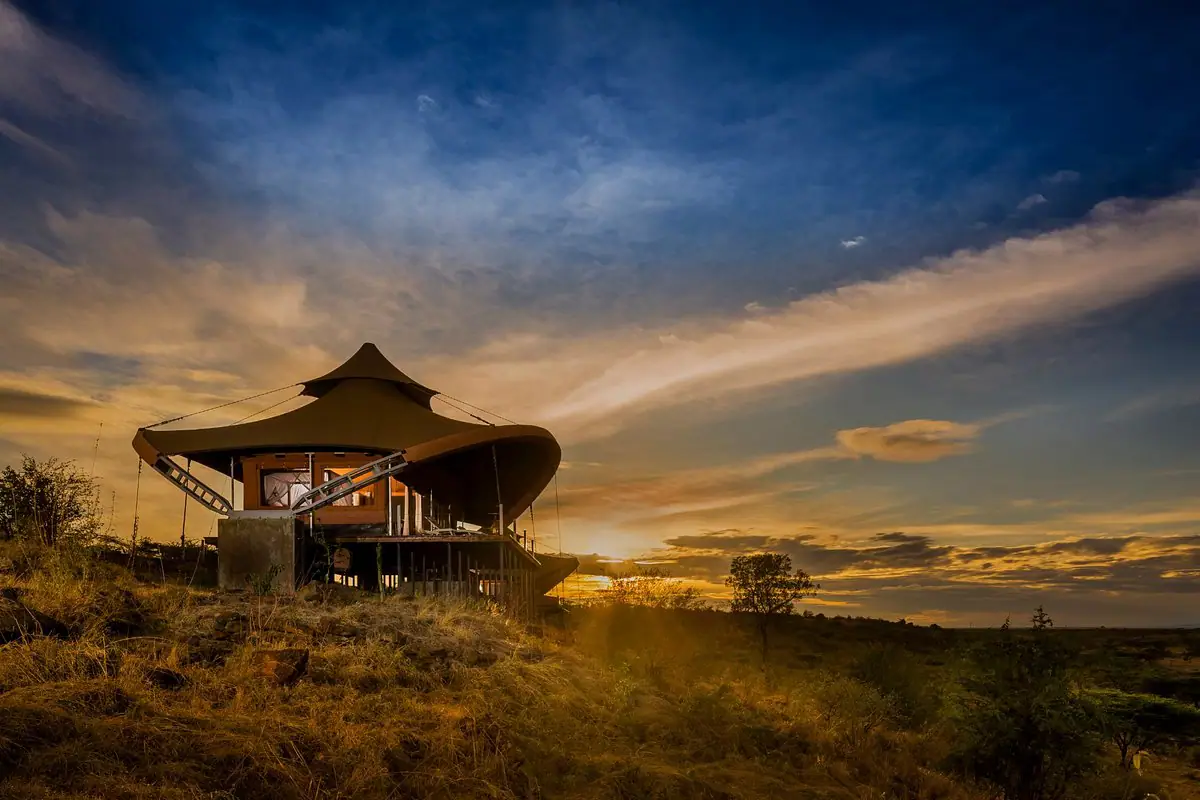
Imagine spotting a majestic lion or a graceful giraffe, all without leaving the city limits. Welcome to Nairobi National Park , a unique safari destination located just 7 kilometres away from Nairobi’s bustling city centre. Encounter a diverse range of wildlife and learn about conservation efforts in this urban oasis.
With thrilling game drives and visits to the Giraffe Centre and the David Sheldrick Wildlife Trust , Nairobi National Park promises an urban wildlife adventure that you won’t soon forget.
Urban Wildlife Adventure
Experience an urban wildlife adventure like no other in Nairobi National Park , where endangered black rhinos, lions, and other species roam within the park’s boundaries. Witness these magnificent creatures up close on guided game drives, as you explore the unique juxtaposition of city life and wild nature.
Don’t miss this incredible opportunity to connect with nature while staying in the heart of the city.
Conservation Up Close
Get up close and personal with conservation efforts at the David Sheldrick Wildlife Trust and the Giraffe Centre, both located within Nairobi’s city limits. Learn about the trust’s mission to protect and preserve Kenya’s wildlife , and hand-feed the endangered Rothschild’s giraffes at the Giraffe Centre.
These immersive experiences allow you to witness conservation in action, all within the urban environment of Nairobi.
Tour Packages
Choose from a variety of tour packages to explore Nairobi National Park, from half-day excursions to full-day adventures. Whether you want to focus on wildlife viewing , conservation efforts, or a combination of both, there’s a package to suit your interests and schedule. With expert tour guides leading the way, you’ll enjoy a memorable urban safari experience right in the heart of Nairobi .
Samburu National Reserve: Rare Species and Rugged Beauty
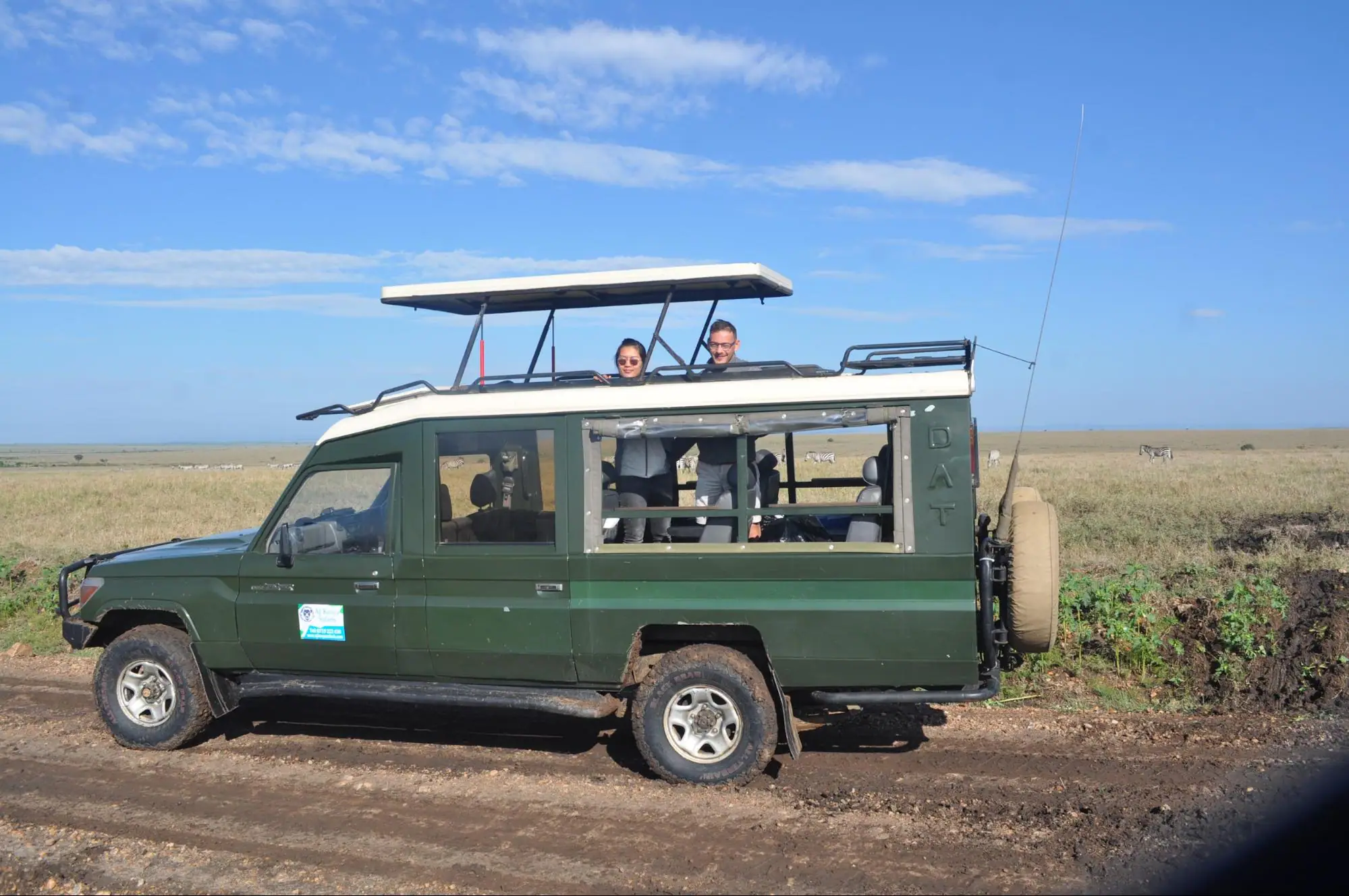
Discover the rugged beauty and rare species of Samburu National Reserve , a remote and pristine wilderness in northern Kenya. Encounter the Samburu Special Five, a unique collection of wildlife species found only in this region, and immerse yourself in the rich culture of the Samburu people.
Samburu National Reserve provides a truly authentic safari adventure, marked by thrilling wildlife encounters and unforgettable cultural experiences, away from the usual tourist trails.
Samburu’s Special Five
Spot the Samburu Special Five, a unique collection of wildlife species found only in this region, including:
- Grevy’s zebra
- Reticulated giraffe
- Somali ostrich
These rare and fascinating creatures add an extra layer of excitement to your safari experience, making your visit to Samburu National Reserve truly unforgettable.
Immersive Cultural Experiences
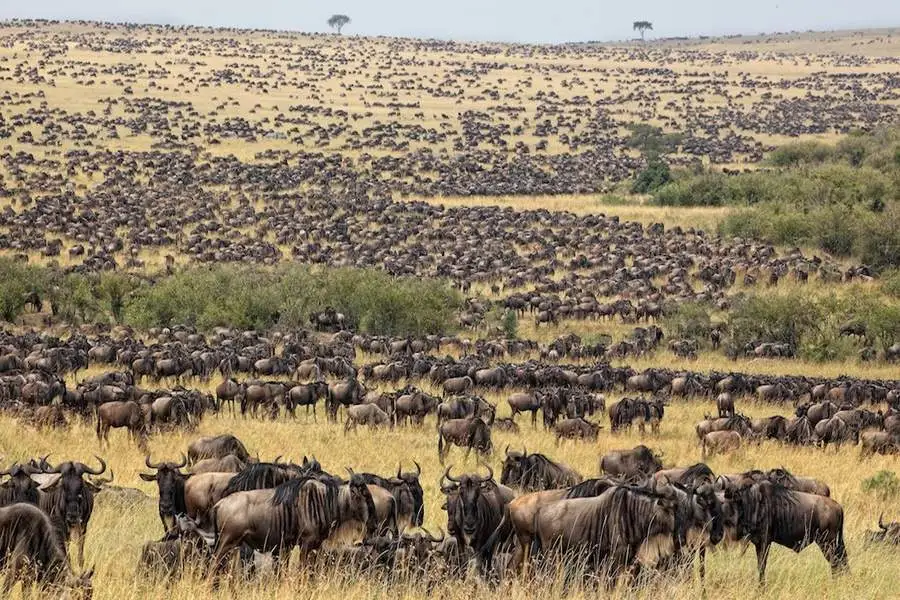
Experience the rich culture of the Samburu people by visiting traditional villages such as Ololaimutiek, Lorien, and Kimana. Learn about their vibrant traditions, fascinating religious practices, and remarkable way of life.
Witness the Maasai’s unique customs and gain a deeper understanding of their history and culture during your visit to Samburu National Reserve.
Safari Lodgings
Choose from a range of safari lodgings in Samburu, from the luxurious Sasaab tented camp to the eco-friendly Saruni Rhino lodge. Whether you prefer the comforts of a well-appointed tent or the intimacy of a rustic camp, Samburu offers an unforgettable stay tailored to your preferences and budget. So, pack your bags and embark on an adventure in the rugged beauty of Samburu National Reserve.
Beach and Bush: Combining Safari with Coastal Relaxation

Consider blending the exhilaration of a safari adventure with the tranquillity of a beach retreat. Kenya’s stunning coastline offers pristine beaches and charming coastal retreats, the perfect way to unwind after an exhilarating bush experience.
Discover the best of both worlds as you explore Kenya’s incredible wildlife reserves and indulge in some well-deserved rest and relaxation.
Safari Itineraries
Choose from a variety of safari itineraries that combine the best of Kenya’s wildlife reserves with time spent relaxing on the country’s beautiful beaches.
- Masai Mara National Reserve
- Samburu National Reserve
- Diani Beach
- Lamu Island
Experience the thrill of Kenya’s diverse wildlife on one of our Kenya safari tours before retreating to the blissful shores of these Kenya safari destinations. The perfect blend of adventure and relaxation awaits you in East Africa, particularly in Kenya.
Coastal Retreats
Unwind at one of Kenya’s coastal retreats, offering the perfect blend of relaxation and adventure after your safari. From luxury resorts to charming guesthouses, Kenya’s stunning coastline boasts a variety of accommodation options to suit all tastes and budgets.
Soak up the sun, explore the azure waters, and indulge in delicious local cuisine as you create memories that will last a lifetime.
Africans Safaris in Kenya - Final Verdict
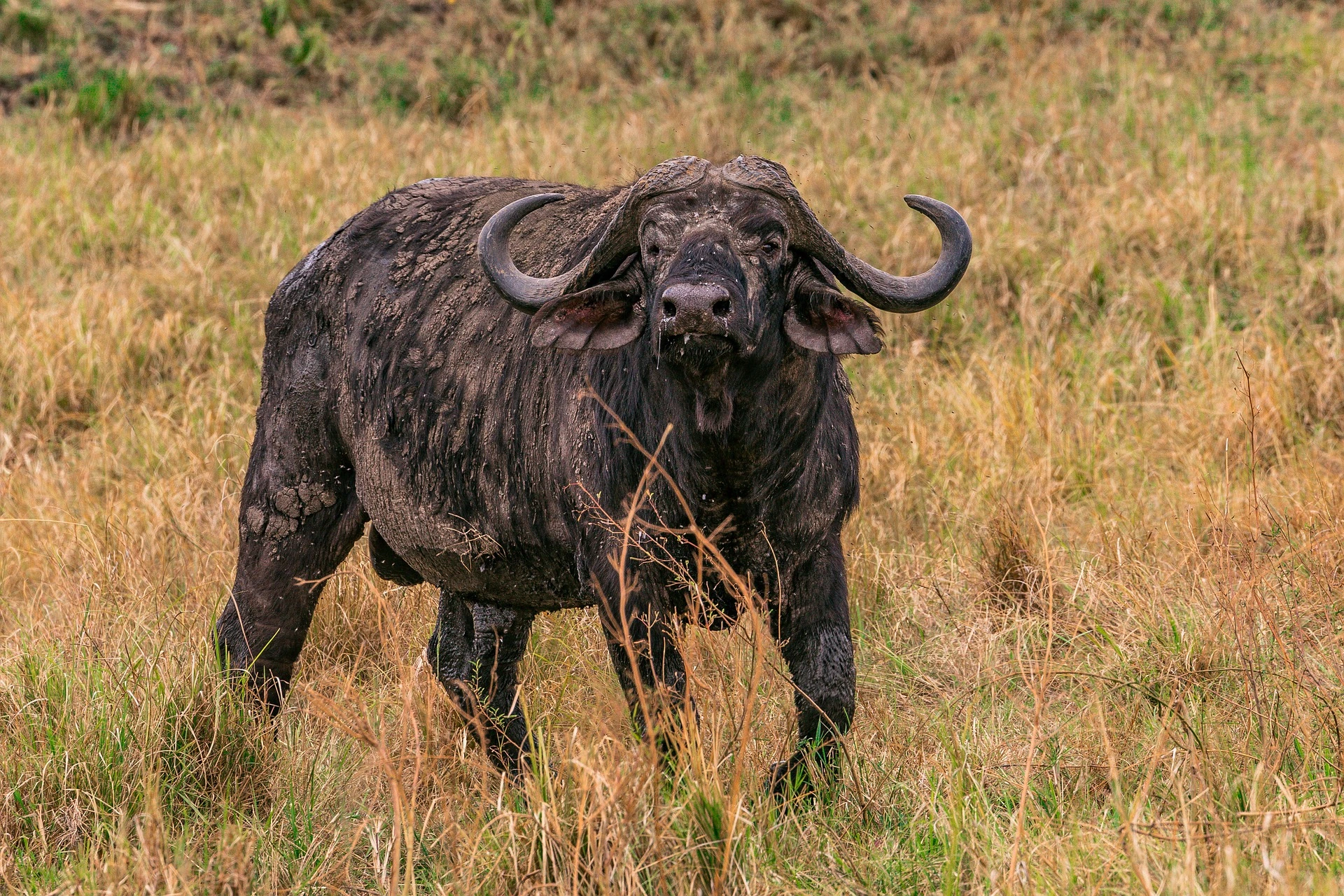
From the iconic Masai Mara National Reserve to the pristine beaches of Kenya’s coastline, this blog post has guided you through the top 10 unforgettable safaris in Kenya for 2023.
Whether you’re a wildlife enthusiast, a culture lover, or simply seeking the adventure of a lifetime, Kenya offers a diverse range of experiences that will leave you with memories to cherish forever. Embark on your Kenyan safari adventure and discover the magic of this incredible East African destination.
Safari Kenya Packages – Key Takeaways
- Explore the iconic Masai Mara National Reserve and witness the Great Migration & big cats on game drives!
- Experience majestic views of Mt. Kilimanjaro, elephant encounters, unique Maasai culture & luxurious lodgings in Amboseli!
- Discover Lake Nakuru’s flamingos, Tsavo East/West wildlife parks, Meru National Park’s untouched wilderness & Nairobi safari within city limits for an unforgettable experience!
Frequently Asked Questions
The most common questions we get about planning African safaris in Kenya include: What is the best Kenya safari? How much does a safari cost in Kenya? What is the best time to go on a safari in Kenya ? How much is a safari in Kenya UK? Next, we look at each of these questions in detail:
How much does a safari cost in Kenya?
Planning a safari in Kenya? Costs can range from £600 to £2000 per person per night, depending on the type of experience you’re after. Get ready to explore with a budget tailored to your needs!
Where is the best Kenya safari?
Experience the wonders of the African wild like never before in Kenya’s incredible Safari Parks and Reserves! With some of the best wildlife experiences to offer, you’ll be sure to have an unforgettable journey! Consider visiting Maasai Mara National Reserve, Tsavo East National Park, Lake Naivasha, and Samburu National Park. You might also love your trip to Aberdare National Park , Ol Pejeta Conservancy
What is the best time to go on safari in Kenya?
Experience Kenya’s incredible wildlife any time between June and October. For an even more amazing safari, plan your trip around the wildebeest migration across the Masai Mara in early September.
How many days is enough for a Kenya safari?
For a great safari experience in Kenya , aim for 7-15 days to enjoy beaches, national parks, wildlife sanctuaries, and culture. Even a minimum of 4 days and three nights at the Masai Mara will provide you with four-game drives to explore the wildlife.
What is the best time of year to see the Great Migration in the Masai Mara?
Experience the thrill of the Great Migration in the Masai Mara from July to October – a spectacle you won’t want to miss!

A 10-Day Safari Itinerary in Kenya.
- October 31, 2023
- trek Afrika

A 10-day safari itinerary in Kenya is not just a journey; it’s a profound immersion into the heart of Africa. It’s a chance to witness the circle of life in action, from predators on the prowl to the great wildebeest migration across the Mara River. It’s an opportunity to capture stunning photographs of majestic elephants against the backdrop of Mount Kilimanjaro, and to feel the thrill of tracking elusive leopards through the thicket.
Day 1: Nairobi – The Gateway to Kenya
The Journey Begins
Your safari adventure commences in Kenya’s bustling capital, Nairobi. Spend your first day exploring the city’s rich history and vibrant culture. Visit the Karen Blixen Museum, delve into the Nairobi National Museum, and don’t forget to feed the gentle giraffes at the Giraffe Centre. Stay overnight at a charming Nairobi hotel to recharge for the adventure ahead.

Day 2: Samburu National Reserve – Land of the ‘Special Five’
Kenya Wildife
Depart Nairobi for the Samburu National Reserve, a haven for Kenya’s “Special Five” wildlife species. Witness unique animals like Grevy’s zebra, reticulated giraffe, and the elusive Beisa oryx. Enjoy a game drive and relax in your luxurious lodge overlooking the Ewaso Ng’iro River.
Day 3: Samburu National Reserve – Exploring the Wilderness
Captivating Samburu
A full day of wildlife encounters awaits you. Explore the reserve’s pristine wilderness, capturing iconic images of elephants and lions against the backdrop of the Ewaso Nyiro River. As the sun sets, enjoy a bush dinner under the starlit African sky.
Day 4: Mount Kenya – The Majestic Peaks
Up in the Clouds
Travel to Mount Kenya, Africa’s second-highest peak. Hike through lush forests, spot unique birdlife, and savor the serene beauty of the mountain. Stay in a luxurious lodge with breathtaking mountain views.
Day 5: Ol Pejeta Conservancy
Conservation at its Best
Visit the Ol Pejeta Conservancy, home to the last two Northern White Rhinos on Earth. Enjoy a game drive through the conservancy, where you might also spot the “Big Five.” Spend the night in a luxurious tented camp surrounded by nature. Ol Pejeta is committed to wildlife conservation, and you can visit the Endangered Species Enclosure, which houses endangered species like the northern white rhino. Learn about the conservation efforts and maybe even witness these magnificent animals up close.
Day 6: Lake Nakuru – A Birder’s Paradise
Wings and Waters
Drive to Lake Nakuru, a haven for birdwatchers. The lake is adorned with pink flamingos and a plethora of other bird species. Don’t forget to explore the surrounding parkland, where you may encounter the rare white rhino. Enjoy a comfortable overnight stay at a lodge by the lake.

Day 8: Maasai Mara – The Crown Jewel of Safaris
The Grand Maasai Mara
Drive to the iconic Maasai Mara, Kenya’s most famous safari destination. Experience thrilling game drives, seeking the Big Five and the Great Migration. Stay at a luxurious Maasai Mara lodge to savor the wilderness at its best.
Kenya Wildlife Sfari Itinerary
Day 9: Maasai Mara – A Day of Wildlife Marvels
Wild Encounters
Another day in Maasai Mara for unrivaled wildlife viewing. Witness the untamed beauty of the African savannah, and perhaps even a Mara River crossing. Prepare for a farewell dinner under the African stars.
Day 10: Maasai Mara to Nairobi – Farewell Kenya
Bid farewell to Maasai Mara and return to Nairobi, reminiscing about the incredible journey you’ve had. Optionally, explore the Kazuri Beads Women’s Cooperative or visit the David Sheldrick Wildlife Trust to see orphaned elephants before departing.
Exploring Kenya’s National Parks in 10 Days
But it’s not just the natural wonders that make this safari exceptional. It’s the warm smiles of the local people, who share their stories and traditions with open hearts. It’s the vibrant colors of the Maasai beadwork and the rhythmic sounds of traditional dances that offer a glimpse into the rich cultural tapestry of Kenya.
As your 10-day Safari itinerary in Kenya comes to a close, you’ll find yourself profoundly changed. The memories etched into your heart will serve as a constant reminder of the fragility and importance of our natural world. You’ll return home with a deeper understanding of the delicate ecosystems that sustain life on Earth and a stronger commitment to conservation and responsible tourism.
In conclusion, a 10-day safari itinerary in Kenya is an adventure that goes beyond the physical boundaries of the country. It’s a spiritual journey that connects you with nature, humanity, and the timeless rhythms of the wild. It’s a transformational experience that leaves an indelible mark on your soul and leaves you yearning to return to Kenya’s wild beauty.
FAQs How much does a 10 day safari cost in Kenya?
1. Budget Safaris: Budget safaris typically involve basic accommodations and may cost anywhere from $1,200 to $2,800 per person for a 10-day safari. These options may involve camping or staying in more modest lodges. 2. Mid-Range Safaris: For mid-range safaris with more comfortable accommodations and services, you can expect to pay anywhere from $3,000 to $6,000 per person. 3 . Luxury Safaris: Luxury safaris in Kenya can range from $6,000 to $10,000 or more per person. These often include high-end lodges, gourmet meals, and additional services.
How many days is enough for a Kenya safari?
The ideal duration for a Kenya safari can vary depending on your interests, budget, and the specific wildlife and experiences you want to encounter. However, here are some general guidelines for the duration of a Kenya safari: Short Safaris (2-4 Days): Short safaris are ideal for travelers with limited time or those looking to focus on a specific area or wildlife.You can enjoy a brief safari experience in a single national park or reserve, such as the Maasai Mara or Amboseli National Park. These shorter safaris are often more budget-friendly. Standard Safaris (5-7 Days): A 5 to 7-day safari is a common choice for most travelers, as it allows you to explore multiple parks and reserves and experience a variety of wildlife and landscapes. This duration allows you to visit different regions of Kenya and increases your chances of seeing a wide range of animals. Extended Safaris (10+ Days): If you have more time and a greater budget, an extended safari of 10 days or more can provide a more comprehensive and immersive experience. You can explore more remote and less-visited areas, spend more time observing wildlife, and include additional activities, such as cultural visits.
Which is the Cheapest Safari in Kenya?
The cost of a safari can vary widely, and the price depends on various factors, including the destination, duration, type of accommodation, level of comfort, and the specific tour operator you choose. If you’re looking for a more budget-friendly safari option, consider the following: 1. Self-Drive Safaris: One of the more cost-effective ways to go on a safari is to plan a self-drive safari in a national park or wildlife reserve where it’s allowed. You can rent a 4×4 vehicle and camping equipment, reducing the cost of accommodations. Keep in mind that this option requires you to have some experience in self-driving in the wilderness. 2. Group Tours: Joining a group safari with a reputable tour operator can often be more cost-effective than a private safari. Group tours allow you to share expenses with other travelers. 3 . Budget or Mid-Range Accommodations: Choose budget or mid-range accommodations like tented camps or lodges rather than luxury lodges. These options can significantly reduce the cost of your safari while still providing comfortable lodging. 4. Shorter Duration: Consider a shorter safari, such as a 2-4 day safari, which can be more budget-friendly than longer trips. 5. Off-Peak Season: Travel during the off-peak or shoulder seasons when accommodations and tour prices may be lower. However, keep in mind that wildlife sightings might not be as abundant during these times. 6. Local Tour Operators: Consider booking your safari with local tour operators based in the destination, as they may offer more competitive prices compared to international tour companies.
What to do in Kenya in 10 days?
Day 1: Arrival in Nairobi Arrive in Nairobi, the capital of Kenya. Explore the city’s attractions, including the Karen Blixen Museum, Giraffe Centre, and David Sheldrick Wildlife Trust. Enjoy a traditional Kenyan dinner at a local restaurant. Day 2: Nairobi to Amboseli National Park Drive or fly to Amboseli National Park, known for its stunning views of Mount Kilimanjaro. Go on a game drive to spot elephants, lions, zebras, and more. Stay in a lodge or tented camp within the park. Day 3: Amboseli National Park Spend the day exploring Amboseli and capturing photos of the iconic wildlife with Mount Kilimanjaro in the background. Visit Observation Hill for panoramic views of the park. Day 4: Amboseli to Tsavo West National Park Depart for Tsavo West National Park, famous for its scenic landscapes. Visit Mzima Springs, a natural spring with underwater viewing points for hippos and fish. Explore Chaimu Crater and Shetani Lava Flow. Day 5: Tsavo West to Tsavo East National Park Travel to Tsavo East National Park, the largest national park in Kenya. Enjoy game drives in search of diverse wildlife, including the “Red Elephants” of Tsavo. Relax at your chosen accommodation within the park. Day 6: Tsavo East to Mombasa Leave Tsavo East and drive to the coastal city of Mombasa. Explore Fort Jesus, Old Town, and the vibrant markets. Relax on the beautiful beaches or take a dhow cruise. Day 7: Mombasa to Diani Beach Head to Diani Beach, a popular beach destination. Enjoy water sports, relax on the white sandy beaches, and explore the surrounding area. Day 8: Diani Beach Spend a full day at leisure on Diani Beach, taking in the sun and sea. Consider activities like snorkeling, diving, or visiting a nearby marine reserve. Day 9: Diani Beach to Maasai Mara Fly or drive to the world-famous Maasai Mara National Reserve. Go on a game drive to witness the incredible wildlife, including the Great Migration if visiting during the migration season. Stay at a lodge or tented camp within the reserve. Day 10: Maasai Mara Spend the day exploring the Maasai Mara, with morning and afternoon game drives. Experience the unique culture of the Maasai people by visiting a local village. Depart from Maasai Mara and head back to Nairobi for your departure.
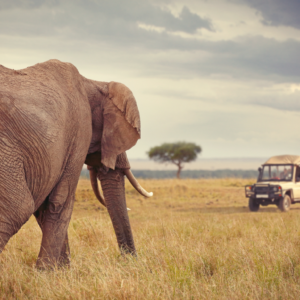
How to Plan Your First Safari to Kenya in 2024
Plan Your First Safari to Kenya in 2024 Kenya, often referred to as the “Safari Capital of the World,” is a land of awe-inspiring landscapes
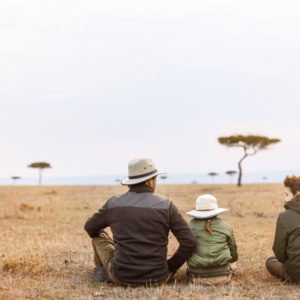
Exploring the Magic of Kenya with Kids in 2024
Exploring the Magic of Kenya with Kids in 2024 Envision your family surrounded by the mesmerizing landscapes of Kenya, with endless plains stretching to the

Embrace the Magnificence of the 2023/2024 Kenya Safari with the Great Wildebeest Migration!
Embrace the Magnificence of the 2023/2024 Kenya Safari with the Great Wildebeest Migration in Maasai Mara. The enchanting wilderness of Kenya offers a multitude of

Exploring the Wonders of Kenya on a Budget Camping Safari.
Prepare to embark on an extraordinary adventure through the heart of Africa as we delve into the captivating realm of exploring the wonders of Kenya
Send Us A Message
+254 725 925339, email for us, [email protected].
- Tours and Safaris
- Terms and Conditions
- Privacy Policy
TOUR CATEGORY
- Adventure Safaris
- Bush & Beach Safaris
- Cross Border Safaris
- Cultural Safaris
- Family Safaris
- Kenya Big Five Safaris
- Romantic Holidays
SECURE PAYMENT

Copyright 2024 © Trek Adventures. Design and developed by Wayne graphics Solutions
- All Tailor Made Safaris
- Kruger National Park
- Okavango Delta
- Gorilla Trekking
- Safaris with Frank
- Republic of the Congo
- South Africa
- All Set Departures
- All Set Departures by Date
- Horse Safaris
- Photographic Safaris
- Unique Safaris
- Year-round Safaris
- Botswana Mobile Safaris
- Volunteering
- View all Destinations: Interactive Map
- Mobile Safaris
- Gorillas & Chimps
- Walking Safaris
- Horse Back Safaris
- All Training Courses
- All Training Courses by Date
- Professional Courses
- Short Courses
- Special Courses
- Training Camps
- Field Guide Training FAQ’s
- Accommodation
- When to Travel
- Frank’s Top 5
- Who is Travelling
- First Time to Africa
- Specials and Promotions
- Cost of a Safari
- Breakfast with Elephants
- Gesa and Frank’s Story
- Lion Hearts
- Our partners
- Our vehicles: Beauty and the Beast
- Project Summary: Ride 4 A Woman
- Sustainability
- Why book with Us
- Travel Info
- Guest Reviews
- Price guarantee

Tailor Made Safaris
Popular safaris, east & central africa, southern africa, set departures, top destinations, indian ocean islands, “kenya offers so much more than karen blixen’s ‘out of africa’”.

“The Masai Mara is the most photogenic safari location in Africa and the country offers a huge variety, both in landscapes and inhabitants!”
Discover the diversity of kenya safaris: a world of wildlife and wonder.
Kenya safaris has it all; from the tropical coral seas and white beaches of the Indian Ocean to the colder climate of the western highlands, from the dry savannahs of the south to the semi-desert around Lake Turkana in the north. This variety allows for many different safari options and exceptional experiences for all travellers.
The Masai Mara National Reserve: The Heart of the Serengeti-Mara Ecosystem
The most famous location is the Masai Mara National Reserve, part of the huge Serengeti-Mara ecosystem and home to the highest concentration of large wildlife on the planet! The annual migration of over 2 million wildebeest and many zebra is ongoing throughout the year. The herds move in a generally clockwise route across the plains of the Serengeti and the Mara following the rains. The famous Mara River crossings usually take place in both Kenya and Tanzania from July to October each year, in a spectacle often referred to as the greatest show on earth!
High Altitude Safaris: Cooler Climate and Low Malaria Risk
From a traveller’s perspective, an important fact is that many safari destinations in Kenya are at a high altitude, around 2000m above sea level. This results in two significant benefits, compared to other safari destinations:
1) it doesn’t get as hot as it can in other regions, in fact, it could be chilly a night, which is great!
2) there is a really low risk of malaria in these high-altitude areas, making for a good destination for families with small children.
Kenya’s Wildlife Conservation Success: A Ban on Trophy Hunting
Another very interesting aspect to Kenya is that a trophy hunting ban has now been in place for more than 40 years. This has resulted in wildlife being trusting of vehicles, making them more approachable in certain areas. As good genes in terms tusk and horn size have been retained rather than selected for hunting, there are some magnificent specimens of certain animals!
SAFARI FRANK does not support overly close interaction with some animals such as cheetah’s climbing on vehicles. However, respectfully sharing space with relaxed large animals is a fantastic experience, not possible in many other places.
The Conservancy Model: A Win-Win for Wildlife and Communities
Kenya also boasts another great conservation success story- the Conservancy model in which private companies and local community landowners collaborate in conservation. There are a number of different examples in operation, but in essence, the local communities agree to make the land available for conservation and eco-tourism in exchange for revenue, employment and even grazing benefits. These models do sometimes result in tourists seeing wildlife and cattle in close proximity. However, this is a small price to pay as the reality is that was it not for this arrangement, there would have been no wildlife in these areas at all and much more pressure on the National Parks. The method also allows for traditional pastoralist cultures to thrive. A great outcome for all!
A kenya video to inspire your safari:
Fast facts about kenya.
- Kenya is home to around 55 million people comprising of more than 40 different tribal cultures.
- The safari as we know it was invented here. Safari is the Swahili word for journey.
- An over 40-year ban on hunting has resulted in animals being very approachable.
- The equator runs through the country, as does the Great Rift Valley.
- Huge variety in terrain from white beaches to highlands of the up-country.

Why we like Kenya as a safari destination:
- The long history of safari culture and the close-knit safari community.
- The conservancies are great conservation models working with local communities to ensure that they receive real benefits.
- It is home to reserves at high altitudes reducing the risk of malaria for children.
- The varied landscapes-from the famous Masai Mara to the WILD Lake Turkana, Kenya has it all!
- The Masai Mara Reserve, the most photogenic safari destination on earth!
- The easy access from the United States and Europe with direct flights to Nairobi.
Explore Kenya: From the Masai Mara to Nairobi
We have divided Kenya into 6 safari regions, namely the Masai Mara and private conservancies, Laikipia, Amboseli & Tsavo, Northern Kenya, the Kenyan coast and Nairobi.
Safaris in Kenya take place almost exclusively by flying between these locations through scheduled flights leaving from Nairobi. A typical safari would visit three of the locations, with one of them being the Mara, especially for first-timers!
Kenya has a long history as a safari destination and has been made famous by numerous writers, movies and TV shows over the years. It is well loved for its hospitality, many family-owned safari operators and excellent service!

Amboseli, Chyulu and Tsavo

Kenyan Coast

Northern Kenya

The Masai Mara
Kenya safaris, 10 nights kenya safari & beach holiday.

11-Day Kenya Fly-In Safari With Diani Beach

Tanzania & Kenya Highlights Safari

15-Night East Africa & Seychelles Escape
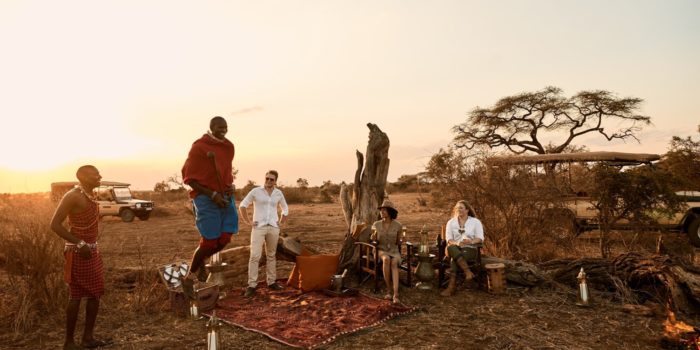
3- to 7-Day Tusitiri Dhow Sailing, Lamu to Kiwayu

Luxury Mobile Safari Chyulu Hills and Tsavo
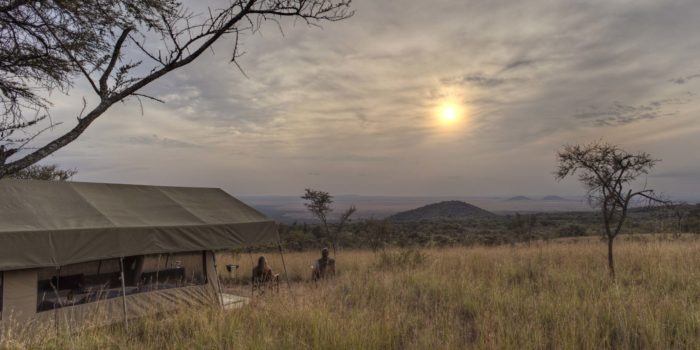
Kenya SkySafari – Amboseli, Laikipia & Masai Mara
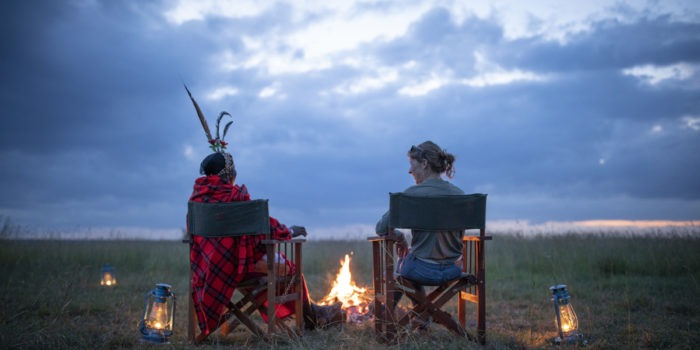
Mountain Bike from Nairobi to the Masai Mara
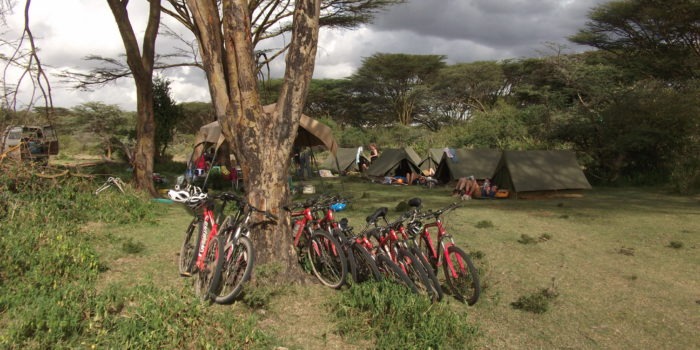
Mountain Bike the Masai Mara

Kenya & Tanzania Combined Safari
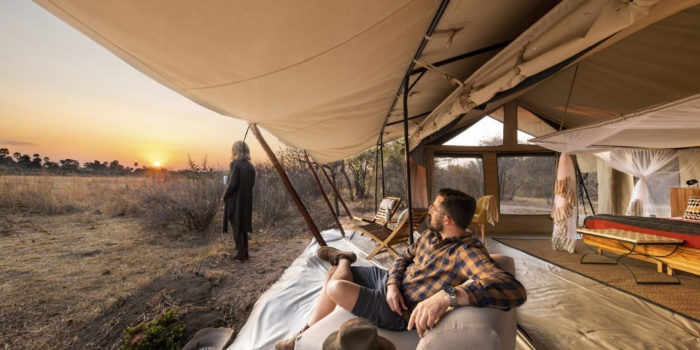
Kenya Classic Safari & Zanzibar
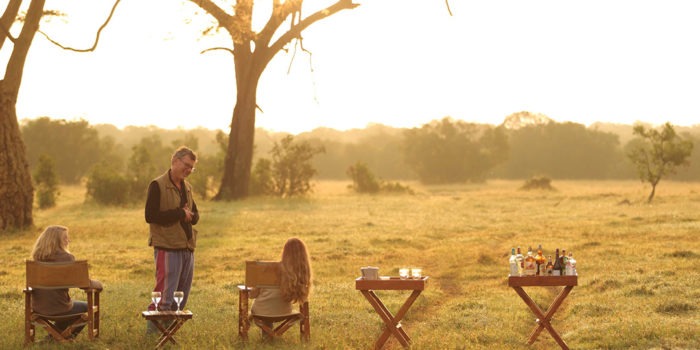
Kenya Classic Safari
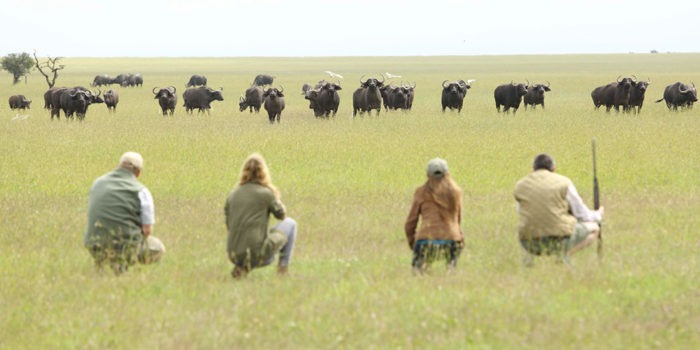
6 Night Laikipia Mobile Walking Safari
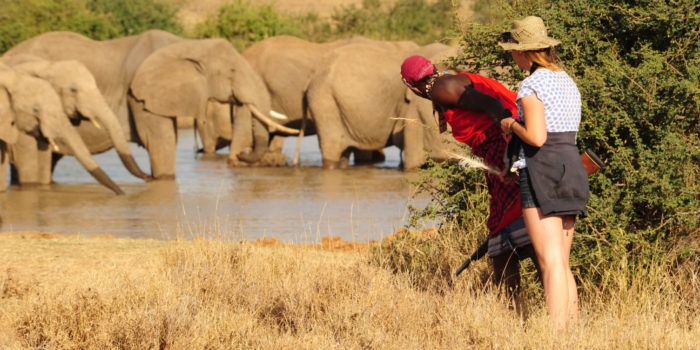
Traverse Laikipia on Foot
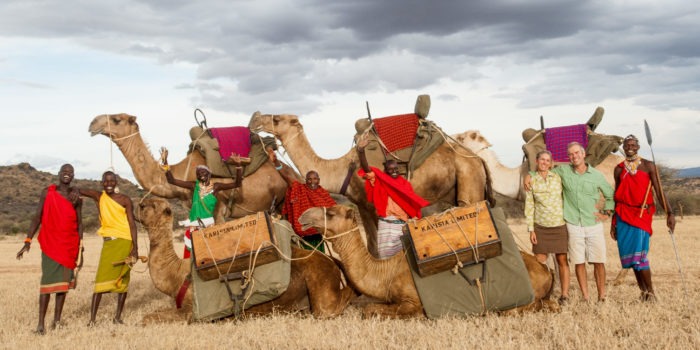
Luxury Kenyan Bush and Beach Honeymoon
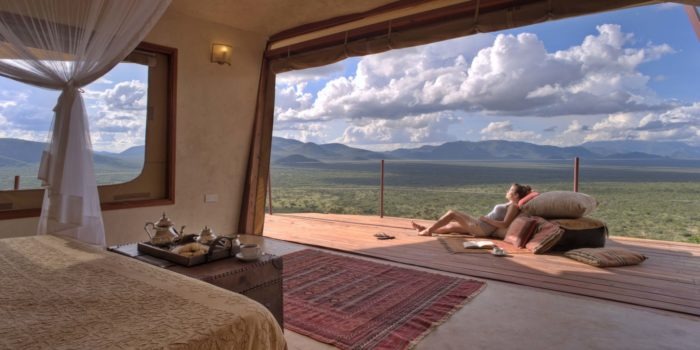
Kenya’s Wild North and Beach Adventure
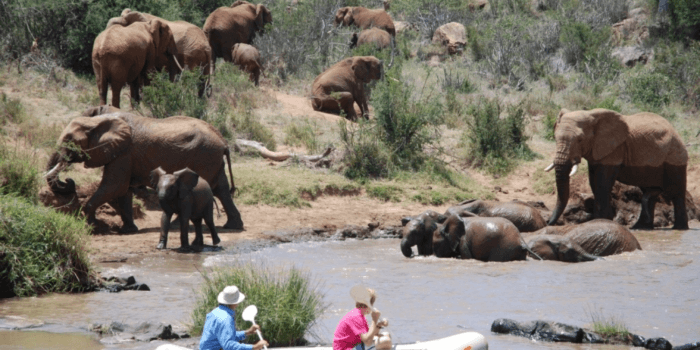
Ultimate Exclusive Use Kenyan Safari
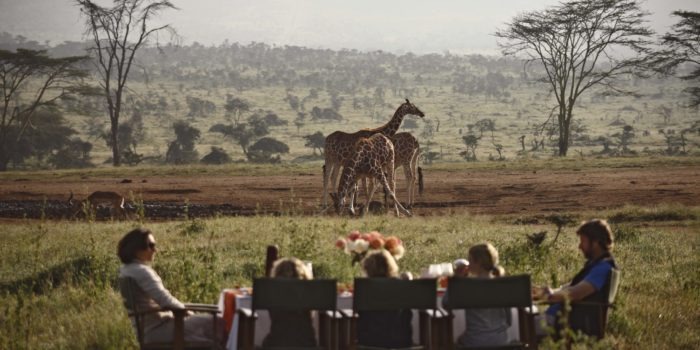
The Great Kenyan Luxury Adventure Safari
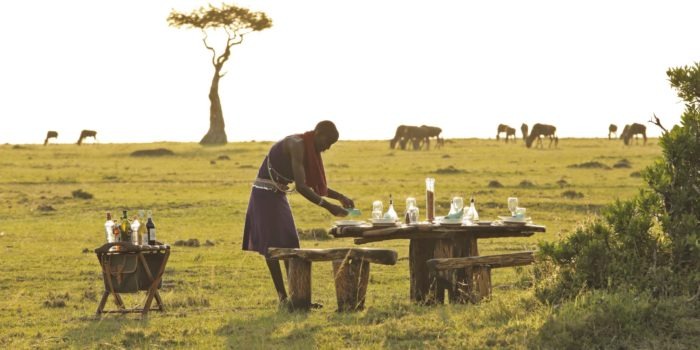
When to Go on a Safari in Kenya
Kenya is on the equator and as such there can be some variations in weather. It also comprises of some safari locations with high elevations, up to 2000m above sea level, which results in mild to chilly temperatures at these locations year-round. In certain areas, notably Laikipia, it is not uncommon to have a lit fireplace in your room, year-round. Visitors to these areas are often surprised at how cold it can be and warm clothes are recommended for game drives.
Kenya, similar to Tanzania, has four main seasons. It is considered an all-year destination, but the season you visit will greatly impact your experience, so be sure to choose the correct season for the experience you would like.
The ‘long rainy season’ (March, April & May)
This is when Kenya receives the majority of its rainfall and it is fairly consistent each year. Rain typically falls in heavy downpours each afternoon. Safaris at this time of the year can be complicated as road conditions deteriorate and animals disperse from water sources. If you go on safari during this time you may get a bit wet and muddy, but it is all part of the fun!
On the plus side, many baby animals are born, the skies are at their prettiest and environment is bursting with new life. It’s also the quietest time of year to travel so you will have an exclusive experience and the lack of other travellers results in great deals to be had.
The ‘short rainy season’ (November & December)
These rains are not as intense as the main rainy season and can be unpredictable and vary considerably from year to year. A safari at this time of the year can be very enjoyable provided you don’t mind the chance of a little rain.
The ‘long dry season’ (June to October)
This is the peak season for tourism in Kenya and rainfall is unusual with days normally clear and sunny. Keep in mind that temperatures vary depending on location and altitude. In high altitude areas like the Masai Mara and Laikipia, it may be pretty cold, especially on early morning game drives! This is considered the best time for a safari as animals congregate around water sources, making their viewing more predictable.
Between August and September, the annual wildebeest migration starts to cross the Mara River, an event which is on many traveller’s bucket list!
The ‘short dry season’ (January & February)
This is the period between the short and long rainy seasons and rain cannot be totally ruled out. It is, however, a great time of the year to travel. Many areas are still green from the short rains, so photographs are clear, crisp and will have vibrant colours. Birding is also at its peak as migratory birds have now arrived.
Read more about best seasons to travel to different regions in Africa.
More about when to travel

Kenya Safari Insider Tip
Stay in the private conservancies around the Masai Mara National Reserve, away from the crowds and where your stay will contribute directly to the conservation of the area!
Most of the lodges in the conservancies offer day trips into the Reserve to experience the migration’s river crossings if that is on your bucket list. In the conservancies it is also possible to drive off-road, conduct night-drives and do walking safaris, adding other dimensions to the experience.
Ready for an adventure? Lets Talk!
Contact SAFARI FRANK to get started on your safari of a lifetime!
Our partners in Africa will make your dream trip, a trip to never forget
[email protected] +44 (20) 45193234

Developed by Viewport / WordPress Guys
Travel Information:
- COVID SAFE Safaris
- How much does a safari cost?
- The Wildebeest Migration
- The Okavango Delta
Who is Travelling?
- Couples and Honeymooners
- Family Safari
- Group of Friends
- Solo Travellers
Who Is Travelling
- All Safaris
- Set Departure Safaris
- Safari Trip Ideas
- Horseback Safaris
- Selfdrive Safaris
Newsletter Signup
Enquire now.
" * " indicates required fields
Privacy Overview
Is Kenya Expensive to Visit? (My Advice as a Local)
If you are reading this article, an African safari must be on your bucket list. However, one thing that may be holding you back is the assumption that it’s probably too expensive for you to travel to Kenya or one of the other Safari destinations. So, in this article, I will help you answer the question: Is Kenya Expensive to Visit? And provide you with the information you need to save money on your trip to Kenya.
Kenya is an expensive country to visit. It can cost you upwards of $4000 to visit Kenya. However, You can make it more affordable if you avoid attractions visited often by international tourists. If you will be going on a safari, you can save money by booking your safari when you arrive in Kenya and negotiate with the safari company to get a good deal. Let me break down the cost of visiting Kenya and give you some local knowledge to help you spend wisely when you come to Kenya.
How much you will spend per day when visiting Kenya
Cost of a safari.
You can find a wide range of pricing options when going on a Kenyan safari but the least you expect to spend when going on a safari in Kenya is:
- Budget Safaris : $150 per person per day. This would usually be in tented camps where you will share amenities like washrooms and showers.
- Mid Range Safaris : $350 per person per day. the amenities included in this kind of safari will be comfortable rooms with their own bathrooms and showers and a slightly better experience with your transportation within the park.
- Luxury safaris: these can cost upwards of 7000 dollars per person for a 10-day safari. They have some of the best accommodation and exclusive safari drives.
I have written a more detailed article on the cost of doing a Kenyan Safari where I have broken down the cost of different safari tiers and the amenities and activities you expect to find in each tier.
Cost of backpacking around Kenya
How much you spend when backpacking around Kenya will be dependent on three things
Accommodation
The most affordable way of backpacking around Kenya is using public transport. (Also popularly known as Matatu).
While I have argued this article that it’s not advisable for tourists to use public transport in Nairobi, long-distance public transport to most towns in Kenya from Nairobi is comfortable and safe enough for me to recommend it as a good way to backpack around Kenya.
Using public transport to backpack around Kenya will save you a huge amount of money since you’ll be paying what normal Kenyans would pay to get around.
You may be wondering if you can do a self-drive in Kenya. In this article I wrote, I discovered that it may be illegal to do a self-drive in Kenya without a license . Check it out for details.
As a foreigner, you want to ensure that you are safe first before you think about saving money. The kind of accommodation you use should primarily put your safety and the safety of your gear into consideration before trying to save money.
You will need to use hotels that are in the mid or upper price ranges since they pay better attention to security and most of the average hotels in Kenya.
Here are links to a few mid-range hotels on booking.com
At the time of writing this (2019), hotels that charge anywhere between $50 to $90 would be in the mid-range category (double room) and they pay more attention to security than some of the other budget hotels that charge less than this.
The amount of money you spend on your meals will depend on where you are eating. As a tourist you want to avoid dingy looking places since your probability of getting sick from them is higher than more established food joints. You should also avoid supermarket food since it’s not as regulated as it should be.
Expect to spend somewhere in the regions of $10 per meal as a backpacker in Kenya.
Eating at a fancy restaurant will cost you around $20 to $30 for lunch or supper and if your goal as someone seeking to save some money should be to have a balance between fancy and cost.
How much money do you need to visit Kenya?
So with all of that said, how much money do you need for you to do a 10-day visit to Kenya?
You will need: $3,0000
Let’s break this down into its constituent parts so that you can try and see where you can save.
The total adds up to about $4600 per person to go to a 10 day Kenyan Safari.
Cost of visiting Kenya vs other safari destinations
One of the things you may be wondering about is whether Kenya is more or less expensive than visiting some of the other safari destinations like Tanzania or southern Africa.
Visiting Kenya is cheaper than Tanzania
I did some research on this area and found that Kenya is more affordable as a tourist destination than Tanzania since it has a better-developed tourist infrastructure and there is higher competition among the tour operators. You will contend with more crowds here in Kenya but you are likely to get a better deal here than Tanzania.
South Africa is cheaper than East Africa
On the other hand, I also found out that doing a safari in South Africa can be cheaper than in East Africa. This is because many of these places would allow you to do self-drives in their national parks and this would reduce some of the safari costs. The cost of an organized safari will usually make up a large percentage of your Safari budget and reducing this by doing a self-drive allows you to save a lot of money.
Ways of saving money in Kenya as a tourist
Book your safari once you arrive in kenya.
Instead of booking your safari months ahead, from your home country, make a booking once you arrive. It will give you sufficient opportunity to shop around and negotiate. (More on negotiating later)
Please Note: Booking your safari when you arrive is not for everyone. You cant be assured that you are going to find a good safari available on short notice so it may still be safer to book your safari ahead of time but remember that you are going to pay more if you do it this way.
Shop around to get the best deal
Kenyan hotels and safaris are spread across a wide price range. If you are looking to save money on your visit, sample a few options before committing.
For hotels, this would involve physically visiting each one you’re interested in and viewing their rooms. You can first make a shortlist of the places you will physically go to through online booking sites like Booking.com
Avoid using booking sites for hotels
I discovered that many booking sites add emergency to the cost of the room. you have better chances of saving money if you actually use it the hotel yourself.
This may not always be practical but it is one of the best ways of saving money when coming to Kenya.
I will warn that this night not always work since sometimes booking sites get heavily discounted rates and the price you will be offered when you come may be higher than what is on the website
Avoid very popular destinations during the high season
You want to avoid very popular destinations, especially in the high season. this is because since there is a high influx of tourists the tour operators tend to hike the prices to cash in on higher demand.
At the same time, the people who travel during the high season have a higher propensity to spend more and pay higher rates since they could afford to go during the high season. If you are looking to save money this is not a situation you want to be in.
Always negotiate
Almost all Kenyan businesses expect you to negotiate and will price their items at double or even triple the actual price of the item.
When negotiating, try to relax and not take it too seriously. it may be uncomfortable if you’re not used to doing it but you will not be frowned upon for asking for a discount.
Book international flights early
It’s always cheaper if you book them months ahead of your Safari. This is because Airlines would like a level assurance on future travels and would provide a discount for this assurance. A good place to find great international flight deals is the Skyscanner website. Skyscanner scans the internet to find the cheapest fares and is a good place to set up alerts. Here’s a link to their international flight deals .
How to save money on International flights to Kenya
- Use services like Skyscanner to search for the best deals on international flights
- Book your flight at least two or three months ahead to get the lowest prices.
- Set up a Skyscanner alert for flight deals at least 6 months to the time you intend to go on safari.
Cost of hotels in Kenya
I had prepared a list of popular hotels in Nairobi but I thought to add a widget giving you the latest prices since it would be more helpful.
How to find a good Hotel in Nairobi as a tourist
- Shop around by physically visiting the hotels and Asking to see the rooms.
- Reading through their reviews on Google and checking for stories on bad experiences that former patrons have had.
- Avoid booking on the websites if you are already in Kenya. The booking sites add their own fee on top of what the hotels actually charge and you can get a better bargain when you go to the hotel in person.
- Ask the taxi drivers and tour operators to recommend good hotels. They usually know the places you should avoid and places that have good deals.
Cost of visiting the beach in Kenya
After your safari, you may prefer to visit one of Kenya’s coastal towns for some time at the beach. Your cost for doing this will be dependent on the kind of hotel you plan on staying at and the way you plan to get there but will range around $200 per day if you stay at a comfortable mid-range beach resort with nearby beach access.
To get there you have three options.
- You can get there by train on the standard gauge railway: the train takes about 4 hours to get to Mombasa from Nairobi and will charge about $15 each way.
- You can take a bus: this method will take the longest time (about 6 to 7 hours) and cost you about $20.
- You can fly there.: Flights are more expensive and will cost around $100 each way.
How long should you stay in Kenya?
The number of days you choose to stay in Kenya will be highly dependent on the amount of money you’re willing to spend . the more days you stay the higher your total budget should be with all other factors held constant.
Five to Six Days
I would advise that you stay a minimum of 5 to 6 days in Kenya with the bulk of these bands on a Kenyan Safari and one day to buy souvenirs and explore Nairobi.
If you have a bigger budget you can then add a few days at the beach.
You will need to factor in the fact that some of the days will be completely consumed by travel and if you are strapped for time taking a flight will save you a couple of days. However, you will definitely spend more.
Affordable places to visit in Kenya as a tourist
if you don’t have a lot of money to spend here are a few destinations in that will not charge as high as some of the more popular places in Kenya
The trick here is avoiding the very popular tourist destinations like the Masai Mara and Amboseli national parks since the park fees and accommodation fees are much higher for these destinations than some of the other less popular ones.
You also want to spend more time in cities than in less populated areas in Kenya since you will find more affordable accommodation that is safe here.
- Lake Nakuru National Park
- Nairobi National Park
- Hell’s Gate National Park
- Watamu in Malindi
So, as we have seen, although Kenya is not a cheap place to visit, there are a number of ways you can keep your travel expenses low and get big savings as a tourist in Kenya. I would encourage you to read the rest of the articles on this blog that focus on Kenya to get you more prepared for your visit here. And more importantly, start preparing your visit. This place is really amazing and the fear of costs should not stop you from planning.
A Final Word
As you prepare for your trip to Africa, I would like to recommend a few products that would help make your life easier.
- Shoes: I recommend that you check the Keen Hiking shoes . I have written an extensive article on the best shoes for an African safari and this shoe checks all the boxes for things you should look for when choosing a shoe for Africa. ( Check out the Keen Hiking Shoes on Amazon )
- Camera: If you are not big on photography, I would not advise you to buy a brand new camera for your African Adventure. Good cameras can be expensive and buying a camera you will not use is not a good use of your limited budget. I advise that you rent a camera instead and Lens Rentals have a great Safari Camera Kit perfect for someone traveling to Africa. If you are thinking of getting into photography, then you can invest in a new camera but before you do, check out my pick for the best Safari Camera for a Beginner like Me
- Information About Africa: I have created a YouTube channel that focuses on things about traveling to Africa that only Africans can tell you about. Check out the channel for insights about African culture and things you can do as a traveler to optimize your trip. You should also visit TripAdvisor forum posts ( Here is the Kenya Forum ) and ask questions about your particular situation. There are a lot of people who are happy to help you out.
- Choosing a Safari Company: I have written an extensive article on how to choose a safari Company . You can. Check it out before starting the process of searching for a safari company.
- Consulting Session : If you have any questions you would like to ask me about Kenya, I would invite you to contact me for a 30-minute consultation session where I will share my knowledge about East Africa and share experiences that will help you make your trip easier. Reach out to me on email – [email protected]
Keep in mind that we may receive commissions when you click our links and make purchases. However, this does not impact our reviews and comparisons. We try our best to keep things fair and balanced, in order to help you make the best choice for you. As an Amazon Associate, I earn from qualifying purchases.
Antony Njoroge
Hi, I'm Antony & I'm from Kenya. I love traveling around Kenya when I get off from work and this website is a great way for me to share my local knowledge and tips that will help you travel well in East Africa. Having lived in East Africa my whole life, I share my personal experiences and knowledge with the goal of helping you optimize your East African Safari and make it an unforgettable expereince.
Recent Posts
Internet & WiFi in Kenya (A Complete Tourists' Guide)
If you are planning to visit Kenya any time soon, you might have wondered if Kenya has Internet and whether WIFI is easy to find. I have lived in Kenya all my life and I would love to answer this...
Is Mt Kilimanjaro Active? (And Should You Be Worried?)
If you are planning to visit Mt. Kilimanjaro like I am, you must have been doing a lot of research about your climb. During your research, you might have stumbled upon the fact that Kilimanjaro is a...
- Travel Guides Plan your adventure
- Destinations Our favourite places
- Tours Book a trip
- Travel Companies Independent specialists
- Travel Guides
- Destinations
- Travel Companies
Safari in Kenya
Kenya's best safari reserves and camps.
Stuart Butler
- In this guide
- Samburu, Buffalo Springs & Shaba
Meru National Park
Lake nakuru national park, amboseli national park.
- Nairobi National Park
- Off the beaten track
Kenya besides safari
- Where to go
- Need to know
- Itinerary planning
- Hidden gems
- Conservancies
- How to plan & book
The best safaris in Kenya: Overview
I've been going on safari in Kenya for decades, as a travel journalist and guidebook author writing about safari, conservation and life among the Maasai tribes. This is the original home of the safari and, in my view, it’s still one of the finest safari destinations in Africa.
The main thing I've learned: there's so much more to safari in Kenya than the mainstream of luxury camps and the famed “big five” (so named because they were the prize targets of colonial–era hunters).
Kenya safari: at a glance
- My favourite safari park: the Masai Mara is the part of Kenya I've spent most time in and have some magical memories living with Maasai herders. A tie for my favourite Kenya safari park would be the virtually forgotten and blissfully quiet Meru .
- My favourite conservancy: Kenya's privately-run conservancies are consistently excellent, in the Masai Mara, the Nashulai Maasai Conservancy is particularly interesting, as it’s the only one that was 100% established by local Maasai and the only one where they remain in their homes within the conservancy.
- Overrated: accommodations within the national parks are often drab, for a real treat look at the adjacent conservancies.
- When to go: In my experience the best time for safari in Kenya – especially in the busier parks – is either June before the crowds arrive or September-October as the crowds are thinning out.
Ready to go? Read on for my guide to the best safaris in Kenya. Safari njema! – (Have a nice trip!)
The best safaris in Kenya
Kenya’s most popular – and some underrated – safari highlights.
Don't be swayed by the Masai Mara's magnetic pull. There are many hidden gems to be discovered in Kenya: here are a few of my top recommendations.
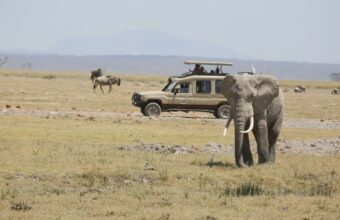
Wings Over Kenya Flying Safari
Kenya's most exclusive safari experience.
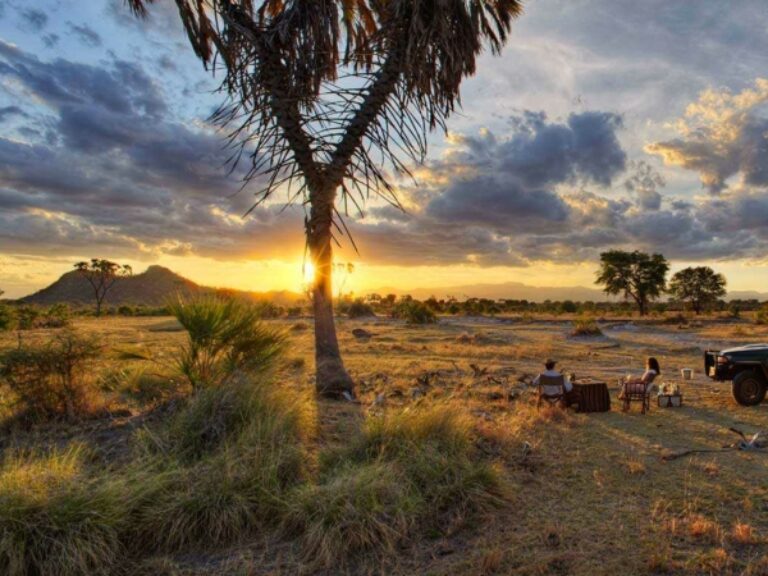
Elsa’s Kopje
This is the best lodge in what is, for me, one of the best safari parks in Kenya. Named after Elsa the lion, of Born Free Fame, the lodge sits on an outcrop with simply incredible views over Meru. Owned by Kenya-based Elewana Collection, it’s undeniably pricey – rooms start at around USD $950 per night and climb steeply from there – but worth a night or two if your budget can stretch that far. If that’s beyond your means I can also recommend Meru Camp and there are cheaper options in the nearby town of Maua.
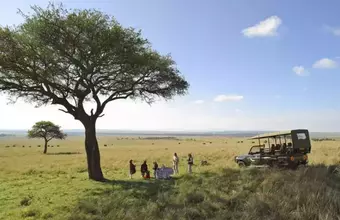
Affordable Masai Mara Safari
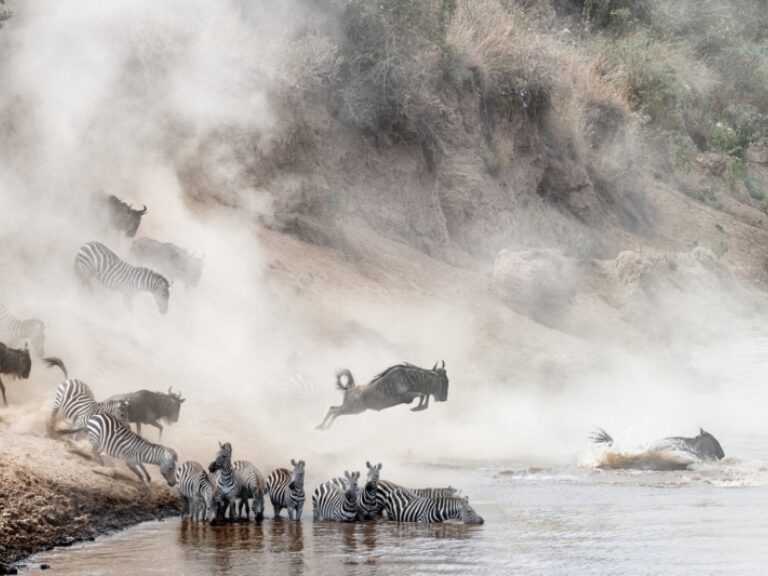
Witness the migration river crossings – but expect crowds!
The wildebeest migration is one of the world’s greatest natural phenomena, and watching the herds dodge hungry crocodiles as they surge across the Mara River is a staple of Kenya safari.
The migration moves into the Masai Mara from Tanzania’s Serengeti between June and October. This is by far the busiest time and place of the year, so expect crowds, higher prices and limited availability.
If you’d rather see the migration untroubled by crowds, I recommend you look at Tanzania instead.
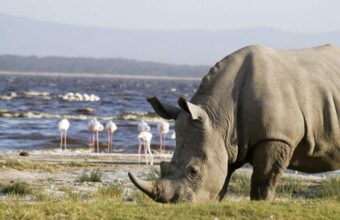
Lions, Rhinos, Hippos & More
Lakes naivasha & nakaru & masai mara.
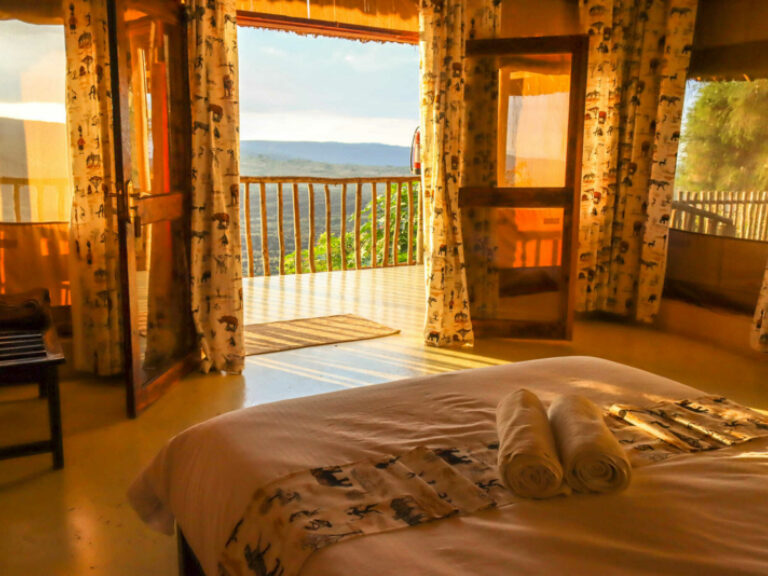
Denise Carnihan
I can highly recommend Maili Saba. It has a picturesque location overlooking the Great Rift Valley and volcano region, with lovely permanent tents each with en-suites and balcony, and all very nicely decorated. There is a communal pool and outside gazebos for relaxing. The main dining room and lounging area is stunning with striking cathedral ceiling and beautiful decor.
The food is absolutely outstanding and the staff are warm, friendly and go out of their way to assist their guests.
The first time I visited was a complete surprise organised by my Kenyan partner, and I've included it in our tour itineraries ever since.
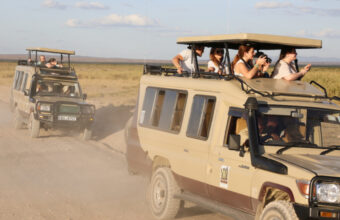
Essential Kenya Safari
See the best of kenya in one week.
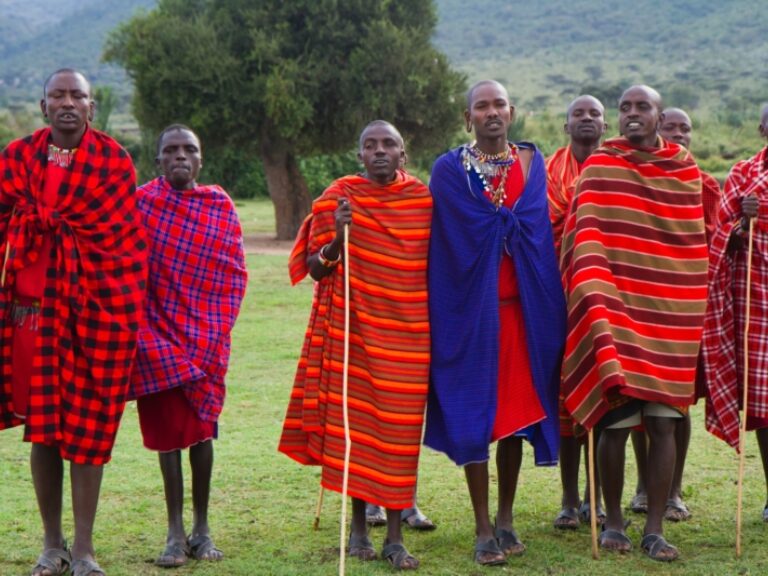
Stay in a community-owned conservancy
One of the great success stories of Kenya safari has been the emergence of networks of conservancies, usually adjacent to the better known national parks. These are community-run or privately-operated protected areas, run for the benefit of wildlife and local communities.
In the Masai Mara, the Nashulai Maasai Conservancy is particularly interesting, as it’s the only one that was 100% established by local Maasai and the only one where the Maasai remain in their homes within the conservancy. There are two accommodations in the conservancy, the small and exclusive Wageni camp and the mid-market Oldarpoi. It's also possible to visit as a day visitor, but you must still book ahead.
In the same area I can also highly recommend Mara North, Naboisho, and Ol Dereski; you’ll likely have an amazing time in any of them.
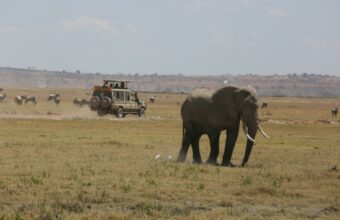
Highlights Of Kenya Private Safari
See the very best of kenya on this exclusive adventure.
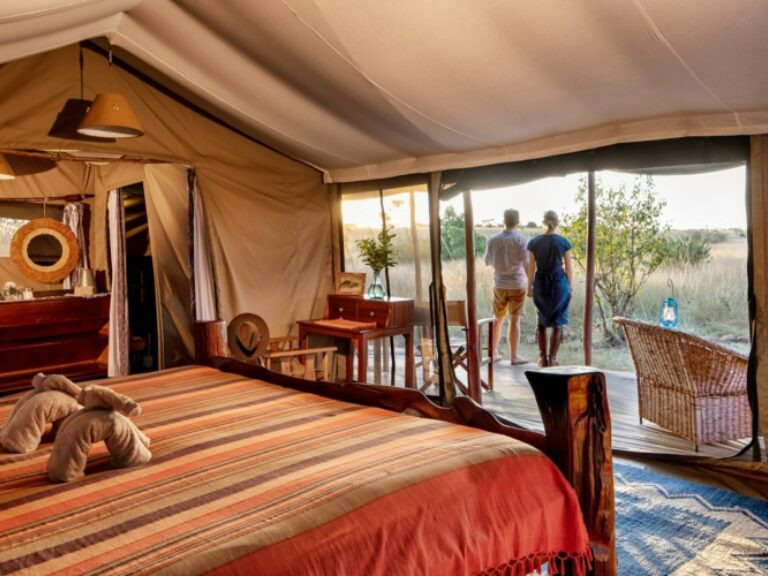
Offbeat Mara
Mara North is perhaps the best known conservancy in the Masai Mara, and Offbeat Mara is one of my favourite camps in the entire place.
It's a small, un-showy camp of just seven tents including two family tents. In addition to the standard game drives you can do night drives, guided bush walks, horse riding, hot air balloon flights and even do some Maasai running coaching!
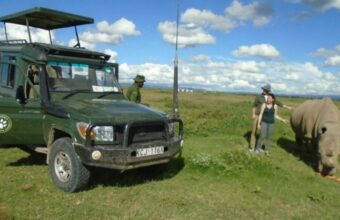
Ol Pejeta Wildlife Sanctuary Safari
Two day safari from nairobi.
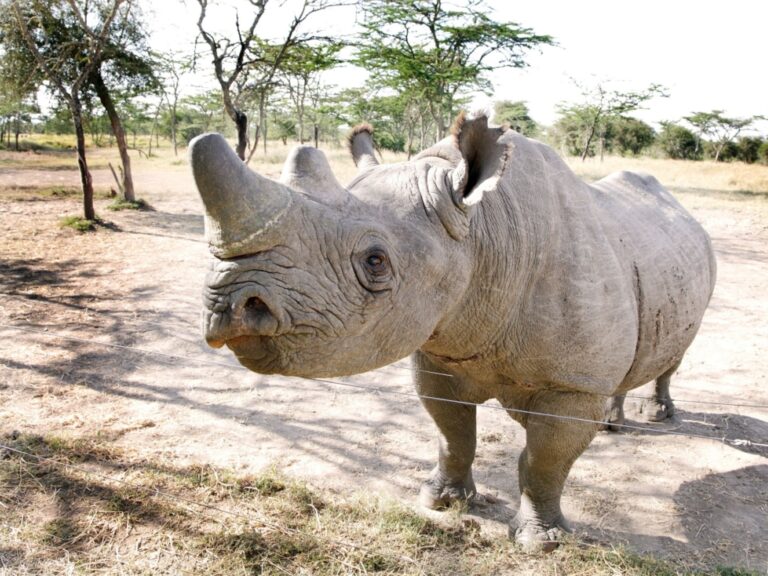
Ol Pejeta Conservancy
If you’ve ever wondered what the hide of a rhino feels like, wanted to experience a safari at night or dreamed of running (or riding) in the wild, open air of a safari reserve, head to Ol Pejeta Conservancy. The conservancy is in the Laikipia region, at the foothills of Mount Kenya. The sanctuary is the largest in East Africa to host black rhino, as well as the world’s last two remaining white northern rhino. Ol Pejeta is also the only place in Kenya where you can see chimpanzees. Conservation is at its core, with several experiences available for intrepid safari-goers who want to do more than just watch the animals.
Those looking to get their hands dirty can join one of the one or two-week volunteer programmes and learn wildlife research and tracking, veterinary care and more of what goes on behind the scenes. The conservancy has several accommodation options from simple cottages to basic campsites and luxury tented eco-camps.
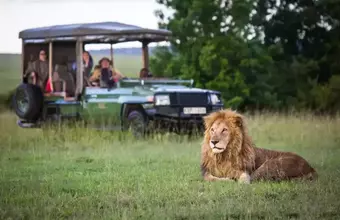
Enchanted Kenyan Safari
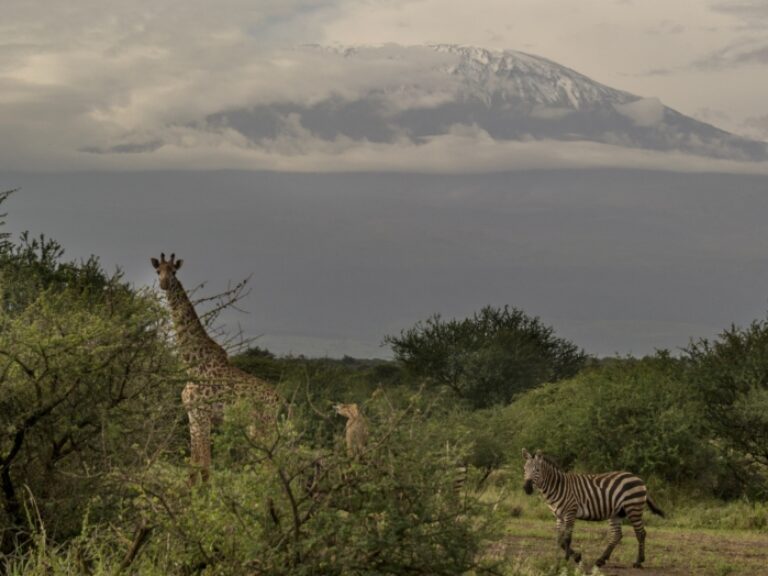
Campi ya Kanzi
If elephants are your thing, you can’t do much better than Amboseli where herds of these magnificent beasts graze in the shadow of the equally magnificent Mt. Kilimanjaro.
By far the best place to stay is not in the park itself but 30km away at Campi ya Kanzi in the Kimana Community Wildlife Sanctuary, situated between Amboseli and Chyulu Hills.
It’s a very high-end Maasai-run camp that was set up to aid the local community and conservation projects. Its excellent location means you can see wildlife in the conservancy, Amboseli and Chyulu all from one base.
Samburu, Rhinos and Mara Safari
Saruni Rhino Camp
This camp in the Sera Conservancy, just north of the Samburu Reserve in northern Kenya occupies a stunning location in the semi-desert. Their specialism is a thrilling rhino tracking walking safari, probably my favourite place to see rhinos in all Kenya. I spent five days here and by the end still couldn’t decide if coming within ten metres of the steamroller-like rhinos was thrilling or simply terrifying!
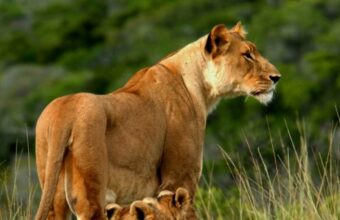
Tsvao & Amboseli Safari
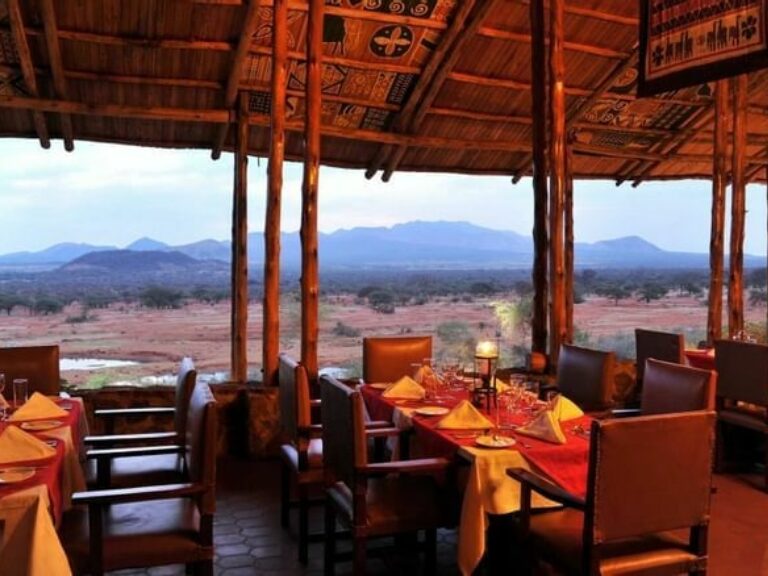
Kilaguni Serena Lodge
In Tsavo West most of the accommodation is fairly expensive (unless you have your own camping gear in which case there are three spartan public campgrounds). A reasonably-priced option is the Kilaguni Serena Lodge – it’s far from a budget offering but the Serena collection is generally pretty good value. If you have the budget to blow, Finch Hattons is the most exclusive camp in the park, with an eye watering price tag to match.
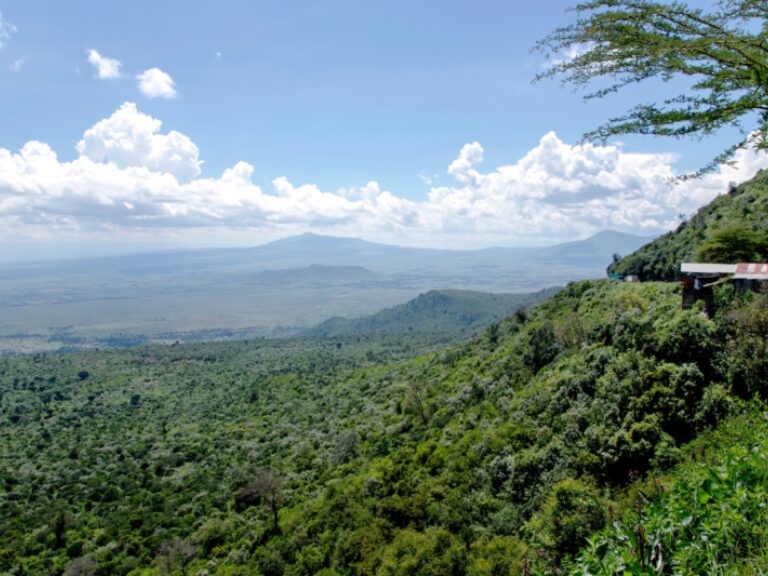
Best walking safari
In my opinion the best way to experience a safari is to ditch the 4X4 and explore on foot. With a good tracker-guide you’ll see all the little things you’d otherwise miss if you’re stuck in a vehicle all day. Walking is often forbidden within state-run national parks but is usually allowed, even encouraged, in conservancies. If I had to pick a favourite place for a walking safari in Kenya it’d be Loita Hills without question. Although not far from the Masai Mara, Loita Hills is barely visited by tourists despite boasting superb and varied scenery, a lovely climate, very different wildlife to the lower savannah plains, and fascinating interactions with very traditional Maasai culture.
Also, while Kenya doesn’t really compete with the multi-day Tanzania trekking scene, some organised trekking may be found here, as well as in the Aberdares and around Mt. Kenya.
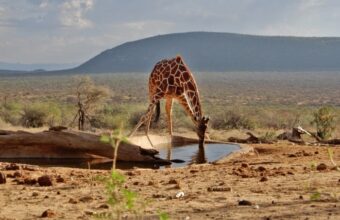
Samburu Safari From Nairobi
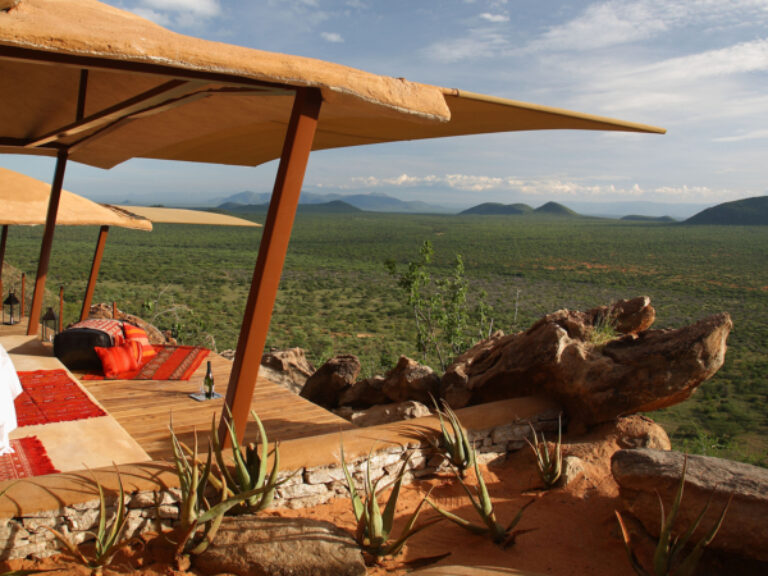
Saruni Samburu
There’s only one lodge within the Kalama conservancy, immediately to the north of Samburu Reserve, and it’s likely going to be one of the most spectacular places you’ll ever stay. Built into, around and onto a huge granite outcrop, Saruni Samburu is almost invisible from a distance but the stunningly turned out rooms offer a cliff side view over what feels like half of northern Kenya.
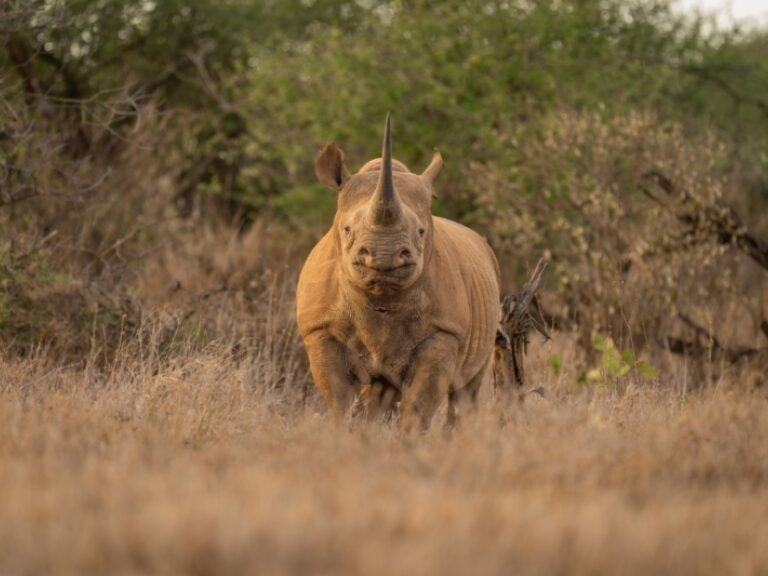
Lewa Conservancy
Lewa, in the Laikipia plateau area, is perhaps the most famous of all Kenya’s conservancies. And for good reason: this is safari to order. Want to see a black rhino? No problem. One of the superb guides will manage to find one. Lions, cheetah, elephant. They are all found here in abundance.
And it’s not just the wildlife that’s outstanding. The landscape is cinematic in its scope. Rolling sun bleached grasslands, table flat acacia trees, meandering rivers and a backdrop of the glinting glaciers of Mt Kenya.
The other great thing about Lewa (and this is common to all the Laikipia area conservancies) is exclusivity. If you’re not a guest of one of the handful of lodges then you can’t go on a safari here.
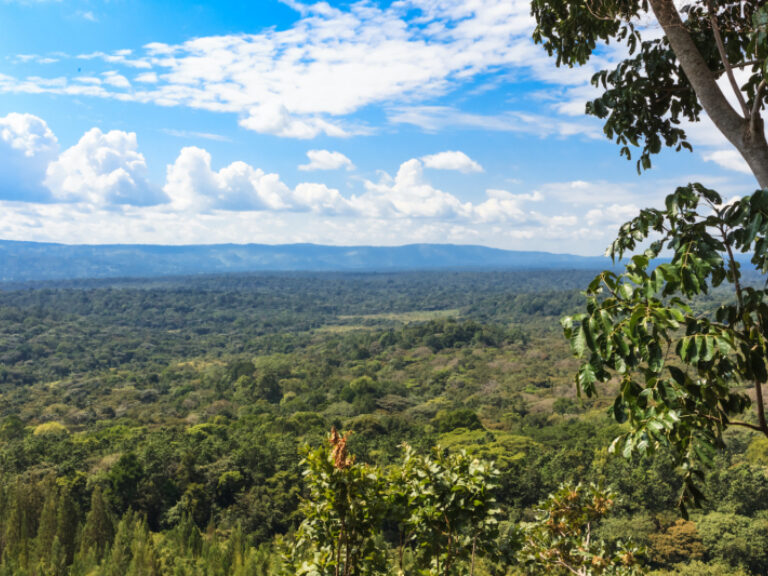
Kenya’s safari hidden gem
Just north of the equator in far western Kenya, is Kakamega Forest — Kenya’s only tropical rainforest. The land here is wet, green and intensely cultivated with a mix of subsistence farming and large tea estates. In amongst all this though are a few pockets of the dense rainforests that once covered large parts of western Kenya.
The Kakamega Forest Reserve is a fine example of this kind of forest and interesting walking safaris here reveal bird and primate life that has more in common with the forests of Uganda and the Congo than anything you’ll see on safari in Kenya. Wander the forest’s network of trails and take in the huge variety of flora and fauna it supports, including hundreds of bird species, some of which are not found anywhere else.
In my opinion, Kakamega is one of the most delightful places in Kenya, but yet hardly any tourists know of its existence. It should be a must visit for any ornithologist or herpetologist. As well as birds, reptiles and primates, I found the visit to the old mine shaft to look for bats especially memorable.
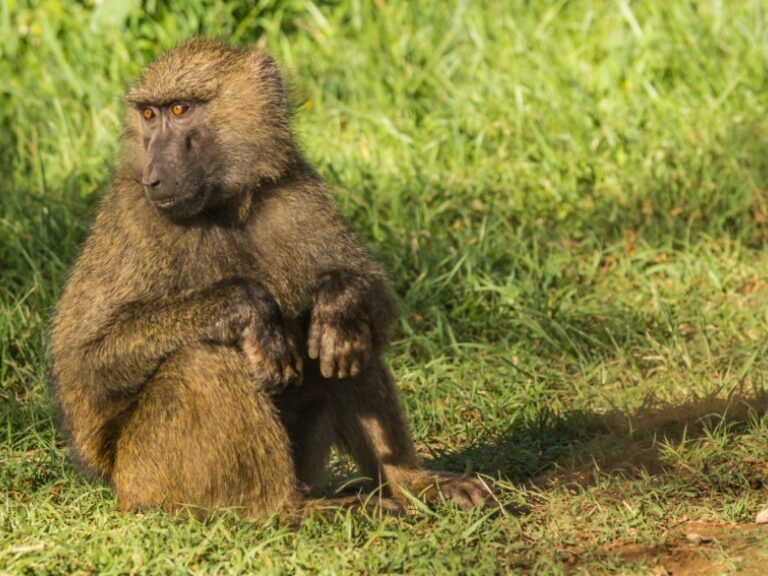
Up close and personal with baboons
Laikipia is known for its rhino conservation, but my own personal highlight in this area wasn’t the rhinos. Rather it was the day I spent with a biologist in very close proximity to around 200 habituated baboons. Having a huge male baboon shove its way past you as it bares its teeth was an experience easily on a par with gorilla and chimpanzee encounters in East Africa. The other nice thing about this particular experience is that it doesn’t involve staying inside an expensive conservancy but rather you are hosted by a grassroots Maasai womens’ project. And hardly anyone – even other Kenyans – know about it!
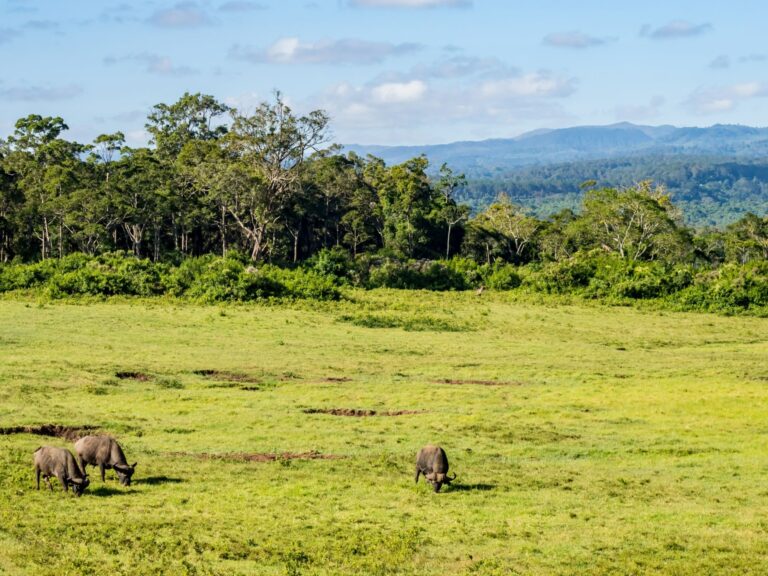
Hiking in Aberdare National Park
A world away from the African safari image of savannah grasses and drooling sunsets, the Aberdares consists of two different ecosystems. A high, cold and often bleak moorland and, below that, dense tangled montane jungle.
The wildlife here is a little different and a little harder to spot. But elephants are very common as are big grumpy buffalo. There are also montane species you won’t see anywhere else including bongo antelope, bush pigs and melanistic leopard and serval.
Unusually among Kenyan national parks, you can also get out of the vehicle here and enjoy long, lonely hikes over the moorlands: I have really enjoyed the sensation of trudging across the bleak moorlands in cold afternoon drizzle while always keeping a beady eye out for roaming buffalo.
The park also has some history. In 1952, a young English lady named Elizabeth was staying at the famed Treetops Lodge here (today’s version is actually a reconstruction of the original) when it was announced that her father had died. And so it was, that on a remote Kenyan mountain slope, that young lady became Queen Elizabeth II. Many years later her eldest grandson, and future king, proposed to Kate Middleton in a small wooden fishing cabin in a spot not so far away from where his grandmother became Queen.
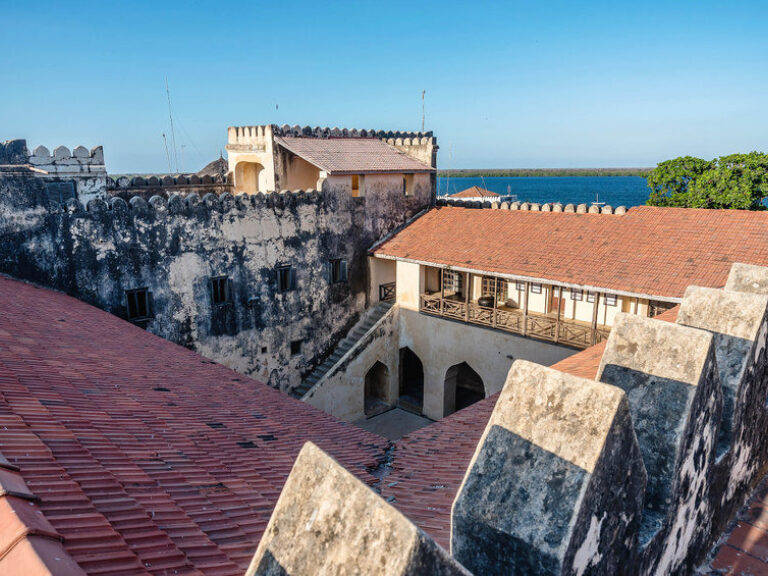
Post-safari beach time
If time allows I highly recommend you find a couple of days to wash away the safari dust on Kenya’s palm-fringed coastline. The country has many beautiful beach destinations but the standard itineraries tend to focus on Diani, south of Mombasa. My vote goes for the underrated Lamu archipelago, and in particular the old Swahili trading town of Lamu, which always leaves me enchanted.
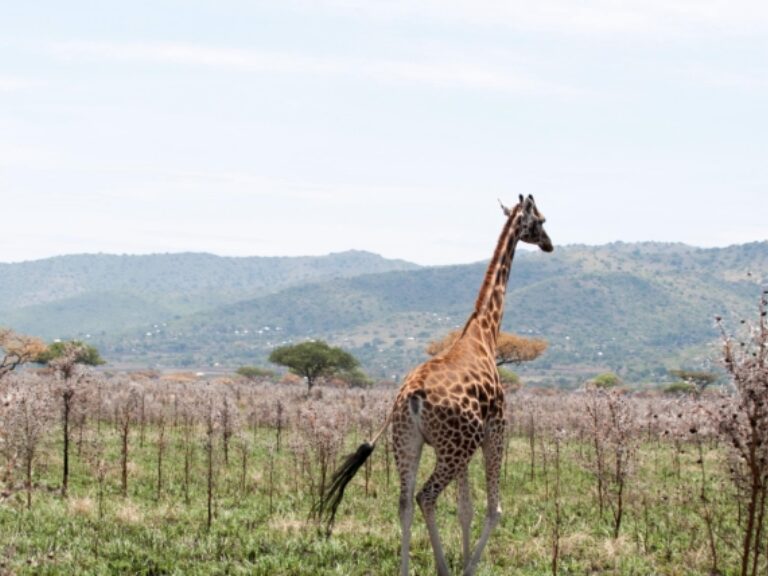
Get seriously off-the-beaten track
Another of western Kenya’s unsung wildlife highlights is the seriously off the beaten track Ruma National Park.
This park is a mixture of dense forest and thick, tall tropical grassland where large numbers of rare, and very beautiful, Rothschild giraffe can be found, as well as the massive, elegant roan antelope. On any visit here you will see plenty of these two creatures.
What you almost certainly won’t see however are the park’s rhino population. Rangers have told me there are quite a few here – all translocated from less secure areas – but in my three visits I’ve never seen any and the rangers tell me you have to be very lucky to see one.
But there’s something else you won’t see here either: other tourists. Once again I think that each time I have been I have had the entire park to myself and this makes for a very compelling reason to make the trek out here.
There are no facilities for tourists within the park, and only a few specialist operators will offer Ruma in a safari itinerary.
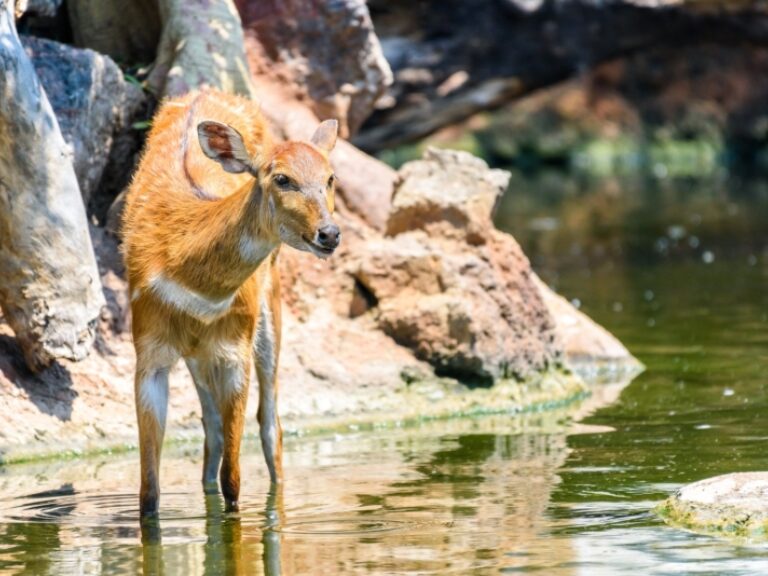
Stretch your legs at Saiwa Swamp
Kenya’s smallest national park, Saiwa Swamp, out in the far west near the farming town of Kitale, is another of Kenya’s underrated delights.
The park encompasses one small area of swamp surrounded by farmland and is home to a rare population of sitatunga antelope, an unusual semi-aquatic species that in Kenya can only be reliably seen here.
The park also offers stunning birdlife. My favourite thing about this park is that you can only visit on foot, following the walking trails and boardwalks that run through the park. It’s a delight to break free of the safari vehicles and stretch the legs.
In addition you will almost certainly have the entire park to yourself. I’ve been three times and never seen another person here. One word of warning though: Be careful of flash floods during heavy thunderstorms. I was once caught out by one of these: the waters rose very quickly, drowning the footpaths and I had to wade thigh-deep back across the marsh while trying very hard not to think about all the creatures that might live in a remote African swamp…
There are no facilities for tourists within the park, but nearby Kitale has plenty of fairly-priced hotels.
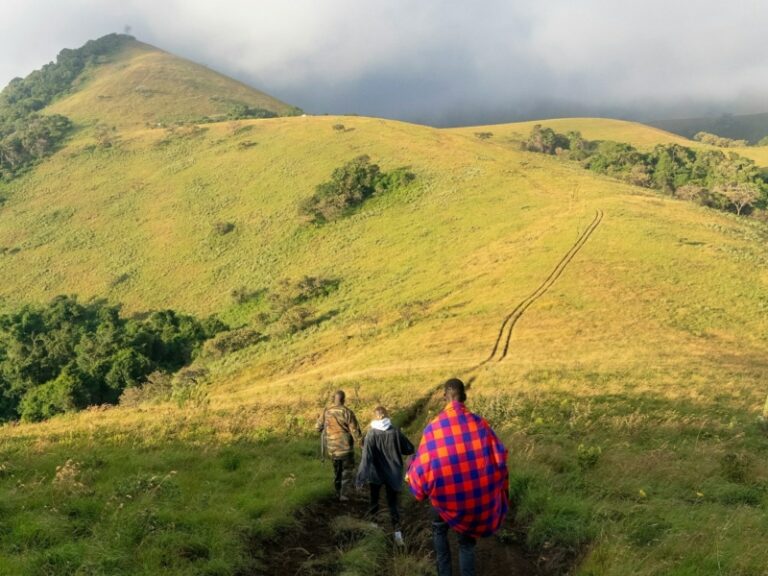
Chyulu Hills National Park
Bursting up above the hot red plains of Tsavo and Amboseli National Parks, the Chyulu Hills are a little visited, little known paradise of rolling green hills and forest.
The wildlife can be a bit hit and miss but there are still plenty of grazers around plus there are opportunities to mingle with Maasai herdsmen, walk across pretty landscapes and visit lava tubes.
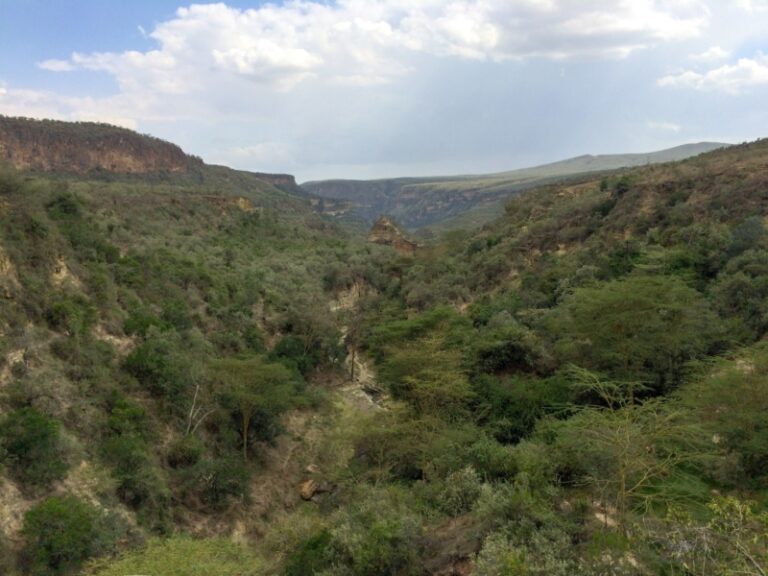
Hells Gate National Park and Lake Naivasha
If you’re looking for a quick escape from Nairobi then Lake Naivasha and the neighbouring Hells Gate National Park is just a couple of hours from the city and a great place for a quick wildlife fix.
Lake Naivasha is a huge freshwater lake famed for its birdlife and hippos while Hells Gate is a small savanna park with plentiful antelope, zebra, giraffe and baboons. The nice thing about this park is that you can walk or cycle through it (very battered bikes can be hired) which allows you to get close to wildlife without the barriers of a vehicle. If you’re a climber then you can also arrange to scale some of the rock spires within the park.
There’s no facilities for tourists within Hells Gate but a massive array of places to stay and eat around the shores of Lake Victoria.
I recommend you avoid visiting during weekends, when it can seem as if half of Nairobi is out here.
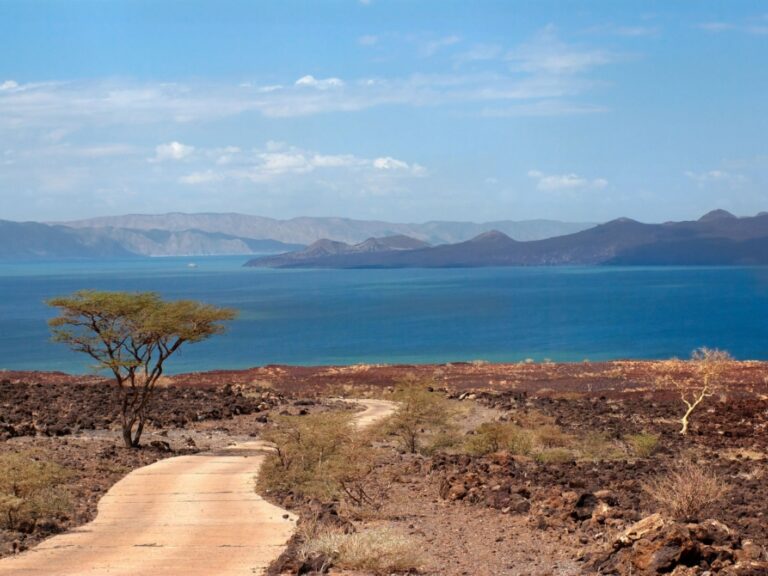
Chalbi Desert and Lake Turkana
If you're ready to test your adventurous side, look north to the Chalbi Desert, east of the stunning and remote Lake Turkana where dry, cracked earth meets lush oases surrounded by palm trees and herds of zebra, giraffe, ostrich, oryx and hyena come to drink.
This arid part of northern Kenya is largely unvisited, even by domestic visitors. It’s unique, otherworldly landscape is believed to be formed from a lake that dried thousands of years ago. You’ll find volcanic hills in the background and desert wildlife in the sand dunes.
Thrill seekers can take part in adrenaline-filled activities like sandboarding and dune racing in 4WD vehicles alongside local residents on camelback, nights spent stargazing and perhaps even a swim in Lake Turkana, itself in a national park with good game sighting opportunities. It’s far from easy to get to Chalbi — it’s 425km north of Nairobi — so expect to fly in and then use a local driver who knows the roads and terrain (and an appropriate hardy vehicle).
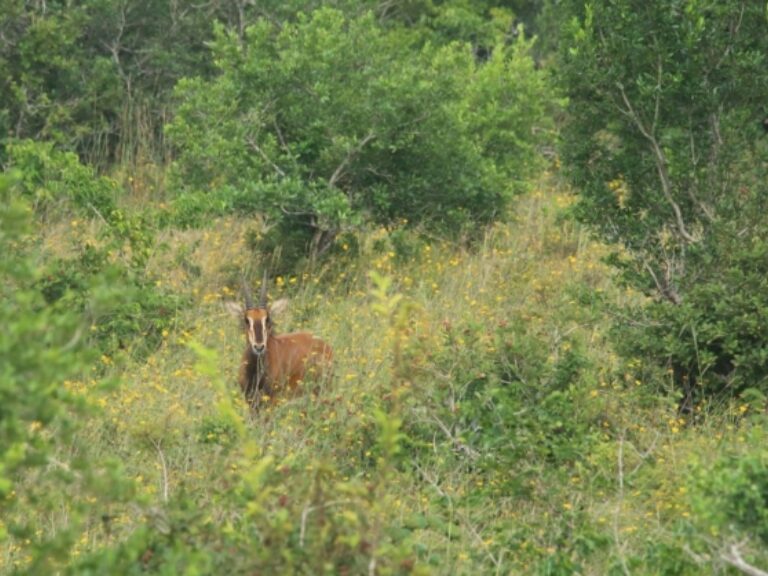
Shimba Hills National Reserve
Just inland of the popular Diani Beach, Shimba Hills makes for a brilliant short safari from the coast. The densely vegetated park has a large and visible elephant population and is the only place in Kenya where the stately sable antelope can be seen.
There’s also plentiful warthogs, baboons, vervet monkeys, buffalo and some introduced giraffes. Half and full day safaris can be easily organised from most of the beach resorts south of Mombasa. It’s a good bet for a family safari.

Featured kenya safaris
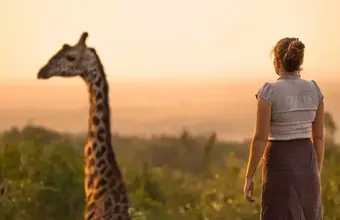
Kenya Safaris
Private safaris, custom itineraries.
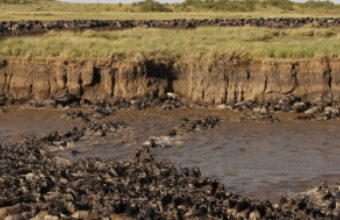
Kenya Safaris & Holidays
Safaris to unique accommodations, kenya's best safari parks, kenya’s most popular safari parks and lesser-known hidden gems.
Kenya proudly boasts of an impressive network of protected spaces made up of 65 national parks and reserves as well as dozens of private and community conservancies. Together these cover a huge proportion of Kenya’s diverse landscapes and provide a home for animals as large as an elephant and as tiny as an elephant shrew.
Some parks, such as the Masai Mara and Amboseli , are rightly world famous. Other parks, such as Meru National Park or Kakamega Forest Reserve, barely make a blip on the mainstream safari circuit but are every bit as rewarding (and much quieter!) then the big name parks and reserves.
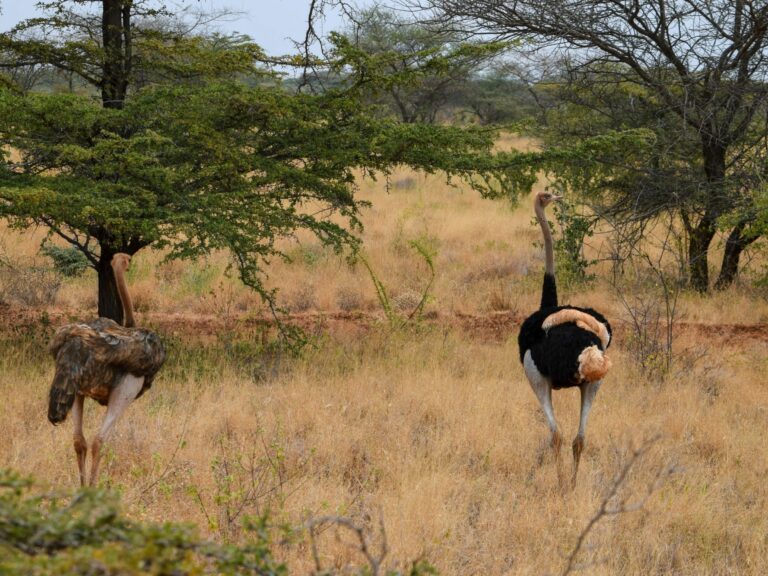
Best for tranquil, crowd-free safaris
Meru, the country’s forgotten national park, is easily one of my favourite of all Kenya’s safari parks. This was once one of the most popular parks in the country but during the 1980s, when Kenya was going through a rough political patch and instability overwhelmed some parts of the country, Meru turned into a hotbed of poaching.
Security and stability have long since returned, yet somehow this park never returned to its former fame. But for those in the know – and that now includes you – Meru National Park is safari gold.
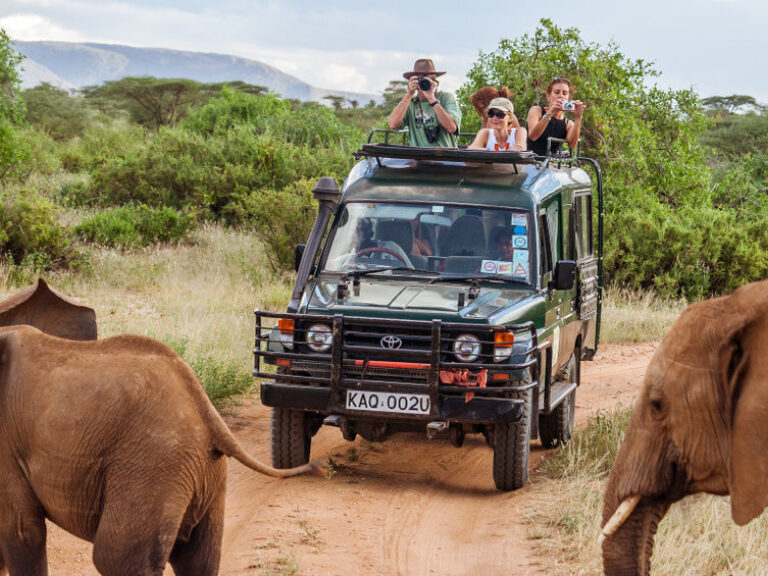
Masai Mara National Reserve
For the classic – if busy – kenya safari.
The very essence of an African safari landscape, the Masai Mara stretches along the Kenya-Tanzania border and forms the northern fringe of the greater Serengeti ecosystem (most of which is in Tanzania ).
This is the part of Kenya in which I have spent the most time (months and months if I added it all up), and was the scene of one of my best ever travel experiences. Some years ago a Maasai friend and I set out on a five week hike that took us across the entire Mara ecosystem. By day we walked alongside the wildlife and Maasai herders. By night we camped out under the stars and slept in traditional Maasai villages. An unforgettable adventure!
This is the place to see large prides of black-manned lions, bellowing elephants, grumpy buffalo and a pick ‘n’ mix box of antelope and gazelles. And that’s before we even touch on the smaller creatures and huge array of birds. But, above and beyond all else, the Mara is renowned for the spectacular wildebeest migration .
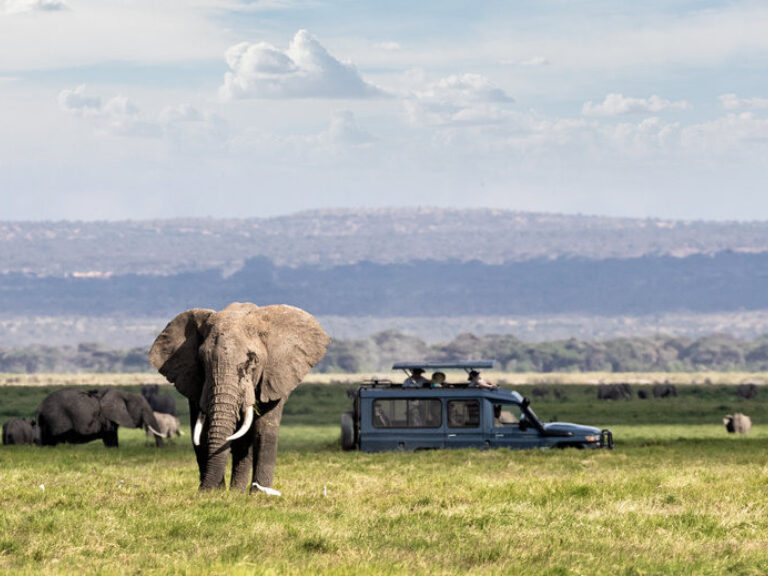
For elephants & Kilimanjaro views
Amboseli National Park is the postcard park of Kenya. This is where those photographs are taken of elephants with a backdrop of the (fast melting!) glaciers of Mt Kilimanjaro. I have spent many dreamy mornings parked under an acacia tree, a thermos of coffee in hand watching the rising sun tinge the snows of Kilimanjaro a pinky-red.
The elephants and the scenery are the real highlights of this park. In dry periods they flock here from miles around to quench their thirst in the swamps and pools that splash the dusty landscape in greens.
Another big reason to visit Amboseli is the chance to see conservation in action in the conservancies and other environmental and community projects surrounding the park.
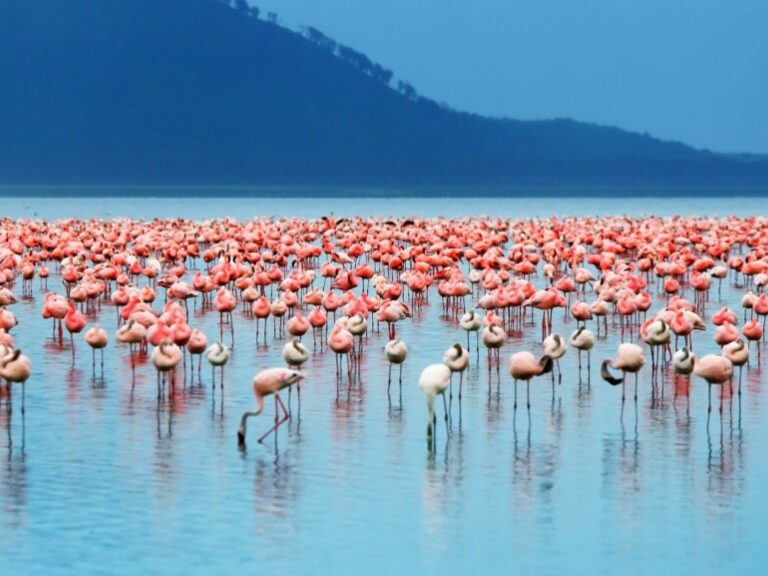
For wetland safari & birdwatching
Just 5 kilometres from the big city of Nakaru, Lake Nakuru National Park’s accessibility makes it one of the most popular Kenya safari hotspots. It’s centred on the large Rift Valley soda lake of the same name, but also encompasses fringing grasslands, acacia woodlands and rocky escarpments.
The park is best known for its sometimes huge flocks of flamingos and a large rhino population. Back in the 1990’s, Lake Nakuru was the first place where I saw a really huge flock of flamingos. I’d seen the odd handful before, but the thousands upon thousands I saw here on that day sticks in my memory. The smell (ah yes the smell!), the noise, and of course the searing pink colours; It was one of the moments that made me fall in love with Kenya.
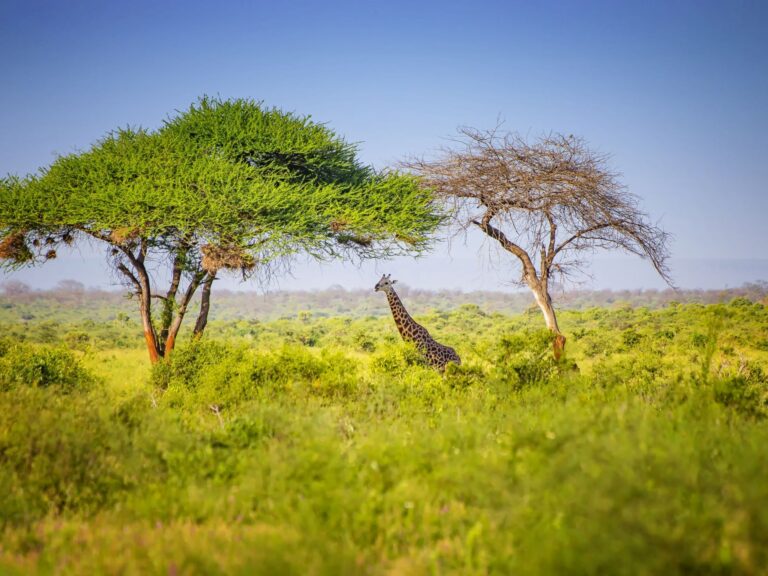
Tsavo East & West National Parks
Best for wide open spaces.
Combined, Tsavo East and West National Parks cover an enormous swathe of acacia scrub Kenyan wilderness. Tsavo West alone (the bigger of the two parks) covers an area greater in size than Wales, or two and half times the size of Yellowstone National Park.
The two parks are separated from each other by the Nairobi-Mombasa highway and are easy to reach from either city.
Despite being directly adjacent, the two parks are radically different from one another with the green hills of Tsavo East a marked contrast to the red soil and volcanic landscapes of Tsavo West. Because of their diversity and sheer size, I strongly recommend you devote enough time to the parks if you’re going to visit them. The rushed two-day safaris from Mombasa (or Nairobi) simply don’t allow enough time to get much out of a visit.

For world-leading conservation
The Laikipia plateau area in central Kenya is one of the most exciting places in African conservation. This isn’t a single national park or reserve, but rather a network of interlocking private and community-run conservancies where people, livestock and wildlife live together to the benefit of all.
Laikipia hosts all the classic East African safari mammals but is best known for its rhinos, including the critically endangered northern white rhino, only two of which are left alive. Both are female and so, tragically, this is a species awaiting extinction. They can be seen at the Ol Pejeta conservancy.
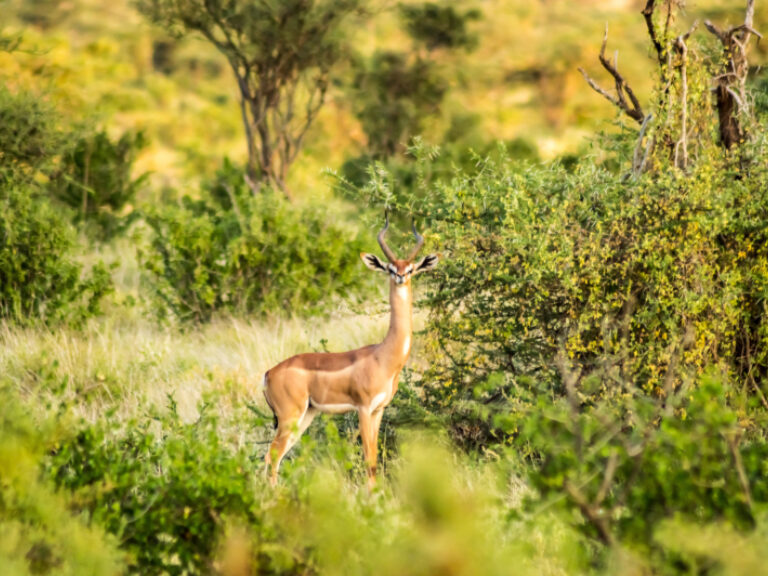
Samburu Game Reserve
Kenya’s remote far north.
Samburu, Buffalo Springs and Shaba National Reserves are three interconnected reserves on the edge of northern Kenya’s vast semi-desert wilderness.
Far removed from mainstream Kenyan life, these northern regions have a wild reputation. The landscape is harsh with endless sunburnt plains of acacia thornbush out of which rise the occasional fertile and densely forested mountain peaks, ranges, table lands and volcanic plugs.
Elephants, in particular, are the main event here. There are large herds who can migrate huge distances in search of water.
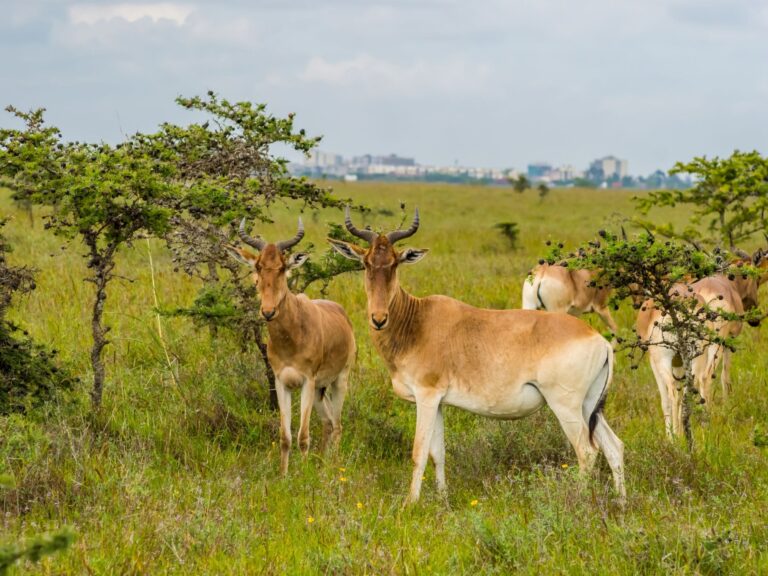
Safari in the big city
While most capital cities have their collection of ornate parks filled with neatly cut lawns, manicured flower beds and perhaps a boating lake, Nairobi has gone one step further.
Its biggest ‘park’ is in fact a 117 square kilometre swathe of undulating savannah grassland and acacia woodland. And while it doesn’t have a boating lake, it does have lions. And buffalo. And rhinos. All of which means that it’s probably not such a sensible place for an after work stroll.
It’s a fabulous safari destination but is woefully overlooked by international visitors to Kenya. This is a shame, because Nairobi National Park is an excellent safari location in its own right. I have been many times, often just for a quick half-day drive from the city. This was the place I first witnessed the thrill of a hunt: a cheetah racing, but failing, to grab dinner for her cubs.

A pair of ostrich in Meru National Park
Kenya safaris: Need to know
Everything you wish you'd known before you booked.
My first Kenya safari was in 1994 and I’ve been coming back pretty much every year since. Here’s what I’ve learned over the years about the best way to plan and book a safari in Kenya.
Mix up your itinerary
My single most important tip for Kenya safari first-timers is to avoid the mistake of non-stop game drives. Standard tour operator itineraries shuttle you from park to park with a gruelling schedule of game drives. Yes, this is the best way of seeing large mammals up close, but the bumpy tracks, early starts and long hours quickly exhaust even the most ardent wildlife-watcher. And there is so much more to safari in Kenya that you’ll miss from racing around in a jeep. Break it up. Look for operators who offer bush walks, village visits, and conservation projects. Or simply take an afternoon or two to sit back under a tree enjoying the sights, sounds and smells.
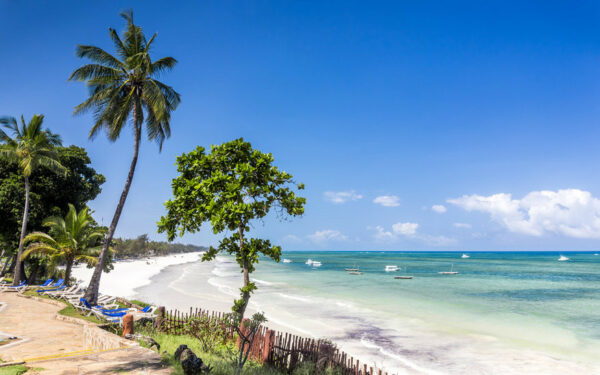
Many visitors to Kenya devote their entire trip to going on safari…
Don’t miss Kenya’s many hidden gems
Most standardised Kenya safari itineraries reduce the entire country to the blockbuster highlights: the Mara, Amboseli, Lake Nakuru… maybe Tsavo and Samburu if they’re feeling adventurous. This does a great disservice to the country’s true diversity. There’s so much more to a Kenya safari than racing around the savannah chasing the big five and I’d strongly advise you find time to visit some of Kenya’s numerous hidden gems.
For instance, out in the far west is Kakamega Forest Reserve which has more in common with the rainforests of Uganda and the Congo than the classic Kenya landscape. In my opinion this is one of the most delightful places in Kenya, yet hardly any tourists know of its existence.
Another personal favourite that’s a world away from the classic Kenya savannah is Aberdare National Park where dense tangled montane jungle gives way to a high, cold and often bleak moorland. Unusually among Kenyan national parks, you can also get out of the vehicle here and enjoy long, lonely hikes over the moorlands.
But that’s not it: Saiwa Swamp, the Chyulu Hills, Hells Gate, Ruma National Park, and many more that rarely feature on the mainstream Kenya safari circuit but are usually accessible on a self-drive safari, or with more specialist safari operators.
Get out of the safari bubble
Many safari goers, especially those on a high end tour just bounce from one heavenly safari camp to another. Sure, you live the Hollywood Africa dream but you’ve not really experienced real Kenya. Instead, hop on a bus and head out to one of the numerous small market towns where most Kenyans live. You’ll experience a totally different side of the country and it’s one that will stay with you long after the sundowner safari drinks fade from memory.

Kenya off the beaten track
The parks and reserves covered in my Kenya safari guide are only the best-known and most visited of the country's numerous protected and other natural areas…
Stay in at least one conservancy
National parks, reserves and conservancies are mentioned a lot in this guide, but just what is the difference and why does it matter?
A national park or reserve is a government or local council run protected area. Most of the best-known protected areas in Kenya fall into this category.
These areas are run solely for the benefit of wildlife and tourism, sometimes at the expense of local people. Tourism in these areas creates jobs, but locals are often forbidden from entering these protected areas other than for work reasons and communities were often (but not always) removed from their land when the parks and reserves were created. Corruption can be a problem with the money generated by these parks not always going where it should.
A conservancy is a different affair. A conservancy is normally located on either communal land owned by the community as a whole or on private ranch land and has no official government status. On a community conservancy the tourism stakeholders (i.e. the safari camps) lease the land from the local communities on the condition that the land is managed in a manner that is of benefit to both people and animals. The (normally very high) fees you pay to stay in a conservancy go toward paying the land leasing fees as well as various community and environmental projects.
Other conservancies may be located on private ranchland, in which case they have to make enough money for the landowner to financially justify turning his land over to wildlife conservation over cattle ranching.
In other words, a conservancy is run for the benefit of both wildlife conservation, tourism and the needs of local communities (in many cases local people are allowed to continue to graze their cattle on a conservancy but in a controlled and sustainable manner).
All of this means that staying in a conservancy is not just a great safari experience but it’s also very good news for conservation!
Do a homestay
For a cultural experience you’ll never forget, try spending a night at a Maasai homestay near the Masai Mara. Finding authentic, community-run homestays can be a bit of a minefield. I can recommend Sekenani Maasai Development Project (Semadep) but there are others – make sure you book with a community owned and operated outfit, and check reviews carefully.
Caution needed: "Human safaris"
In my opinion, one of the big problems with the safari industry is the way it prioritises seeing wildlife over having meaningful connections with local people. In fact, other than being served by their guides, drivers and camp employees, a typical safari-goer might not have any interaction with a local at all. To me, this is the exact opposite of how it should be done! In my experience, a good trip to Kenya isn't just about seeing wildlife: it should put intimate, authentic interactions with local people at the heart of the whole experience. You can make genuine connections and real friendships as you sit around, sharing stories, laughing and learning from each other.
On the other hand, mainstream Kenya safaris are often sold with "village tour" or even "slum tour" add-ons. These "goldfish bowl safaris" as I call them are unethical and nothing short of exploitation. They violate the privacy, integrity and dignity of local communities and undermine sustainable development by perpetuating a myth of backward, poverty-stricken people. The traveller thinks they're doing the right thing by getting some cultural interaction, but in reality it's deeply damaging. I strongly encourage visitors to avoid anything that feels contrived, and look for trips that put real people at the heart of the experience, rather than an afterthought.
How to plan & book a Kenya safari
There are three broad categories of safaris in Kenya.
The first and easiest option is to book a week(s)-long, multi-stop itinerary through a tour operator, either locally-based or international. This provides the most hand-holding and support for cautious visitors, plus more protection should things go wrong. The potential downside is getting shunted onto one of the more formulaic itineraries and simply following the crowds around the most popular parks. If you book a full tour with an operator, try to find a genuine specialist and ask about visiting some of the lesser-known locations mentioned in this guide.
Secondly you can simply show up and book a safari tour once in-country from the hundreds of operators in Nairobi. There’s nothing inherently wrong with doing it this way but I strongly advise you don’t just book something in the street. Do your homework first and find a reputable, responsible operator. Things to double check include whether park entry fees are included in the price, vehicle type (avoid cramped minibuses), and accommodation type.
Thirdly, and probably my recommendation for all but the most cautious of visitors, is to book the accommodation yourself, rent a car (or a car plus driver), and head out solo. You can take your own camping gear or book into lodges or camps (booking ahead is essential!), or mix camping with more comfortable nights in lodges. I strongly advise renting a vehicle plus driver. It’s often cheaper plus you get an unofficial local guide who knows the ropes. A good driver will become a cultural and language translator, wildlife guide, fixer, and general guardian angel.
Aim for shoulder season if possible
High season in Kenya is the peak summer months of July to September, before the rains begin. In my experience the best time to visit – especially in the busier parks – is either June before the crowds arrive or September-October as the crowds are thinning out, wildlife viewing is excellent and temperatures are ideal.
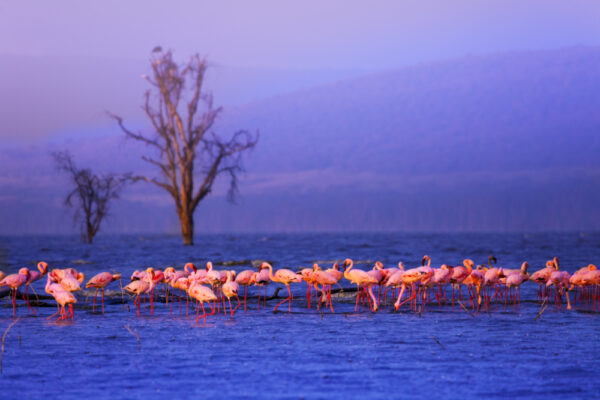
The best time to visit Kenya for safari
January & FebruaryThis is a hot and dry period…
Be prepared to splash out!
There are almost as many different ways of doing a safari as there are stripes on a zebra and how, when and where you safari makes a huge difference to what you pay. Expect to pay anything from $150 to $1,000+ per person per day.
You can find very low budget two or three day safaris to the Mara from around $250 all in, but these are generally rushed, crowded and uncomfortable. If you’re looking to shave off some costs without compromising on the experience, consider doing a DIY camping safari with your own vehicle and driver.
My other big Keny safari tip is to spend as much as your budget allows on fewer nights in better conservancies and camps. Packing more into fewer days gives you much greater bang for your buck.

Kenya safari costs
For a multi-day, mid-range safari visiting some of the big name parks and reserves then you’re looking at around USD $300-600 per person, per day…
Kenya safari FAQs
Your questions, our expert answers, is it safe / a good idea to rent a car in kenya and drive yourself around, or is it better to join a tour.
Yes, it's perfectly easy to do a self-drive Kenya safari . When you ask if it's "safe" that depends a little on what you mean. If you mean are there bandits, car jackings, dangers from wildlife, etc, then no you are quite safe. Instead the danger is from other drivers, as the driving conditions can be a little 'hectic' in places and accidents are common.
I'd recommend hiring a car with a driver, which can be a cheaper and, in my opinion, a much better option. A good driver will know the lay of the land, the driving conditions, best places to stop for lunch, etc. And they are often knowledgeable of the wildlife. A good driver will be both your driver and guide, and probably become your friend!
Almost any tour company in Nairobi or Mombasa can organise a private vehicle with a driver. Standards and prices vary hugely, so explain to the tour company exactly where you want to go and get in writing exactly what is and isn't included. Pay particular attention as to whether fuel, and the drivers food and accommodation is included in the rates. Also make sure you're booking the right vehicle: a 4WD may be needed for more remote areas.
Where’s the best place to see the big five in Kenya?
Seeing all the big five (lion, leopard, elephant, buffalo & rhino) in one park is hard. Only Lewa and some of the conservancies in Laikipia can honestly claim to offer easy sightings of all five. But, who cares! This fixation on racing around to tick off just five species is an anachronism from colonial-era big game hunting days. There’s so much more to Kenya’s wildlife and the modern safari experience.
We're visiting the Masai Mara but would like to visit another area on safari in Kenya. Can you recommend anywhere very different to the Masai Mara to see different wildlife and landscapes?
The most common combinations for a short add-on to the Masai Mara are Amboseli , Laikipia or the Samburu area.
For your requirements of a different habitat and wildlife then without doubt I would suggest Samburu National Reserve. This is a much drier and hotter area than the Mara with different vegetation and animals. And, even the animals you might have seen in the Mara are different up here with different species of giraffe, zebra and ostrich all present (and in my opinion all more beautiful than the kinds in the Mara). The park is also superb for elephants.
Samburu, though still popular, is notably quieter than the Mara and, once away from the river, it's easy to feel you have the place all to yourself (and especially if you go into the co-joined Buffalo Springs and Shaba reserves). Depending on when you are there you will find direct flights from the Mara, but otherwise will have to go via Nairobi. If you're driving it's a long way – a 10 hour non-stop drive, so flying is the better option.
Would you recommend staying at Elephant Bedroom Camp in Samburu Reserve, or at Sarara Camp in Namyunak Conservancy?
The quantity and ease of seeing the wildlife is better in Samburu Reserve than in the neighbouring Namyunak Conservancy (because the wildlife is drawn to the river running through the reserve). But there's not a huge difference in habitats or species between the two.
Elephant Bedroom Camp, in Samburu, is a fabulous, small camp. You'll see a lot of elephants and the owners are some of the worlds foremost elephant experts.
In Namyunak Conservancy, Sarara Camp is one of the most exclusive – yet low-key – camps in Kenya. There's slightly less wildlife than in the reserve but it's very close to the reserve and safaris from Sarara often enter the reserve.
The bonus with Sarara is exclusivity. You and the other camp guests will have the entire place to yourself meaning no crowding around animals (though that's rarely a problem in Samburu).
Unlike in the reserve itself you can do walking safaris in the conservancy and there will be more interaction with local people. The final plus is that by staying on a conservancy you will be actively helping to fund private/community conservation initiatives, which isn't always the case when staying only in a reserve or national park.
Overall then, I would opt for Sarara Camp, but I suspect it does cost more, so it might come down to budget!
We are travelling with a large group of 5 families with 3-4 kids per family. What are the best budget friendly safaris in Kenya in July?
If most of the children in your group are very young, your options are fairly limited as the reality is that a longer, multi-day safari can be a bit much with very young kids. I first did a safari with my kids when they were five and two years old and although it was good I probably wouldn't do it again! Past the age of about eight or nine the safari experience gets much easier, as they'll will tolerate sitting in a jeep on a bumpy road for longer.
Do be aware that some safari camps don't accept children below the age of 12. These are normally the unfenced camps and it's done for safety reasons.
You will also need to keep in mind that you will either need several safari jeeps and to travel in convoy or a bus (and these aren't always allowed in some parks). Because you will be travelling with so many children I would suggest small safari camps which you can book out for your group alone. Some of these are more child friendly than others. Some possibiltles that I believe might work well for your group are: Maji Moto Eco Camp, Loita Hills Basecamp, and if you are interested in a Maasai homestay style experience then I'd suggest Semadep Camp, who can arrange homestays around the Masai Mara.
As for specific parks and reserves the Masai Mara area is good because there's a lot of animals to see everywhere you look which keeps children interested. Also good are Nairobi and Narok national parks because of easy access and good roads. Lake Naivasha is good for families too.
It would be easy to combine all these places into a 10 day safari and then you could maybe finish up on the beach (Lamu and Watamu are both superb for families).
Can you recommend any family-friendly camps/lodges in the Masai Mara?
I would suggest rather than staying within Masai Mara proper, stay in one of the conservancies that now fringe the Mara.
In the most basic of terms these are like private, community-run wildlife reserves. Conservancy operators lease the land from local people and each local family receives a guaranteed monthly payment. The conservancy also provides employment and sets up development projects. People continue to graze their cattle but in a more controlled manner. And in return, fences are removed and the wildlife encouraged to return to the lands they were once driven out of. The conservancies have been a great success both for wildlife and local people. And, for tourists, they offer a very exclusive experience and the world's finest safaris.
Each conservancy has only a handful of very discreet high end camps and only guests of those camps can go on a safari in the conservancy, which means crowds of vehicles around a lion are non-existent.
The conservancies also allow activities not permitted within the reserve such as walking (highly recommended), bush camping, night safaris, etc. This makes them ideal for kids because it breaks up the routine and allows a little more freedom.
The safari vehicles and guides used in the conservancies are absolutely the best in the game and the wildlife populations are the equal of the actual reserve. However, there's a catch (of course...), conservation like this doesn't come cheap. All of the conservancies are superb but some names are Naboisho, Mara North and Nashulai Maasai Conservancy (this last one being slightly cheaper than the others and lots of focus on meeting local people). As for actual camps you cannot go wrong with any of them. All the conservancy camps are superb. I'm a big fan of the Basecamp offerings, Off-Beat and Kicheche. All are a little less extravagant than some of the other camps.
If you want to only visit the reserve and not a conservancy then I suggest either Basecamp Mara, Oldarpoi or you could go for a Maasai homestay in Sekenani village. Expect basic but perfectly comfortable rooms but an amazing experience. Your kids would really enjoy this.
Is February a good time to visit the Masai Mara, or would June-July be better? What would be the differences?
February is a very good time for safari in the Masai Mara , but also very different to the experience in June and July.
It's hotter and drier in February and generally there are fewer other tourists. There will still be plenty of zebra and wildebeest around but these are the non-migrating resident herds, so they don't form the massive iconic herds that you might see on TV.
July is good because the migrant wildebeest are all normally in the Mara by then, but its also absolute peak high season so can be busy and expensive. June is perhaps my overall favourite month. Everything is green after the rains and it's nice and cool with far fewer tourists than July, but the first migrant wildebeest might start to arrive (it all depends on rains and the state of the grass).
In short, all three months are excellent but each is different so it might be best to go with whatever just suits your timings better.
I will be in Kenya in early March and am looking for a five day safari for wildlife photography and birdwatching. Where would you recommend for me noting it is the start of the rainy season?
Early March is still a bit early for the rainy season so you might just get the odd thunderstorm. If birds are your real interest and you only have five days then probably the easiest is to go down to the Masai Mara via the Rift Valley lakes of Naivasha and Elementia or Nakuru. This would give you a good range of avian habitats and species in a short space of time. Don't forget as well that Nairobi itself has some excellent birding in the various forests and parklands in and around the city. Plus of course, there's the superb Nairobi National Park where you will see a lot of wildlife and birds.
In this guide:
Typical prices for a safari in kenya, when to go on safari in kenya, things to do in kenya other than safari, best safari camps and lodges in the masai mara, about the author.
Stuart is an award-winning travel journalist covering safari, trekking and conservation in Africa for the Lonely Planet, Rough Guides, BBC, Bradt Travel Guides, amongst many others. He is the author of Walking With The Maasai , a journey through some of Kenya's lesser-visited Maasai lands.
Featured tours
Other guides you might like, south africa safari, an expert guide to safaris in south africa.
Anthony Ham
Wildebeest migration safaris, an essential guide to planning a migration safari in tanzania and kenya.
Hans Cosmas Ngoteya
Safari in zambia, an expert guide to zambia's best safari parks, camps & lodges.
Sarah Kingdom
Safari in tanzania, an expert guide to tanzania's best safari parks & camps, safari in botswana, an expert guide to botswana's best safari reserves, camps and experiences, where and how to see the big 5 on safari in africa, safari in africa, our travel writers' top africa safari picks, zimbabwe safaris, an expert guide to the best safari camps in zimbabwe, chimpanzee trekking, an expert guide to seeing chimpanzees in the wild.
Philip Briggs
Namibia safari, an expert guide to the best safaris in namibia.
Melanie van Zyl
Why horizon guides.

Impartial travel guides
Our guides are written by the leading experts in their destinations. We never take payment for positive coverage so you can count on us for impartial travel advice.

Expert itineraries
Suggested itineraries and routes to help you scratch beneath the surface, avoid the tourist traps, and plan an authentic, responsible and enjoyable journey.

Specialist advice
Get friendly, expert travel advice and custom itineraries from some of the world's best tour operators, with no spam, pressure or commitment to book.
Our guides are 100% impartial and are written by independent, professional travel journalists. We make money by charging carefully-screened travel companies to list their business on our website. Our advertisers have no influence on our editorial content and we never accept payment for positive coverage.
Read more about how we work and what we believe in here .
- Travel guides
- Work with us
Sitemap , Privacy Copyright © 2024 Horizon Guides
- Travel Planning Guide
The Best Budget Safaris in Kenya

Seeking an extraordinary safari experience? We've meticulously examined various safari tours in Kenya from highly-rated companies, taking into account important criteria such as price, guest ratings, service, destinations, and activities. The result? A handpicked selection of the finest safaris in Kenya that will immerse you in nature's wonders and create cherished memories. So, pick out one of the safaris below for an epic journey into the wilderness, as we're confident it will be fantastic.
- Amboseli & Masai Mara Budget Safari By 4x4 Jeep 5 Days, $455.00
- Budget Luxury Masai Mara Safari in Kenya (in A Private Jeep with A Free Night at Nairobi Hotel) 3 Days, $355.00
- 3 days Group joining safari to Maasai Mara using a Land Cruiser Jeep 3 Days, $210.00
What do the budget and low-cost safaris offer in Kenya?
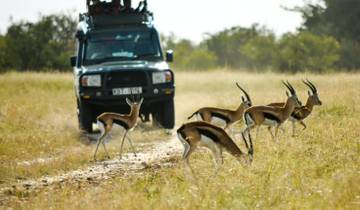
Here are the important factors:
- 19 trip options analyzed
- $147 average price per day (USD)
- 2 to 22 days in length
- 4.49 of 5 average rating
- 28 people or less on average
Curious about the diverse range of budget safaris? Prepare to be amazed by the array of options available to suit every traveler's preferences. It comes as no surprise that visitors adore these tours, given their exceptional average guest rating of 4.49 out of 5 stars. When it comes to group sizes, the average maximum capacity stands at 28 people, allowing for a comfortable and sociable experience. The shortest tour is 2 days, while the longest is 22 days. And for physical activity , you can choose between moderate, easy, and relaxing, with most of them being moderate. With a comprehensive analysis encompassing 19 budget safaris, you can rest assured that Kenya has something tailored to your interests and preferences, promising an unforgettable experience for all.
(All tour prices are in US Dollars before taxes, and come from a base price that is reported by TourRadar. Peak season prices can vary significantly, particularly in destinations where seasonal travel fluctuates dramatically.)
So, let's get to it and see...
The 10 Best Budget Safaris in Kenya
Amboseli & masai mara budget safari by 4x4 jeep.
- Great Value: the daily price is lower than average for budget safaris.
- High Quality: guest ratings are higher than average.
Set off on an extraordinary journey that has been awarded a 5 out of 5 stars by previous guests. And since the priority is on wildlife, family-friendly activities, and safaris, this tour is a great choice. With a duration of 5 days, this safari offers an intimate group setting, accommodating 70 individuals, while extending a warm welcome to travelers from 3 to 80 years old. Immerse yourself in a travel experience that includes 4 destinations, featuring Maasai Mara National Reserve and Lake Naivasha. Nairobi kicks off your expedition, serving as both the starting and finishing point. Brought to you by Bonvoyage Kenya Safaris , this exceptional deal is an incredible steal at a mere $91 per day.
- Jeep & 4WD
- Bird watching
Budget Luxury Masai Mara Safari in Kenya (in A Private Jeep with A Free Night at Nairobi Hotel)
With this option you can experience an unparalleled safari for 3 unforgettable days. It ensures an intimate group setting with 70 participants at most. You'll start and end this amazing trip in Nairobi. Bonvoyage Kenya Safaris , the organizer of this journey, extends a warm invitation to guests travelers from 3 to 80 years old. Rest assured, this trip is all about wildlife, family-friendly activities, and safaris, guaranteeing an unforgettable adventure. This extraordinary opportunity offers exceptional value at only $118 per day.
- Great Migration
3 days Group joining safari to Maasai Mara using a Land Cruiser Jeep
This fantastic safari has a rating of 4.2 out of 5 stars. Nairobi will be both the start and end of your journey. This extraordinary adventure also revolves around wildlife, family-friendly activities, and safaris. Lasting 3 days, the maximum group size is 20 people, and it's good for travelers from 2 to 95 years old. Organized by Perfect Safari Africa tours and safaris , this is a great deal because it's only $70 per day.
Budget Safari Amboseli Jeep Tour Starting Mombasa (3-Day)
With a stellar 5 out of 5 rating, this extraordinary trip is the perfect choice. This terrific trip also highights wildlife, family-friendly activities, and safaris. Your adventure starts and ends in Mombasa. Spanning across 3 days, the trip accommodates 21 individuals, and is suitable for travelers from 3 to 80 years old. Offered by Bonvoyage Kenya Safaris , this remarkable trip is priced at just $72 per day. Don't miss out on this incredible experience.
3 Days Small Group Masai Mara Safari (with Land Cruiser JEEP)
This exceptional trip offering by Perfect Wilderness Tours And Safaris has received a 4.7 out of 5 rating. On this 3-day safari trip you can unwind while also making new memories. Nairobi will be the beginning and end of your trip. With a group size of 20 people, it's suitable for travelers from 1 to 90 years old. You're in for an epic adventure with a strong emphasis on wildlife, family-friendly activities, and safaris. This remarkable trip is priced at an unbeatable $137 per day.
Nairobi to Zanzibar: Serengeti & Sunsets
- On Sale: 20% Off See Prices
Check out this safari that has received rave reviews, earning a stellar 4.5 out of 5 rating, visiting Kenya and Tanzania. Explore 6 incredible locations on this trip, including Ngorongoro Conservation Area, Dar es Salaam, Arusha, and Serengeti National Park. Nairobi marks the starting point, while Zanzibar stands as the final stop on your incredible journey. You'll love the emphasis on wildlife, beaches, and safaris, too. Spanning across 10 unforgettable days, this voyage offers an intimate group experience with 20 participants, and it's great for travelers from 18 to 39 years old. Brought to you by the renowned G Adventures , this exceptional opportunity is priced at an incredible $192 per day - an unbeatable value. It's currently on a special discounted offer.
6 Days Kenya Budget Tours (with Free Night at Nairobi Hotel)
This 6-day safari trip is ideal for travelers from 3 to 75 years old. And priced at only $91 per day, it's a great value, too. With an emphasis on wildlife, family-friendly activities, and safaris, you know you'll have an amazing adventure. Discover a journey that spans 5 destinations, with notable stops in Maasai Mara National Reserve, Lake Nakuru National Park, and Lake Naivasha. You'll start and end your journey in beautiful Nairobi. It's offered by Bonvoyage Kenya Safaris , a very popular company with rave reviews and knowledgeable guides.
3 Days 2 Nights in Maasai Mara via The Great Rift Valley
Priced at just $157 per day, this terrific 3-day safari adventure is ideal for travelers from 1 to 94 years old. Nairobi kicks off your expedition, serving as both the starting and finishing point. Organized by the reputable Across Africa Tours & Travel , this is one of the best tours on this list.
3 Day All Inclusive Masai Mara Camping Adventure
Check out this incredible safari trip that has received a 4 out of 5 rating from previous guests. Rest assured, this trip is all about wildlife, family-friendly activities, and safaris, guaranteeing an unforgettable adventure. With a duration of 3 days, this journey ensures an intimate group size of 7 people, and is good for travelers from 1 to 70 years old. You'll start and end this amazing trip in Nairobi. This fantastic option, organized by Smile view Kenya tours and travel , presents an unbeatable value at just $167 per day.
4 Days/3 Nights Adventure in Maasai Mara – Lake Nakuru
Spanning over 4 days, this journey has a maximum size of 25 individuals. Welcoming travelers from 1 to 94 years old, it is organized by Across Africa Tours & Travel , a very popular company with plenty of great reviews. Nairobi will be both the start and end of your journey. This extraordinary adventure also revolves around wildlife, family-friendly activities, and safaris. Available at an unbeatable price of only $190 per day, this option also has a rating of 4 out of 5 stars from previous guests.
See also The Best Family-Friendly Tours to Kenya , The Best Wildlife Tours to Kenya , The Best Hiking & Trekking Tours in Kenya , The Best 10-Day Tours in Kenya , The Best One Week (7-Day) Tours in Kenya , The Best 3-Day Tours in Kenya , The Best 2-Week Tours in Kenya , Tours for Outdoor and Nature Lovers in Kenya , The Best Christmas & New Years Tours in Kenya , The Best Overlanding Trips in Kenya , The Best Bird Watching Tours in Kenya , The Best Adventure Tours to Kenya , The Best Eco Tours in Kenya , The Best Sightseeing Tours in Kenya , The Best Cultural Tours in Kenya , The Tours for Animal Lovers in Kenya , The Best Photography Tours in Kenya , The Best Camping Tours in Kenya , The Best Romantic Tours for Couples in Kenya , The Best Safaris in Kenya , The Best Tours Under $1000 in Kenya , The Best Luxury Tours to Kenya , The Best Budget Tours to Kenya , The Best Tours for Seniors to Kenya , or The Best G Adventures Tours to Kenya for more tour ideas. With so many options, there's a guided tour or vacation package for every type of traveler.
Also, if you're departing from a specific destination, see The Best 3-Day Tours from Nairobi , The Best 3-Day Tours from Mombasa , The Best One-Week (7-Day) Tours from Nairobi , The Best One-Week (7-Day) Tours from Mombasa , The Best 10-Day Tours from Nairobi , or The Best 2-Week Tours from Nairobi for more package tour options.
How much do budget safaris in Kenya cost?
Travelers to Kenya will have a large number of terrific options for budget safaris at a variety of great prices. The price of budget safaris here can vary by type, destinations, length, and travel style. Based on thorough data from 19 budget safaris, their average daily price is a very reasonable $147 per day. If you're interested in more information about tours here, see our guide to tour prices in Kenya .
And for more information on Kenya, see Kenya Travel Costs and Kenya Hotel Costs .
Subscribe to our Newsletter
By signing up for our email newsletter, you will receive occasional updates from us with sales and discounts from major travel companies , plus tips and advice from experienced budget travelers!
Budget Your Trip

Some of the links on this website are sponsored or affiliate links which help to financially support this site. By clicking the link and making a purchase, we may receive a small commission, but this does not affect the price of your purchase.
- Privacy / Terms of Use
- Activities, Day Trips, Things To Do, and Excursions

Sub regions inside
Broader region.

Incredible Wildlife and Safaris
Kenya is home to some of the most famous national parks and reserves in the world, such as the Maasai Mara, Amboseli, and Tsavo. Visitors can witness the "Big Five" (lion, elephant, buffalo, leopard, and rhinoceros) and experience the annual Great Migration, where millions of wildebeest, zebras, and gazelles cross the Mara River.
Cultural Richness
Kenya is home to over 40 different ethnic groups, each with its own distinct culture, traditions, and languages. Visiting Kenya allows travelers to engage with local communities, learn about the Maasai, Samburu, Swahili, and other cultures, and participate in traditional ceremonies and crafts.
Beach Holidays
Kenya's coastline along the Indian Ocean is lined with stunning beaches, coral reefs, and marine parks. Popular destinations like Diani Beach, Malindi, and Lamu offer snorkeling, diving, and relaxing opportunities in luxurious beach resorts.
Adventure Activities
For thrill-seekers, Kenya offers a variety of adventure activities, including mountain climbing, hot air balloon safaris, deep-sea fishing, and water sports. The diverse terrain also makes Kenya an excellent destination for hiking, bird-watching, and exploring caves.
Rich History and Heritage
Kenya has a fascinating history, from ancient Swahili settlements to colonial-era landmarks. Visitors can explore historical sites like Fort Jesus in Mombasa, the ancient ruins of Gedi, and the Karen Blixen Museum in Nairobi, which offer insights into the country's past.
Warm and Friendly People
Kenyans are known for their hospitality and friendliness. Visitors often find themselves welcomed with open arms, making their experience in Kenya not only memorable but also personal and enriching.
Kenya's climate is generally pleasant, with warm temperatures throughout the year. The coastal regions are humid and tropical, while the highlands, including Nairobi, enjoy a more temperate climate, making it a comfortable destination year-round.
Conservation and Eco-Tourism
Kenya is at the forefront of conservation efforts in Africa, with many initiatives aimed at protecting wildlife and natural habitats. Visitors can support eco-friendly lodges and participate in conservation projects, contributing to the preservation of Kenya's natural heritage.
Culinary Experience
Kenyan cuisine is a delicious mix of flavors influenced by various cultures, including African, Indian, and Arab. From street food like "samosas" and "nyama choma" (grilled meat) to coastal delicacies, Kenya offers a delightful culinary journey.
For Wildlife Safaris
Dry Seasons (June to October & January to February): June to October: This is the most popular time to visit Kenya, particularly for safaris. The weather is dry, making it easier to spot animals as they gather around water sources. This period also coincides with the Great Migration in the Maasai Mara, where millions of wildebeest and zebras migrate from the Serengeti in Tanzania to Kenya.
January to February: Another dry period with good wildlife viewing conditions. Animals are easier to see as they congregate in more predictable areas due to the scarcity of water.
For the Great Migration:
July to October: This is the best time to witness the Great Migration in the Maasai Mara. The exact timing can vary, but typically, the wildebeest start arriving in the Mara in July and remain until October before heading back to the Serengeti.
For Bird Watching:
November to April: During these months, Kenya becomes a haven for bird enthusiasts as migratory birds from Europe and North Africa arrive. This period coincides with the "short rains" (November to December) and the "long rains" (March to May), which make the landscape lush and green, providing excellent conditions for birdwatching.
For Beaches and Coastal Activities:
December to March: This is the best time to visit Kenya's coast (e.g., Diani Beach, Malindi, Lamu) as the weather is warm and dry. The Indian Ocean is calm and clear, perfect for snorkeling, diving, and relaxing on the beach.
For Climbing Mount Kenya:
January to February & August to September: These are the best months for climbing Mount Kenya, as the weather is relatively dry, and the trails are more accessible.
For Avoiding Crowds:
March to May (Long Rainy Season): This is the low season in Kenya due to the heavy rains. While wildlife is still present, it can be harder to spot due to the lush vegetation. However, if you don’t mind the rain, this is a great time to enjoy quieter parks, lower rates, and lush green landscapes.
Renowned for its classic savanna safaris, Kenya is a beautiful country with deserts, alpine snows, forests, open plains, colorful tribal cultures, freshwater lakes and coral reefs. The wildlife safaris have always been the top attraction in Kenya. This huge wilderness is home to the most impressive wildlife spectacle on earth; The great migration. The great migration is a pilgrimage of millions of wildebeest and zebra in search of new pastures. The herds are followed by vast numbers of predators, including lions, hyenas and cheetahs. Other activities to be experienced in Kenya include trekking Mount Kenya, ballooning over the Masai Mara and snorkeling in Malindi on the Indian Ocean coast.
Masai Mara National Park
The Masai Mara National Reserve is one of the top tourist attractions in Kenya and the country’s most popular game park. Each year the Masai Mara National Reserve is visited by thousands of tourists who come here to watch the exceptional population of game and the annual migration of zebra and wildebeest. The “Great Migration” takes place every year from July to October when millions of wildebeest and zebra migrate from the Serengeti in Tanzania.
Amboseli National Park
Amboseli National Park is a relatively small park located close to the Tanzania border at the foot of Africa’s highest mountain, Mount Kilimanjaro. The park is famous for being the best place in Africa to get close to free-ranging elephants. Other wildlife includes giraffes, zebras, cheetahs and hundreds of bird species. ‘Must do’ attractions in the Amboseli National Park include meeting the Maasai people and witnessing the spectacular views of Mount Kilimanjaro.
Nairobi National Park
Nairobi National Park is just a short drive from the center of Nairobi with only a fence separating the park’s wildlife from the metropolis. It is the only national park in the world to be found within the precincts of a capital city. Nairobi’s skyscrapers can be seen from the park. Despite its proximity to the city and the relatively small size of the park, Nairobi National Park boasts a large and varied wildlife population including the endangered black rhino, lions, leopards, cheetahs, hyenas, buffaloes, giraffes and diverse birdlife with over 400 species recorded.
Malindi is a town on Malindi Bay, in southeastern Kenya. It sits amid a string of tropical beaches dotted with hotels and resorts.Malindi provides a very nice introduction to the coastal tourist attractions in Kenya with its extensive coral reefs and beautiful beaches. There are surfing, snorkeling, deep-sea fishing and other water sports. The Malindi Marine National Park and nearby Watamu Marine National Park have protected areas with beautiful beaches, clear water, turtles and very colorful fish. Arabuko-Sokoke Forest Reserve harbors elephants and more than 200 species of birds.
Mombasa is Kenya's main tourist destination. It is on the eastern coastline of Kenya, bordering the Indian Ocean which has made it a popular destination for its beaches. Mombasa is a place where both history and progress are greatly valued, where a busy harbor existence is lived at its own unique, tropical pace. Mombasa offers a diverse marine life, world-class hotels, and friendly atmosphere. There is a tropical climate all year and it is a great destination filled with activities for all ages.
Mount Kenya
Mount Kenya is the highest mountain in Kenya and the second-highest in Africa, after Kilimanjaro. The mountain is an awe-inspiring sight and is often referred to as the ‘Place of Light’. Its ragged series of peaks are crowned with snow, and its slopes are covered with forest. The 5199 meter (17,057 ft) high summit is a difficult technical climb, several lowers peaks, however, are an easy destination for any fit trekker. The majority of animals live lower down on the slopes of Mount Kenya. Here there is more vegetation and the climate is less extreme. Various species of monkeys, several antelopes, tree hyrax, porcupines and some larger animals such as elephant and buffalo all live in the forest.
Samburu National Reserve
Samburu National Reserve is a very peaceful national park in Rift Valley Province of Kenya. It attracts wildlife because of the Uaso Nyiro River that runs through it and the mixture of forest and grassland vegetation. All three big cats, lion, cheetah and leopard, can be found here, as well as elephants, buffalo and hippos. The Uaso Nyiro River contains large numbers of Nile crocodile. Samburu also offers a sublime birding experience.
Hell’s Gate National Park
Hell’s Gate National Park is a small park named after a narrow break in the cliffs, once a tributary of a prehistoric lake that fed early humans in the Rift Valley. It is unique among Kenya’s wildlife parks, as you are allowed to walk or cycle without a guide. There’s dramatic scenery, with steep cliffs, gorges and basalt columns. The national park is home to a wide variety of wildlife, though many are few in number. Examples of little-seen wildlife include lions, leopards, and cheetahs.
Lamu Island
Lamu Island is a part of Kenya’s Lamu Archipelago and has managed to stay unspoiled and untouched by the mass tourism that has hit much of Kenya’s coastline. As the oldest living town in Kenya, Lamu Town has retained all the charm and character built up over centuries. There are no roads on Lamu Island, just alleyways and footpaths, and therefore, there are few motorized vehicles on the island. Residents move about on foot or by boat, and donkeys are used to transport goods and materials.
Tsavo National Park
Tsavo is one of the oldest and largest national parks in Kenya and in the world. Due to its size, the park was divided into Tsavo West and Tsavo East. The Tsavo West has spectacular scenery with a rolling volcanic landscape while Tsavo East has more open savannah than its western sibling. Tsavo National Park is the ideal destination in Kenya for people who seek solitude and privacy as well as the chance to explore the wilderness. The park is home to most of the larger mammals, vast herds of dust-red elephant, Rhino, buffalo, lion, leopard, pods of hippo, crocodile, waterbucks, Lesser Kudu, gerenuk and the prolific bird life features 500 recorded species.
Lake Nakuru
Lake Nakuru is a very shallow lake in central Kenya. The lake’s abundance of algae attracts vast quantities of flamingos, sometimes more than one million at once. Often called the greatest bird spectacle on earth, the flamingos are one of Kenya’s top attractions. Visitors can enjoy the wide ecological diversity and varied habitats that range from Lake Nakuru itself to the surrounding escarpment and picturesque ridges. Lake Nakuru National Park is ideal for bird watching, hiking, and game drives.
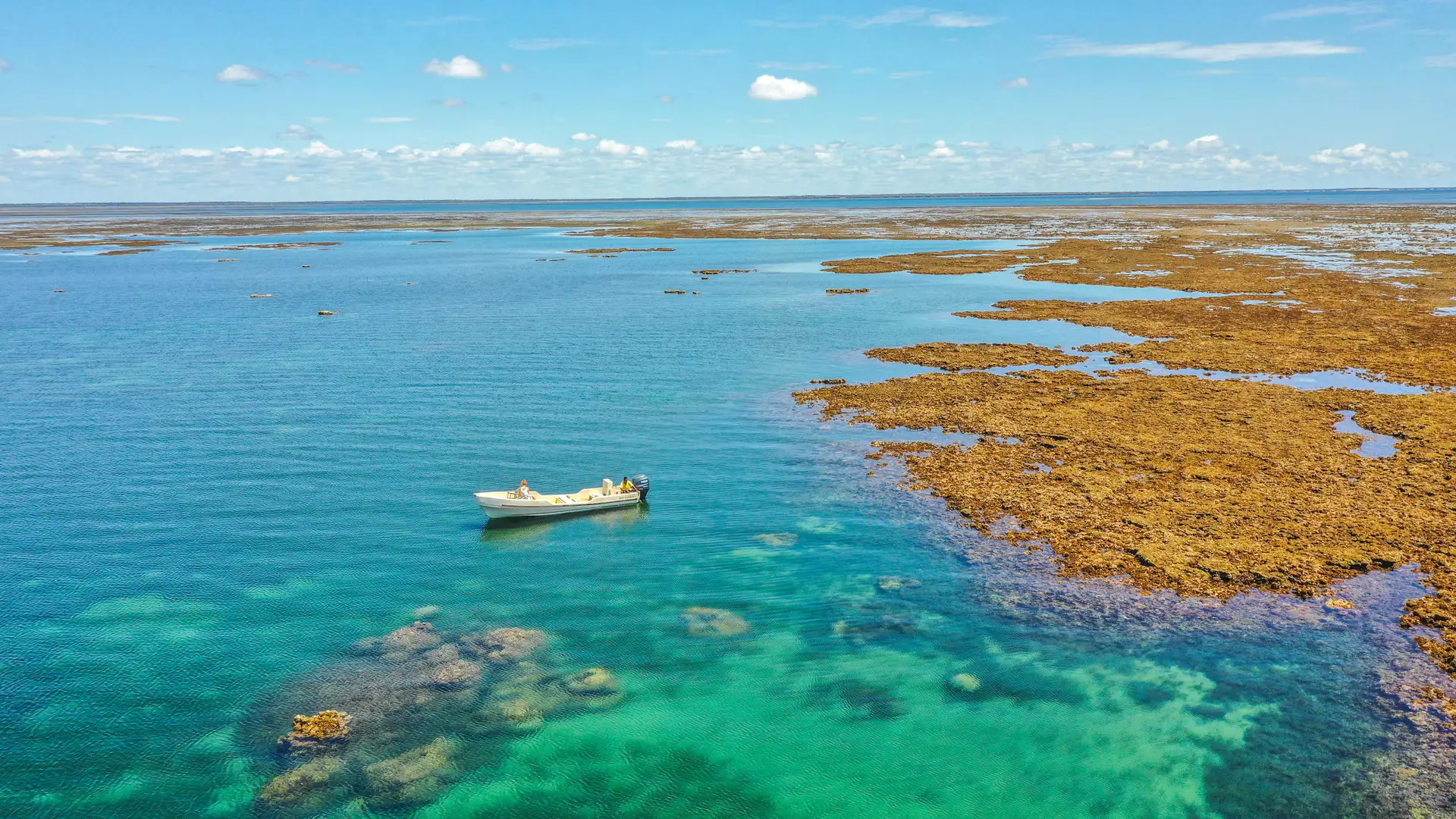
Customer Testimonials

Aug 30, 2024
Leigh-Ann super star ⭐️
I am so pleased to share my experience with Leigh-Ann, who assisted with our safari and South Africa travel arrangements. From start to finish, Leigh-Ann went above and beyond. Her attention to detail and smooth communication made the planning process effortless. No request was too big or too small, and she handled everything with efficiency. Leigh-Ann exceeded all expectations, making our trip both stress-free and enjoyable. Her exceptional service reflects her professionalism. I highly recommend her for anyone seeking top-notch travel support. Thanks so much Leigh-Ann :)
Aug 27, 2024
Very good experience with getting quotes
I didn’t end up booking with safari.com but I did have a great experience with their consultant, Leigh-Ann Croeser. I originally wanted to book a safari at a specific lodge but it was not available for the dates we wanted. She offered suggestions and helped us secure holds on other dates. She worked hard and sent several follow up emails as she was able to hold some dates for available rooms at the original lodge! We did end up booking with another safari tour company as I sent out a few quotes at the same time and that worked out better for us but next time I would definitely consider booking with her again!
Easy,reliable
I do all my bookings through…
I do all my bookings through safari.com. Fast feedback. I changed my booking twice and was assisted in 12 hours after my email. Great service
Aug 24, 2024
Pascal the man
South Africa & Mauritius honeymoon
Its been fantastic to work with Leché from over the last number of days in planning our honeymoon. Leché has been excellent with communication, approachable and affable. She has been on hand to answer any queries immediately, day and night. With excellent guidance or work around solutions and advice. I would highly recommend Leché for booking your trips, she is a credit to the company and a really nice person
Aug 23, 2024
Available and competent
Available and competent, thank you.
Aug 22, 2024
Leché Miller is the best
Leché Miller is the best. Very communicative, responsive, and thorough in her explanations, quotes, and detailed itinerary. Made planning this incredibly easy.
Shann has been absolutely exceptional
Shann has been absolutely exceptional. She is super responsive and has gone above and beyond in assisting us to book a 50th birthday celebration for a large group. Highly recommend her! Thanks so much Shann!

IMAGES
VIDEO
COMMENTS
How Much Does a Kenya Safari Cost? On average, budget adventures cost $200 (USD) per person per day, easily arranged mid-range safaris cost $300 per person per day, and highly exclusive luxury safaris cost $550 per person per day. Kenya is the original home of the safari and offers something for everyone.
In between, I'll share interesting anecdotes about how to work with our team of local safari experts to plan a customized safari in Kenya. There are extremely upscale safaris that cost over €925 per person per night and easily arranged midrange safaris that cost between €300 and €550 per person per day, Kenya the birthplace of the ...
The average cost of a safari in Kenya is USD $3000 for a 10-day Safari in Kenya. Budget safaris cost around $1700 while Luxury Safaris would cost as much as $10,000. These amounts do NOT include international flights, visa fees, and medical insurance. All of these safaris will have wildlife viewing and some will include time at the beach.
Comparably, Kenya does charge high prices for visiting its national parks. Average costs can expect to be around £36/$50 to visit many of Kenya's national parks. Maasai Mara charges USD $80 per person entry fee per day (24 hrs). Visitors staying at a safari camp or lodge within national reserve boundaries pay USD $70 per person (per 24 hours).
How Much Does a Kenya Safari Cost? - The Ultimate Guide The cost of a safari in Kenya varies depending on the type and duration of the safari, as well as other factors such as accommodation costs, park entrance fees and the number of people in your group. Generally, safaris can range from about US$1000 for a short 2-day trip to several thousand dollars for a longer, more luxurious safari.
View recommended itineraries and 2024-2025 prices for safaris in Kenya. View safari prices, honeymoon tour booking, family safari vacation, solo travel packages, holidays reviews, trip videos, hotel photos & travel maps.
7-Day Masai Mara Nakuru Amboseli Kenya Budget Safari. $800 to $1,045 pp (USD) Kenya: Shared tour (max 7 people per vehicle) Budget Tented Camp & Hotel. You Visit: Nairobi (Start), Masai Mara NR, Lake Nakuru NP, Lake Naivasha (Naivasha), Amboseli NP, Nairobi (End) Bienvenido Kenya Tours and Safaris. 4.6 /5 - 89 Reviews.
Sample Kenya safari itineraries for all budgets. 9-Day Fly-in Safari in Kenya - $6,000 - $8,100 per person. Kenya: Culture & Adventure Across the Plains - $9,100 - $11,300 per person. Safari in Style - $11,600 - $16,800 per person. 10-Day Barefoot Luxury Safari in Kenya - $13,600 - $16,900 per person. People and Plains: a Tale ...
5-Day Masai Mara, L Nakuru & Hells Gate Private Safari. $946 to $1,232 pp (USD) Kenya: Private tour Budget Tented Camp & Hotel. You Visit: Nairobi (Start), Lake Nakuru NP, Lake Naivasha (Naivasha), Masai Mara NR, Hell's Gate NP, Maasai Village (Cultural Village), Nairobi (End) Gemfinders Tours and Travel.
Accommodation on Kenya Safari cost. Safaris in Kenya with basic accommodations and no frills begin at around $200 per person, per day. A mid-range safari with lodging costs $350 to $400 per person, per day, while a top-tier luxury safari with lodging costs $600 to $1,000 per person, per day.
How Much Does a 5 day Kenya Safari Itinerary Cost? For a budget private safaris with two adults in low season (January to June), the costs start from $260 per person per day (full board but excluding external flights, visas, tips, alcohol) so that would equate to $1,300 per person for a 5 day safari. In high season this will go up to $300 per ...
Prices exclude flights to East Africa, extras like alcoholic drinks, laundry, telephone calls, and tips for drivers, guides, and porters. High Safari Season: $400 - $600 pp per night. Shoulder Safari Season: $399 - $400 pp per night. Low Safari Season: $200 - $399 pp per night. Elephant, Kenya safari.
Why Kenya for a safari. Kenya is renowned as a premium destination for big 5 wildlife viewing, luxury lodges, Masai Mara safari tours, Amboseli National Reserve and incredible Kenya beaches have international visitors flocking from the U.S, U.K, Europe and beyond. Famous not just for its incredible wildlife at Tsavo National Park, Kenya is also surrounded by calderas and mountain ranges with ...
Conclusion: safari parks in Kenya. Home to 54 national parks and game reserves, there is so much to choose from when looking at safaris in Kenya you won't know where to start. We have briefly summarised some of the key aspects of safaris in Kenya and hopefully, we've made your decision a little easier.
The range is usually from $250 to $1000 per person, per day for a safari in Kenya (sharing couple). Cost per person goes down significantly when sharing between four to six people. When considering the price, note that a chunk of it goes into park fees, which start from around $50 per person.
For a trip to Kenya, travellers are required to apply for a visa. The easiest, most commonly used visa for going on a safari in Kenya, is the Kenya e-visa . It is valid for 90 days, and can even be extended once to 180 days once you arrive in Kenya. The visa can easily be applied for online and will save you the hassle of having to apply at an ...
From basic safaris with no-frills lodging starting at $220 per person, per day, to the family friendly Asilia Rekero Camp overlooking the Talek River, there's something for everyone. For a different experience, consider visiting Tsavo East National Park, and immerse yourself in an East African safari adventure unique to Kenya.
Day 1: Arrival in Nairobi. Arrive in Nairobi, the capital of Kenya. Explore the city's attractions, including the Karen Blixen Museum, Giraffe Centre, and David Sheldrick Wildlife Trust. Enjoy a traditional Kenyan dinner at a local restaurant. Day 2: Nairobi to Amboseli National Park.
Get up close to rhino in Laikipia. Enjoy safari walks, horse riding and mountain biking near Mount Kenya. Camel trekking, fly camping and stargazing in Samburu. Front-row seats to the Great Migration (in season) Best Suited For: Adventurous travellers. View This Trip. 3. Immersive Safari Experience in Samburu & Mara.
Explore Kenya: From the Masai Mara to Nairobi. We have divided Kenya into 6 safari regions, namely the Masai Mara and private conservancies, Laikipia, Amboseli & Tsavo, Northern Kenya, the Kenyan coast and Nairobi. Safaris in Kenya take place almost exclusively by flying between these locations through scheduled flights leaving from Nairobi.
4-Day Roaming Mara & Lake Nakuru Budget Camping Safari. $601 to $760 pp (USD) Kenya: Shared tour (max 7 people per vehicle) Budget Tented Camp & Hotel. You Visit: Nairobi (Start), Masai Mara NR, Lake Nakuru NP, Nairobi (End) Jungleroam Safaris. 5.0 /5 - 94 Reviews. Top Rated Operator.
How much you will spend per day when visiting Kenya Cost of a safari. You can find a wide range of pricing options when going on a Kenyan safari but the least you expect to spend when going on a safari in Kenya is: Budget Safaris: $150 per person per day. This would usually be in tented camps where you will share amenities like washrooms and ...
By Stuart Butler. Just 5 kilometres from the big city of Nakaru, Lake Nakuru National Park's accessibility makes it one of the most popular Kenya safari hotspots. It's centred on the large Rift Valley soda lake of the same name, but also encompasses fringing grasslands, acacia woodlands and rocky escarpments.
How much do budget safaris in Kenya cost? Average Daily Price Budget Safaris $ 147. Travelers to Kenya will have a large number of terrific options for budget safaris at a variety of great prices. The price of budget safaris here can vary by type, destinations, length, and travel style. Based on thorough data from 19 budget safaris, their ...
Kenya Safari: Embark on a 9-day luxury safari through Kenya's most iconic wildlife destinations. From the breathtaking plains of the Masai Mara to the serene shores. Menu. Safaris & Tours. Botswana (553) Congo (DRC) (28) Eswatini (13) Ethiopia ...
8 Day Amboseli, Mount Kenya & Masai Mara Flying Safari. 1 night Nairobi Tented Camp, 2 nights Porini Amboseli Camp, 2 nights Porini Rhino Camp, 2 nights Porini Lion Camp. Flights: Nairobi -> Amboseli -> Nanyuki airstrip -> Masai Mara -> Nairobi. Optional: Hot air balloon at additional expense.